What Should You Include in Your Cover Letter? [w/ Tips for 2024]

You’ve spent weeks job hunting, and you’ve found the perfect job.
Your resume is all set, and you’re almost ready to send your application.
There’s just one thing left—you’re writing a cover letter to create a flawless job application.
The only issue? You're not sure what exactly to include in your cover letter.
There’s no need to worry! We’re here to help
In this article, we’re going to cover:
- What Is a Cover Letter
- What Elements Should Your Cover Letter Include
- What You Shouldn’t Include in Your Cover Letter
Let’s get started.

What is a Cover Letter?
A cover letter is a document that you send as part of your job application, along with your resume or CV .
The cover letter’s purpose is to introduce you and briefly summarize why your professional background makes you the right person for the job.
On average, a cover letter should be between 250 and 400 words long and fit neatly on one page.
A cover letter is one of your first forms of communication with a hiring manager. It’s your opportunity to present yourself in your own words, stand out from other candidates, and get the hiring manager interested in learning more about you.
Let’s take a look at an example of what a cover letter looks like:

Why Do Cover Letters Matter?
After you’ve spent so long making the perfect resume , you might be wondering why you should even write a cover letter.
The truth is that while not all employers request a cover letter, you should always include one with your job application.
Adding a cover letter to your job application shows the hiring manager you’re willing to go the extra mile for the job, and you’re not just randomly applying and hoping your application sticks.
A cover letter is your opportunity to give the hiring manager more information about you as a candidate. This is your chance to personalize your application and provide additional information on your skills and experiences that align with what the employer is looking for and that you didn’t have space on your resume for.
But your cover letter is also your chance to go beyond your most important skills and experience. You can use it to talk about your passion for the industry or your enthusiasm to join this specific company’s team and show the hiring manager that you’re serious about the role.
If your cover letter is good, it can complement your resume and get you that much closer to an interview.
A badly written cover letter, on the other hand, could undermine even the best resume and lead to your application getting tossed in the ‘no’ pile, so it’s crucial to get this document right.
Need help preparing for an interview? Check out our guide to the most common interview questions and how to answer them!
What Elements Should You Include in a Cover Letter?
There are a few key elements you need to include to write a successful cover letter .
Let’s take a look at them one by one:
#1. A Professional Template
Your cover letter should be easy on the eyes and even easier to navigate.
This means you have to set the right page margins, adjust the line spacing, choose an appropriate font , and set it to the correct size, all while making sure your text never spills onto page two.
But what if there’s an easier way?
Just use one of our cover letter templates instead.
Our free resume builder comes with built-in resume templates that you can match with a cover letter template for a stylish application.
You can automatically set your font style, size, and even the dimensions of the paper you intend to print it on - standard A4 or US letter format.

#2. Neatly-Split Paragraphs
A cover letter should be easy to navigate at a glance.
If your cover letter is a huge chunk of text that fully covers the entire page, without paragraphs or ample white space, it’s going to look cramped and leave a bad impression on the hiring manager.
This is where your cover letter’s formatting comes in. You should divide the contents of your cover letter into a header with contact information, and then split the actual text into an opening paragraph, a main body, a conclusion, and a formal closing line.
Be sure to also use line breaks and bullet points to break up your paragraphs to increase your cover letter’s readability.
This can make it seem less of an overwhelming read to the hiring manager and easier for them to skim through it all to find what they’re looking for.
#3. The Date of Writing
The exact date you write your cover letter may seem like a small detail, but it can actually add an extra touch of professionalism to your job application.
This can help the hiring manager keep track of when you’ve applied for the role, and it reflects your attention to detail .
Just keep in mind that the format of the date should align with the standard in the country where you're applying. For example, in the US , the mm-dd-yyyy format (e.g., May 22, 2024 ) is the go-to, whereas most other countries prefer the dd-mm-yyyy format (e.g., 22 January 2024 ).
#4. Your Interest in the Company
It’s important to tailor your cover letter for the specific job you’re applying for to show the hiring manager that you’re a serious candidate who’s done their homework about the position.
This is why the body of your letter should always include a paragraph where you clearly explain why you’re interested in the specific company.
Start by doing some research on the employer . You have to show the hiring manager that you understand what makes the company unique and how you align with their values and needs.
Think about what you genuinely like about the company you’re applying for. Whether it’s their remote working conditions, their focus on diversity or sustainability, or something else entirely, be sure to mention it in your cover letter.
If you’ve used a product or service that the company provides, say so in your cover letter. On top of that, highlight what specific aspects of the company resonate with your career goals , such as their innovative methods or cutting-edge market strategy, that you want to be a part of.
You can also take the time to explain why you’re excited about the job itself. Talk about how your unique experience and skills make you a suitable candidate and how you’re confident you can contribute to the company’s goals.
Looking to write a cover letter for an internship ? Check out our detailed guide!
#5. A Call to Action
Every cover letter should end with a strategic call to action.
Your call to action can be a polite statement prompting the hiring manager to get in touch with you to go over your application or to discuss how you could contribute to their team.
Adding a call to action at the end of your cover letter shows that you’re proactive and eager to move forward with the hiring process. This highlights your enthusiasm for the role and makes it more likely for the hiring manager to get in touch with you after putting down your cover letter.
Here’s an example of a call to action at the end of a cover letter :
I am very enthusiastic about the opportunity to discuss how my artwork can contribute to Happy Hippo Book Publisher’s track record as the best children’s storybook provider on the market. Please feel free to contact me at the provided phone number so that we can discuss my application further.
Want to give your cover letter an extra kick? Use these tried and tested cover letter tips !
What Sections Should You Include in a Cover Letter?
When writing your cover letter, you can easily split the process into several key sections.
Let’s break them down:
- Header with contact details. The top of your cover letter should include a designated header where you can input your contact information, such as your full name, email address, phone number, address, and links to any relevant social media. Make sure these details match your resume and double-check for any typos.
- Company details. Do your research so you know exactly who to address your cover letter to. Add the hiring manager’s name, department, the company’s name, and the company’s address.
- Personalized greeting. Skip the cliche and impersonal “To Whom It May Concern” and use a more memorable greeting instead. We recommend using “Ms.” or “Mr.” followed by the hiring manager’s last name.
- Opening paragraph. Your cover letter should start with a brief and attention-grabbing paragraph . This should include a couple of your top skills, an impressive achievement, or a relevant qualification.
- Main body. Take the time to explain some of your top achievements or skills in more detail, and cover anything you didn’t have the space to address in your resume.
- Conclusion. Recap the main points in your cover letter so far, then wrap it up with a polite call to action.
- Closing line. Choose an appropriate closing line to finish your cover letter with and sign your name underneath.

What Should You Never Include in a Cover Letter?
A cover letter allows you to personalize your application and provide more details about you to the hiring manager.
But that doesn’t mean everything should make the cut.
Let’s look at what you should never include in your cover letter:
#1. Irrelevant information
Your cover letter should be concise and focus on the most relevant details that make you the right candidate for the job.
Hiring managers don’t have all day to spend on your application, and when they’re reading your cover letter, they want to get to the point quickly. If your cover letter includes too many personal anecdotes or irrelevant experiences, like how you worked as a dog walker at 15, they might get bored and stop reading it altogether.
A cover letter is, first and foremost, a professional document, not a personal essay. This means that focusing too much on yourself, as well as your wants, needs, and opinions, is not a good idea.
Your cover letter should focus on what you can do for the employer, not what they can do for you. If you miss the mark here, you’ll come off as an inattentive candidate and won’t be getting an interview.
#2. Overly Long Paragraphs
A dense, difficult-to-read text can discourage a hiring manager from going through your cover letter.
For example, if the body of your cover letter is contained in a single, thick paragraph, the hiring manager might skim over it and miss your main points.
Long paragraphs can also make your cover letter look poorly organized and make you come across as someone with bad written communication skills . Your essential qualifications and skills can get lost in that sea of words and hide the most important information you want to convey.
Overly long paragraphs also imply a lack of consideration for the hiring manager’s time. Keeping your text concise and easy to follow is just as important as the content itself. Otherwise, your cover letter might not catch the hiring manager’s attention at all.
#3. Salary Expectations
Unless the employer specifically asks you to, it’s considered taboo to include salary expectations in your cover letter, and it can even leave a bad impression on the hiring manager.
Talking about money in your cover letter can make it seem like your primary interest in the job is the paycheck. And, while there’s nothing wrong with wanting a specific salary, this can seriously undermine what you want to convey to the hiring manager about your enthusiasm for joining the company and your professionalism.
You should also keep in mind that talking about salary expectations so early on can even put you at a disadvantage in potential salary negotiations . If you mention a high number too early on, the hiring manager might reject your application before you even make it past the initial screening. But if you go too low, you could undervalue yourself.
This is why it’s recommended that you discuss salary expectations during an interview once you already understand the full scope of the role and have more context.
Are you just getting started on the job market? Check out our guide to writing an entry-level cover letter !
#4. Excessive Flattery
Writing a cover letter doesn’t mean writing a love letter to the company you’re applying for.
You don’t need to shower the employer with compliments to get the hiring manager to like you. In fact, if you use too many compliments or describe the company in the exact words they use on its website, you’re going to be severely disappointed.
For example, most companies you apply to may describe themselves as “innovative” or “ team-focused .” If that’s all you can say about them in your cover letter, it tells the hiring manager that you never researched the employer or paid much attention to what they do.
If you genuinely hold the company’s values, mission, or culture close to your heart, there’s no harm in mentioning how they inspire you. Just remember to keep it professional and related to how you can enthusiastically contribute to their work.
#5. False Information
This should go without saying but lying on your cover letter is just as bad as lying on your resume – very bad.
We get it; you want to impress the hiring manager. But exaggerating or falsifying information to make yourself look like the coolest candidate ever can easily backfire.
On one hand, the hiring manager is probably going to catch onto you while reading your cover letter. They’re going to notice the inconsistencies you didn’t pay attention to, and they simply won’t call you.
But it could be even worse. You could land an interview, only to have the hiring manager discover the truth face to face. Your professional reputation could suffer some serious damage, beyond just an awkward interaction during the interview.
Trust us – lying isn’t worth it. You’re capable of writing a standout cover letter without exaggerating anything you can’t back up.
#6. Grammatical Mistakes
You should always proofread your cover letter before submitting it with your job application.
Even when you’re absolutely sure there are no mistakes, sometimes you might miss something that the hiring manager will notice immediately.
This is why we always recommend you do several rounds of proofreading and editing before finalizing your job application.
Start by carefully reading your cover letter out loud. It might sound a little weird, but it helps you notice any awkward phrases or words that are out of place.
Then, run it through a spell-checking tool like QuillBot or Grammarly . They can help you spot any errors you might have missed.
Finally, ask a friend or family member for help. A fresh pair of eyes can read your cover letter and notice mistakes that both you and your robot sidekick might have skipped over.
#7. Complaints About Employers
As a general rule, you should never badmouth your previous place of employment.
If you were unjustly fired or passed over for a promotion for personal reasons, these are best explained during an interview.
It’s important to always maintain professionalism when your past employer or coworkers are brought up, especially in your cover letter.
For example, instead of saying you had enough of a chaotic work environment, you could say you’re “looking forward to joining a team that values structure and accountability.”
Check out these more common cover letter mistakes and keep an eye out while writing your cover letter!
29 Cover Letter Examples
Looking for inspiration? Check out these perfect cover letter examples for different professions.
#1. Customer Service Cover Letter

Check out our full guide to writing a customer service cover letter here.
#2. Marketing Executive Cover Letter

Check out our full guide to writing a marketing executive cover letter here.
#3. Medical Assistant Cover Letter

Check out our full guide to writing a medical assistant cover letter here.
#4. Consultant Cover Letter

Check out our full guide to writing a consultant cover letter here.
#5. College Student Cover Letter

Check out our full guide to writing a college student cover letter here.
#6. Retail Cover Letter

Check out our full guide to writing a retail cover letter here.
#7. Team Leader Cover Letter

Check out our full guide to writing a team leader cover letter here.
#8. Actor Cover Letter

Check out our full guide to writing an actor cover letter here.
#9. Digital Marketing Cover Letter

Check out our full guide to writing a digital marketing cover letter here.
#10. Executive Assistant Cover Letter

Check out our full guide to writing an executive assistant cover letter here.
#11. Finance Cover Letter

Check out our full guide to writing a finance cover letter here.
#12. Graphic Designer Cover Letter

Check out our full guide to writing a graphic designer cover letter here.
#13. IT Cover Letter

Check out our full guide to writing an IT cover letter here.
#14. Project Manager Cover Letter

Check out our full guide to writing a project manager cover letter here.
#15. Sales Cover Letter

Check out our full guide to writing a sales cover letter here.
#16. Accounting Cover Letter

Check out our full guide to writing an accounting cover letter here.
#17. Business Cover Letter

Check out our full guide to writing a business cover letter here.
#18. Dental Assistant Cover Letter

Check out our full guide to writing a dental assistant cover letter here.
#19. Human Resources Cover Letter

Check out our full guide to writing a human resources cover letter here.
#20. Nurse Practitioner Cover Letter

Check out our full guide to writing a nurse practitioner cover letter here.
#21. Receptionist Cover Letter

Check out our full guide to writing a receptionist cover letter here.
#22. Architect Cover Letter

Check out our full guide to writing an architect cover letter here.
#23. Management Cover Letter

Check out our full guide to writing a management cover letter here.
#24. Physician Cover Letter

Check out our full guide to writing a physician cover letter here.
#25. Substitute Teacher Cover Letter

Check out our full guide to writing a substitute teacher cover letter here.
#26. Software Engineer Cover Letter

Check out our full guide to writing a software engineer cover letter here.
#27. Administrative Assistant Cover Letter

Check out our full guide to writing an administrative assistant cover letter here.
#28. Mechanical Engineering Cover Letter

Check out our full guide to writing a mechanical engineering cover letter here.
#29. Attorney Cover Letter

Check out our full guide to writing an attorney cover letter here.
FAQs About What to Include in a Cover Letter
Do you still have some questions about what to include in a cover letter? Check out the answers to some of the most frequently asked questions on the topic!
#1. What is a good example of a cover letter?
There are plenty of great cover letter examples for different professions that you can look at.
Overall, a cover letter that’s well done starts with your contact information in a designated header at the top. Next, you have to add the hiring manager’s contact details and include a personalized greeting.
Write a strong opening paragraph that references the job you're applying for and includes a standout achievement or relevant experience that makes you a strong candidate.
Use the body of your cover letter to expand on your key skills and experiences that match what the employer is looking for. Give specific examples to illustrate your greatest accomplishments and how you gained your most impressive skills.
Wrap up your cover letter by recapping your key selling points and including a call to action that invites the hiring manager to reach out to you. Lastly, add a professional closing line and sign your name underneath.
#2. How do you start a cover letter?
The opening to your cover letter should be brief and attention-grabbing.
Your first few sentences should be something that makes the hiring manager want to learn more about you. You don’t want to give them too many details—just enough to pique their interest.
Explain why you’re writing and why you’re interested in the specific role. We recommend including keywords from the job ad , especially ones that match your most relevant skills, experiences, or impressive achievements.
#3. How do you write a unique cover letter?
Your cover letter is your chance to give the hiring manager a unique insight into you as a candidate. It’s your opportunity to stand out from the crowd using your own words.
The best way to write a unique cover letter is to start by researching the company and referencing anything you find attention-grabbing about it. You should be able to easily identify what you like about the specific employer, such as their contributions to the industry, their values, and reputation, and mention it in your cover letter.
Use a polite but conversational tone to convey both your professionalism and personality. Instead of using passive language to explain that you “managed” this or were “responsible for” that, take advantage of action verbs and power words to make your experiences stand out.
Avoid using generic phrases like how you’re a “team player” or have “ leadership skills ” alone, and instead provide concrete examples that back up the skills and experience that make you the right candidate for the job.
#4. Should a cover letter be fancy?
Since a cover letter is a formal document, you might be tempted to make it fancy.
There’s no need to go over the top with your cover letter. Adding too much decoration or creative flair can detract from the information you want to convey to the hiring manager.
Your focus should always be on writing a clear, concise, and well-organized text that gets your point across.
More traditional industries, like law or finance, should stick to minimalistic cover letter templates with a clean and simple layout.
For professionals aiming for creative industries like illustration or graphic design, a bit of color can make your application pop. Even then, it’s important to strike a balance between creativity and professionalism, so your cover letter’s text remains the hiring manager’s primary focus.
Key Takeaways
And that’s all there is to what you should include in your cover letter!
Hopefully, after reaching the end of our article, you feel confident that your cover letter covers all the necessary bases. Good luck on your job hunt!
But before we say goodbye, let’s briefly recap what we've covered so far:
- Your cover letter should be concise and avoid any irrelevant information. The hiring manager is interested in what you can do for the company, not in any personal information that doesn’t relate to the job.
- Overly long paragraphs and a messy layout can leave a bad impression. Instead of trying to format everything yourself, use an online cover letter builder.
- Our online resume builder offers resume templates and matching cover letter templates that you can use to create a stylish and professional job application in minutes.
- Dedicate a portion of your cover letter’s main body to express your genuine interest in the company and the specific role. Do some research beforehand so you can identify several things you genuinely like about the company and position you’re applying for.
- End your cover letter with a strategic call to action. This shows the hiring manager you’re eager to make it to the next step of the hiring process, and it makes it more likely for them to reach out to you.

To provide a safer experience, the best content and great communication, we use cookies. Learn how we use them for non-authenticated users.

How it works
Transform your enterprise with the scalable mindsets, skills, & behavior change that drive performance.
Explore how BetterUp connects to your core business systems.
We pair AI with the latest in human-centered coaching to drive powerful, lasting learning and behavior change.
Build leaders that accelerate team performance and engagement.
Unlock performance potential at scale with AI-powered curated growth journeys.
Build resilience, well-being and agility to drive performance across your entire enterprise.
Transform your business, starting with your sales leaders.
Unlock business impact from the top with executive coaching.
Foster a culture of inclusion and belonging.
Accelerate the performance and potential of your agencies and employees.
See how innovative organizations use BetterUp to build a thriving workforce.
Discover how BetterUp measurably impacts key business outcomes for organizations like yours.
A demo is the first step to transforming your business. Meet with us to develop a plan for attaining your goals.

- What is coaching?
Learn how 1:1 coaching works, who its for, and if it's right for you.
Accelerate your personal and professional growth with the expert guidance of a BetterUp Coach.
Types of Coaching
Navigate career transitions, accelerate your professional growth, and achieve your career goals with expert coaching.
Enhance your communication skills for better personal and professional relationships, with tailored coaching that focuses on your needs.
Find balance, resilience, and well-being in all areas of your life with holistic coaching designed to empower you.
Discover your perfect match : Take our 5-minute assessment and let us pair you with one of our top Coaches tailored just for you.

Research, expert insights, and resources to develop courageous leaders within your organization.
Best practices, research, and tools to fuel individual and business growth.
View on-demand BetterUp events and learn about upcoming live discussions.
The latest insights and ideas for building a high-performing workplace.
- BetterUp Briefing
The online magazine that helps you understand tomorrow's workforce trends, today.
Innovative research featured in peer-reviewed journals, press, and more.
Founded in 2022 to deepen the understanding of the intersection of well-being, purpose, and performance
We're on a mission to help everyone live with clarity, purpose, and passion.
Join us and create impactful change.
Read the buzz about BetterUp.
Meet the leadership that's passionate about empowering your workforce.
For Business
For Individuals
How to write a great cover letter in 2024: tips and structure

A cover letter is a personalized letter that introduces you to a potential employer, highlights your qualifications, and explains why you're a strong fit for a specific job.
Hate or love them, these brief documents allow job seekers to make an impression and stand out from the pile of other applications. Penning a thoughtful cover letter shows the hiring team you care about earning the position.
Here’s everything you need to know about how to write a cover letter — and a great one, at that.
What is a cover letter and why does it matter?
A professional cover letter is a one-page document you submit alongside your CV or resume as part of a job application. Typically, they’re about half a page or around 150–300 words.
An effective cover letter doesn’t just rehash your CV; it’s your chance to highlight your proudest moments, explain why you want the job, and state plainly what you bring to the table.
Show the reviewer you’re likable, talented, and will add to the company’s culture . You can refer to previous jobs and other information from your CV, but only if it helps tell a story about you and your career choices .
What 3 things should you include in a cover letter?
A well-crafted cover letter can help you stand out to potential employers. To make your cover letter shine, here are three key elements to include:
1. Personalization
Address the hiring manager or recruiter by name whenever possible. If the job posting doesn't include a name, research to find out who will be reviewing applications. Personalizing your cover letter shows that you've taken the time to tailor your application to the specific company and role.
2. Highlight relevant achievements and skills
Emphasize your most relevant skills , experiences, and accomplishments that directly relate to the job you're applying for. Provide specific examples of how your skills have benefited previous employers and how they can contribute to the prospective employer's success. Use quantifiable achievements , such as improved efficiency, cost savings, or project success, to demonstrate your impact.
3. Show enthusiasm and fit
Express your enthusiasm for the company and the position you're applying for. Explain why you are interested in this role and believe you are a good fit for the organization. Mention how your values, goals, and skills align with the company's mission and culture. Demonstrating that you've done your research can make a significant impression.
What do hiring managers look for in a cover letter?
Employers look for several key elements in a cover letter. These include:
Employers want to see that your cover letter is specifically tailored to the position you are applying for. It should demonstrate how your skills, experiences, and qualifications align with the job requirements.
Clear and concise writing
A well-written cover letter is concise, easy to read, and error-free. Employers appreciate clear and effective communication skills , so make sure your cover letter showcases your ability to express yourself effectively.
Demonstrated knowledge of the company
Employers want to see that you are genuinely interested in their organization. Mention specific details about the company, such as recent achievements or projects, to show that you are enthusiastic about joining their team.
Achievements and accomplishments
Highlight your relevant achievements and accomplishments that demonstrate your qualifications for the position. Use specific examples to showcase your skills and show how they can benefit the employer.
Enthusiasm and motivation
Employers want to hire candidates who are excited about the opportunity and motivated to contribute to the company's success. Express your enthusiasm and passion for the role and explain why you are interested in working for the company.
Professionalism
A cover letter should be professional in tone and presentation. Use formal language, address the hiring manager appropriately, and follow standard business letter formatting.

How do you structure a cover letter?
A well-structured cover letter follows a specific format that makes it easy for the reader to understand your qualifications and enthusiasm for the position. Here's a typical structure for a cover letter:
Contact information
Include your name, address, phone number, and email address at the top of the letter. Place your contact information at the beginning so that it's easy for the employer to reach you.
Employer's contact information
Opening paragraph, middle paragraph(s), closing paragraph, complimentary close, additional contact information.
Repeat your contact information (name, phone number, and email) at the end of the letter, just in case the employer needs it for quick reference.
Remember to keep your cover letter concise and focused. It should typically be no more than one page in length. Proofread your letter carefully to ensure it is free from spelling and grammatical errors. Tailor each cover letter to the specific job application to make it as relevant and impactful as possible.
How to write a good cover letter (with examples)
The best letters are unique, tailored to the job description, and written in your voice — but that doesn’t mean you can’t use a job cover letter template.
Great cover letters contain the same basic elements and flow a certain way. Take a look at this cover letter structure for ref erence while you construct your own.
1. Add a header and contact information
While reading your cover letter, the recruiter shouldn’t have to look far to find who wrote it. Your document should include a basic heading with the following information:
- Pronouns (optional)
- Location (optional)
- Email address
- Phone number (optional)
- Relevant links, such as your LinkedIn profile , portfolio, or personal website (optional)
You can pull this information directly from your CV. Put it together, and it will look something like this:
Christopher Pike
San Francisco, California
Alternatively, if the posting asks you to submit your cover letter in the body of an email, you can include this information in your signature. For example:
Warm regards,
Catherine Janeway
Bloomington, Indiana
(555) 999 - 2222

2. Include a personal greeting
Always begin your cover letter by addressing the hiring manager — preferably by name. You can use the person’s first and last name. Make sure to include a relevant title, like Dr., Mr., or Ms. For example, “Dear Mr. John Doe.”
Avoid generic openings like “To whom it may concern,” “Dear sir or madam,” or “Dear hiring manager.” These introductions sound impersonal — like you’re copy-pasting cover letters — and can work against you in the hiring process.
Be careful, though. When using someone’s name, you don’t want to use the wrong title or accidentally misgender someone. If in doubt, using only their name is enough. You could also opt for a gender-neutral title, like Mx.
Make sure you’re addressing the right person in your letter — ideally, the person who’s making the final hiring decision. This isn’t always specified in the job posting, so you may have to do some research to learn the name of the hiring manager.
3. Draw them in with an opening story
The opening paragraph of your cover letter should hook the reader. You want it to be memorable, conversational, and extremely relevant to the job you’re pursuing.
There’s no need for a personal introduction — you’ve already included your name in the heading. But you should make reference to the job you’re applying for. A simple “Thank you for considering my application for the role of [job title] at [company],” will suffice.
Then you can get into the “Why” of your job application. Drive home what makes this specific job and this company so appealing to you. Perhaps you’re a fan of their products, you’re passionate about their mission, or you love their brand voice. Whatever the case, this section is where you share your enthusiasm for the role.
Here’s an example opening paragraph. In this scenario, you’re applying for a digital marketing role at a bicycle company:
“Dear Mr. John Doe,
Thank you for considering my application for the role of Marketing Coordinator at Bits n’ Bikes.
My parents bought my first bike at one of your stores. I’ll never forget the freedom I felt when I learned to ride it. My father removed my training wheels, and my mom sent me barrelling down the street. You provide joy to families across the country — and I want to be part of that.”
4. Emphasize why you’re best for the job
Your next paragraphs should be focused on the role you’re applying to. Highlight your skill set and why you’re a good fit for the needs and expectations associated with the position. Hiring managers want to know what you’ll bring to the job, not just any role.
Start by studying the job description for hints. What problem are they trying to solve with this hire? What skills and qualifications do they mention first or more than once? These are indicators of what’s important to the hiring manager.
Search for details that match your experience and interests. For example, if you’re excited about a fast-paced job in public relations, you might look for these elements in a posting:
- They want someone who can write social media posts and blog content on tight deadlines
- They value collaboration and input from every team member
- They need a planner who can come up with strong PR strategies
Highlight how you fulfill these requirements:
“I’ve always been a strong writer. From blog posts to social media, my content pulls in readers and drives traffic to product pages. For example, when I worked at Bits n’ Bikes, I developed a strategic blog series about bike maintenance that increased our sales of spare parts and tools by 50% — we could see it in our web metrics.
Thanks to the input of all of our team members, including our bike mechanics, my content delivered results.”
5. End with a strong closing paragraph and sign off gracefully
Your closing paragraph is your final chance to hammer home your enthusiasm about the role and your unique ability to fill it. Reiterate the main points you explained in the body paragraphs and remind the reader of what you bring to the table.
You can also use the end of your letter to relay other important details, like whether you’re willing to relocate for the job.
When choosing a sign-off, opt for a phrase that sounds professional and genuine. Reliable options include “Sincerely” and “Kind regards.”
Here’s a strong closing statement for you to consider:
“I believe my enthusiasm, skills, and work experience as a PR professional will serve Bits n’ Bikes very well. I would love to meet to further discuss my value-add as your next Director of Public Relations. Thank you for your consideration. I hope we speak soon.

Tips to write a great cover letter that compliments your resume
When writing your own letter, try not to copy the example excerpts word-for-word. Instead, use this cover letter structure as a baseline to organize your ideas. Then, as you’re writing, use these extra cover letter tips to add your personal touch:
- Keep your cover letter different from your resume : Your cover letter should not duplicate the information on your resume. Instead, it should provide context and explanations for key points in your resume, emphasizing how your qualifications match the specific job you're applying for.
- Customize your cover letter . Tailor your cover letter for each job application. Address the specific needs of the company and the job posting, demonstrating that you've done your homework and understand their requirements.
- Show enthusiasm and fit . Express your enthusiasm for the company and position in the cover letter. Explain why you are interested in working for this company and how your values, goals, and skills align with their mission and culture.
- Use keywords . Incorporate keywords from the job description and industry terms in your cover letter. This can help your application pass through applicant tracking systems (ATS) and demonstrate that you're well-versed in the field.
- Keep it concise . Your cover letter should be succinct and to the point, typically no more than one page. Focus on the most compelling qualifications and experiences that directly support your application.
- Be professional . Maintain a professional tone and structure in your cover letter. Proofread it carefully to ensure there are no errors.
- Address any gaps or concerns . If there are gaps or concerns in your resume, such as employment gaps or a change in career direction, briefly address them in your cover letter. Explain any relevant circumstances and how they have shaped your qualifications and determination.
- Provide a call to action . Conclude your cover letter with a call to action, inviting the employer to contact you for further discussion. Mention that you've attached your resume for their reference.
- Follow the correct format . Use a standard cover letter format like the one above, including your contact information, a formal salutation, introductory and closing paragraphs, and your signature. Ensure that it complements your resume without redundancy.
- Pick the right voice and tone . Try to write like yourself, but adapt to the tone and voice of the company. Look at the job listing, company website, and social media posts. Do they sound fun and quirky, stoic and professional, or somewhere in-between? This guides your writing style.
- Tell your story . You’re an individual with unique expertise, motivators, and years of experience. Tie the pieces together with a great story. Introduce how you arrived at this point in your career, where you hope to go , and how this prospective company fits in your journey. You can also explain any career changes in your resume.
- Show, don’t tell . Anyone can say they’re a problem solver. Why should a recruiter take their word for it if they don’t back it up with examples? Instead of naming your skills, show them in action. Describe situations where you rose to the task, and quantify your success when you can.
- Be honest . Avoid highlighting skills you don’t have. This will backfire if they ask you about them in an interview. Instead, shift focus to the ways in which you stand out.
- Avoid clichés and bullet points . These are signs of lazy writing. Do your best to be original from the first paragraph to the final one. This highlights your individuality and demonstrates the care you put into the letter.
- Proofread . Always spellcheck your cover letter. Look for typos, grammatical errors, and proper flow. We suggest reading it out loud. If it sounds natural rolling off the tongue, it will read naturally as well.

Common cover letter writing FAQs
How long should a cover letter be.
A cover letter should generally be concise and to the point. It is recommended to keep it to one page or less, focusing on the most relevant information that highlights your qualifications and fits the job requirements.
Should I include personal information in a cover letter?
While it's important to introduce yourself and provide your contact information, avoid including personal details such as your age, marital status, or unrelated hobbies. Instead, focus on presenting your professional qualifications and aligning them with the job requirements.
Can I use the same cover letter for multiple job applications?
While it may be tempting to reuse a cover letter, it is best to tailor each cover letter to the specific job you are applying for. This allows you to highlight why you are a good fit for that particular role and show genuine interest in the company.
Do I need to address my cover letter to a specific person?
Whenever possible, it is advisable to address your cover letter to a specific person, such as the hiring manager or recruiter. If the job posting does not provide this information, try to research and find the appropriate contact. If all else fails, you can use a generic salutation such as "Dear Hiring Manager."
Should I include references in my cover letter?
It is generally not necessary to include references in your cover letter. Save this information for when the employer explicitly requests it. Instead, focus on showcasing your qualifications and achievements that make you a strong candidate for the position.
It’s time to start writing your stand-out cover letter
The hardest part of writing is getting started.
Hopefully, our tips gave you some jumping-off points and confidence . But if you’re really stuck, looking at cover letter examples and resume templates will help you decide where to get started.
There are numerous sample cover letters available online. Just remember that you’re a unique, well-rounded person, and your cover letter should reflect that. Using our structure, you can tell your story while highlighting your passion for the role.
Doing your research, including strong examples of your skills, and being courteous is how to write a strong cover letter. Take a breath , flex your fingers, and get typing. Before you know it, your job search will lead to a job interview.
If you want more personalized guidance, a specialized career coach can help review, edit, and guide you through creating a great cover letter that sticks.
Ace your job search
Explore effective job search techniques, interview strategies, and ways to overcome job-related challenges. Our coaches specialize in helping you land your dream job.
Elizabeth Perry, ACC
Elizabeth Perry is a Coach Community Manager at BetterUp. She uses strategic engagement strategies to cultivate a learning community across a global network of Coaches through in-person and virtual experiences, technology-enabled platforms, and strategic coaching industry partnerships. With over 3 years of coaching experience and a certification in transformative leadership and life coaching from Sofia University, Elizabeth leverages transpersonal psychology expertise to help coaches and clients gain awareness of their behavioral and thought patterns, discover their purpose and passions, and elevate their potential. She is a lifelong student of psychology, personal growth, and human potential as well as an ICF-certified ACC transpersonal life and leadership Coach.
3 cover letter examples to help you catch a hiring manager’s attention
Chatgpt cover letters: how to use this tool the right way, how to write an impactful cover letter for a career change, write thank you letters after interviews to stand out as job applicant, send a thank you email after an internship to boost your career, character references: 4 tips for a successful recommendation letter, tips and tricks for writing a letter of interest (with examples), use professional reference templates to make hiring smoother, what is a letter of intent examples on how to write one, similar articles, 5 tips for reentering the workforce, anxious about meetings learn how to run a meeting with these 10 tips, how to write a job application email that gets a reply, how to write a letter of recommendation (with examples), stay connected with betterup, get our newsletter, event invites, plus product insights and research..
3100 E 5th Street, Suite 350 Austin, TX 78702
- Platform Overview
- Integrations
- Powered by AI
- BetterUp Lead™
- BetterUp Manage™
- BetterUp Care®
- Sales Performance
- Diversity & Inclusion
- Case Studies
- Why BetterUp?
- About Coaching
- Find your Coach
- Career Coaching
- Communication Coaching
- Life Coaching
- News and Press
- Leadership Team
- Become a BetterUp Coach
- BetterUp Labs
- Center for Purpose & Performance
- Leadership Training
- Business Coaching
- Contact Support
- Contact Sales
- Privacy Policy
- Acceptable Use Policy
- Trust & Security
- Cookie Preferences
Jobscan > Cover Letter Writing Guide
How To Write A Cover Letter in 2024 (Expert Tips and Examples)
Here’s a comprehensive guide on how to write a cover letter that will get you noticed by recruiters.
Trusted by:
A survey revealed that 77% of recruiters prefer candidates who send in a cover letter, even if submitting it is optional. Additionally, 90% of executives consider cover letters invaluable when assessing job candidates.
So, if you think cover letters are no longer important and necessary in 2024, think again.
Here’s a comprehensive guide to help you write a cover letter that effectively sells your skills and professional experience, increases your chances of getting interviews, and gets your foot in the door.
Table of Contents
What is a cover letter and do you still need one in 2024?
A cover letter is a letter of introduction accompanying your resume that paints why you are the best person for the job, what you bring to the table, and how you can help move the company forward.
Is the cover letter dead? No! In fact, a recent study by ResumeLab revealed that 64% of job vacancies still require that you include a cover letter in your application and 83% of HR pros said that cover letters are important for their hiring decision.
The bottom line is that a cover letter is still a valuable piece of your job search collateral. Nail your cover letter and you could end up getting that dream job.
So what exactly do you need to accomplish in your cover letter?
What is the purpose of a cover letter?
According to 49% of HR managers , your cover letter is the second best way to call attention to your resume and distinguish yourself from other applicants.
So the main purpose of your cover letter is to compel the recruiter to read more about you on your resume and move you to the next part of the hiring process.
Further, according to award-winning resume expert Melanie Denny , your cover letter is your value proposition letter. It proves why you are the best candidate to address the company’s needs with the professional skills and qualifications to succeed in the job.
Here’s an example of a great cover letter:

Now let’s get into the details of what your cover letter needs to include.
Cover Letter Structure Checklist
Here’s a quick rundown of what you need to include in your cover letter.
- Contact Details Name Address (or City, State with zip code) Phone number Email address
- Greeting Whenever possible, address the hiring manager by name.
- Opening Who are you? What are your relevant skills and accomplishments?
- Body (1-2 paragraphs) What do you know about the company? Why are you applying for this job? What value can you bring to the company? Include measurable results when possible.
- Closing Reiterate your interest. Add a Call to Action. Mention any attachments. Use a professional sign-off like “Best” or “Sincerely” before your full name.
Here’s an example for the visual learners out there:

Now that you know the basics of what to include in your cover letter, let’s go through the process from start to finish to see how you can write a cover letter that will make you stand out from the rest of the candidates.
How to write a cover letter in 9 steps
It can be intimidating to try to parse down all your best qualities into a few quick paragraphs for your cover letter.
Here are 9 steps you can take to make sure you’re headed in the right direction:
Step 1. Do your research
Before writing your cover letter, thoroughly read the job description and the requirements for the job.
Melanie Denny , award-winning resume expert, likens the job description to your cover letter cheat sheet. And when checking the job description, she says you need to consider the following:
- What are the company’s priorities?
- What are their goals for the role?
- What outcomes and accomplishments in your previous roles match the goals?
- What are the key phrases and verbiage the company uses?
This will help you customize your cover letter, angle yourself and your narrative to fit the role better, and impress the hiring manager.
Try reaching out to the recruiter, hiring manager, or someone working in the company if you want more in-depth information about the company and the position you are applying for.
Step 2. Customize your cover letter for every job
Make sure your cover letter matches the job you are applying for. Writing a generic cover letter is a missed opportunity as this will not appeal to the recruiter or hiring manager. According to research from ResumeGo , 81% of HR professionals value job-specific cover letters over generic ones. Jobseekers who had tailored cover letters received a 53% higher callback rate compared to those who had no cover letter.
Remember, your cover letter is your chance to prove that you are passionate about working for a given company, so take the time to write a tailored cover letter for each position . You can do this by mentioning your skills and experience that are directly related to what’s mentioned in the job description. If you’re applying for a data analyst role that requires expertise in Microsoft Power BI, cite an example of a Power BI dashboard you built and how it helped the company.
Read our full guide: How to Optimize Your Cover Letter
Step 3. Include all of your contact info
You should make it easy for the hiring manager to reach you. In your cover letter, list these three things:
- Address (including zip code– for ATS purposes )
- Phone number with area code
- Email address
- Name of the Hiring Manager
- Name of the Company
- Address of the Company
Traditionally, your contact information is included in the upper left corner of your cover letter if you’re writing in a document. If you’re writing an email, this can be included beneath your signature at the end of the message.
Cover Letter Header Example:
Jane Jobscan Seattle, WA 98101 (555) 555-5555 • [email protected] linkedin.com/in/jane-jobscan
February 25, 2024
Lavinia Smith Hiring Manager Media Raven, Inc. Plantersville, MS 38862
Step 4. Address your cover letter to a real person
According to Melanie Denny, resume expert and President of Resume-Evolution, addressing your cover letter to a real person and addressing them by their name feels more personal and shows recruiters and hiring managers that you took time and did the research.
You can usually find the hiring manager’s name by searching the company website or LinkedIn profile, or by calling the company and asking which hiring manager is assigned to the particular position.
Once you learn the name, a simple greeting of “John” or “Hello John” is all you need.
If you can’t find the hiring manager’s name, you can use any of the following:
- Dear Hiring Manager
- Dear (Department) Team
- To whom it may concern
Read our full guide: How to Address a Cover Letter
Step 5. Write a strong opening statement
Melanie Denny suggests that you start your cover letter with a bang. This will hook the hiring manager’s interest and show them how you can be a valuable addition to the team.
Here are things you can do:
- Open with a thought-provoking question
- Make a big claim about what you can do for the company
- Say something relevant and specific to the company
For example,
“I want to bring the marketing department of Media Raven Inc. to the next level and help the company exceed goals and reach more customers as Marketing Manager.”
Step 6. Prove how your professional background and skills help the company in the body of your cover letter
Take advantage of this real estate and prove to the prospective employer how your background, values, and professional experiences position you as the best fit for what the role requires.
This is especially important if you are switching careers. Highlight your relevant accomplishments in your cover letter, showcase your transferable skills, and explain how you can help the company address its challenges and succeed.
For example:
“As the Director of Marketing at ABC Company since 2018, I directed all phases of both the creative and technical elements of marketing initiatives, including data mining, brand creation, print/web collateral development, lead generation, channel partner cultivation, customer segmentation/profiling, as well as CRM and acquisition strategies.
Perhaps most importantly, I offer a history of proven results, as evidenced by the following marketing accomplishments for my current employer:
- Captured a 28% expansion in customer base since 2018, achieved during a period of overall decline in the retail industry.
- Led national marketing campaign (comprised of trade shows, media, and PR initiatives) for my company’s newly launched technology services division
- Developed and executed SEO strategy that achieved and sustained top 3 rankings on Google (organic, nonpaid results) for key product search terms.
- Oversaw the creation of a new company logo and rebranded 100+ products to cement a cohesive corporate identity and support new company direction.”
Just like when writing a resume, your cover letter should only include the most relevant and positive information about you. To home in on the right skills and qualifications to mention, try scanning your cover letter .
Read our full guide: What Do You Put in a Cover Letter?
Step 7. Write a strong closing statement and a call to action
Use the closing of your cover letter to:
- Thank the hiring manager for their time
- Mention any attachments (resume, portfolio, samples)
- Invite to schedule an interview
- Let the hiring manager know that you will follow up
Keep the closing professional and try not to sound too eager since that can come off as desperate. You must also keep in mind the tone and personality of the company you’re communicating with.
“Given the opportunity, I’m confident I can achieve similar groundbreaking marketing results for Media Raven, Inc.
Ms. Smith, I would welcome the chance to discuss your marketing objectives and how I can help you attain them. Feel free to call me at (555) 555-5555 or email me at [email protected] to arrange a meeting. I look forward to speaking with you.”
Read our full guide: How to End a Cover Letter With a Call to Action
Step 8. End with a professional closing salutation
To finish out the closing , use a formal signature. You can use “Sincerely,” “Best,” “Regards,” “Yours,” or any other professional signoff.
Use your first and last name as your signature. If you’re sending your cover letter in the body of an email, make sure it’s your personal email account that does not list your current work signature beneath the email. Your other option is to write the cover letter in a word document, save it as a PDF, and attach it to your email.
Step 9. Optimize your cover letter for the ATS
The Applicant Tracking System or the ATS is a software that companies use to screen applications and shrink their pool of applicants. Through the ATS database, a recruiter or hiring manager can just search for specific skills and keywords and the ATS will return a list of the top candidates who match the search criteria.
To optimize your cover letter for ATS, you need to:
- Carefully read the job description
- Take note of skills and resume keywords frequently mentioned
- Incorporate these keywords into your cover letter
Read our full guide: How to Optimize Your Cover Letter to Beat the ATS
Does your cover letter pass the test?
Scan your cover letter to see how well it matches the job you're applying for. Optimize your cover letter and resume with Jobscan to get more interviews.

How to Format Your Cover Letter
A cover letter is a letter, but that doesn’t mean you should just plop everything onto the page in a stream-of-consciousness flow. After all, cover letter formats determine the order in which the hiring manager learns about you, which can significantly influence their first impression. Use the format order below as a guideline for building the structure of your cover letter.

Notice how the topics flow like a conversation? When you first meet someone, you introduce yourself, tell them your name and a little about yourself, and then leave the conversation open for future meetings.
Your cover letter is just a like having a conversation with someone for the first time. Keeping that in mind will help you to keep things simple and focus on the right information.
Below are some examples of how to format your cover letter for different types of applications.
How to format your cover letter for a job
- State your name
- Explain your work history
- Tell them what you can do for their company
- Say goodbye
How to format your cover letter for an internship
- Explain your coursework history and education
- Explain what you can gain professionally
How to format your cover letter with no experience
- Explain your skillset and character qualities that make you well-suited for the role
- Outline entry-level achievements
You can also check out our cover letter templates to help you as you write your own cover letter.
Do you want to save time and receive instant feedback on your cover letter? Check out Jobscan’s cover letter tool .
Read more : How to Write a Resume for Today’s Job Market
Cover Letter Examples
Here are some examples to help you create a cover letter that will make you stand out and give a strong first impression.
1. Internship Cover Letter Example

2. Career Change Cover Letter Example

3. Operations Manager Cover Letter Example

4. Communications Professional Cover Letter Example

5. Software Engineer Cover Letter Example

Cover Letter Do’s and Don’ts
Aside from the basic steps of how to write a cover letter, there are some things you definitely need to make sure you avoid – and things you can’t skip! Follow these do’s and don’ts for writing a cover letter, and you’ll end up with a much better result.
- Use a cover letter unless one was requested.
- Attach a cover letter directly to your resume unless requested to do so.
- Use the same boilerplate cover letter for multiple job applications.
- Over-explain your work history, employment gaps, or qualifications – save it for the interview.
- Badmouth any of your past employers.
- Use the cover letter to complain or tell about your job search journey.
- Use non-standard formatting like tables, columns, or graphics. (ATS can’t read those and your cover letter copy might not be scannable by the system.)
- Use long paragraphs.
- Customize a cover letter for every job application that asks for one.
- Incorporate the top skills or keywords from the job description in your cover letter.
- Include the company name and address, the job title, and point of contact’s name on your cover letter.
- Incorporate relevant and compelling measurable results in your cover letter.
- Explain, briefly, any dramatic shifts in a career (i.e. you are changing industries or job titles).
- Use company information to relate your interest in the job.
- Keep your cover letter concise.
- Convey WHY you are right for the position.
More Cover Letter Tips
- When emailing your cover letter, be strategic with your subject line. Never leave the subject line blank, and double-check for specific instructions in the job posting. If possible, use the email subject line to sell yourself. For example: “Experienced Software Engineer Seeks Senior Level Mobile Position.”
- Keep your cover letter brief and to the point. The hiring manager will be reading many cover letters. By carefully selecting your words and experiences to include, you can stand out from the crowd of applicants.
- Be confident. Let the hiring manager know the reasons why you deserve this position, and make yourself believe them too!
- Your cover letter should not be simply a rephrasing of your resume. Let your personality show and go into further detail about your most valuable skills and experiences.
- Do your research on the company and position before writing the cover letter. It should be customized to that specific company’s values and needs. Hiring managers can spot a generic resume from a mile away.
- Use the job posting as your guide for what topics, skills, and experience to focus on.
- The best cover letters include keywords from the job posting. Applicant tracking systems may scan your cover letter along with your resume and will be using these keywords to sort through the applicants.
- Check for spelling and grammar errors.
- Send your cover letter as a PDF to avoid readability issues and to present the most professional application package.
- Scan Your Cover Letter with Jobscan to make sure you’re checking all the boxes.
Optimize Your Cover Letter with Jobscan’s Cover Letter Scanner
In addition to resume scans, Jobscan Premium users can also scan their cover letters against a job description.
This generates a report of the top hard skills and soft skills found in the job description that should be included in your cover letter, plus additional checks for optimal length, contact information, measurable results, and more.
Here’s how it works:
Key Takeaways
Your cover letter gives recruiters, hiring managers, and prospective employers an overview of your professional qualifications and relevant accomplishments that position you as the best candidate for the job.
So you have to make your cover letter powerful and interesting enough to make the recruiter or hiring manager read your resume and move you to the next step of the hiring process.
Here are key pointers when writing your cover letter.
- Make sure you’ve read the job description and done your research about the company.
- Get to know the name of the recruiter or hiring manager so you can address your cover letter properly.
- Include relevant and measurable accomplishments in the body of your cover letter to prove to the hiring manager that you have what it takes to succeed in the job.
- Keep your cover letter short and concise.
- Your cover letter is not a substitute for your resume so don’t just copy and paste whatever is in your resume into your cover letter.
One last important reminder!
Having a strong cover letter is not enough. You also need to create a killer resume to make sure you stand out and land job interviews.
Learn more about writing a cover letter
How to Address a Cover Letter
10 Tips for Writing a Cover Letter
The Career Change Cover Letter: How to Get it Right
What Do You Put in a Cover Letter?
Is Your Cover Letter Robot-Approved?
How to End a Cover Letter with a Call to Action
Frequently asked questions, what are the different types of cover letters.
There are four types of cover letters.
- Application cover letter An application cover letter is what you send to the recruiter or hiring manager along with your resume.
- Prospecting cover letter You send this when you want to inquire prospective employers about open positions in their company or put yourself top-of-mind when they do decide to hire.
- Networking cover letter You will send this to professionals in your network in hopes of getting referrals, introductions, job search advice, and job opportunities.
- Career change cover letter This is what you send when you are switching careers or industries.
What tense should I use when writing a cover letter?
It can be appropriate to change tenses throughout your cover letter.
For example, you can explain who you are in the present tense and explain important aspects of your work history in the past tense. You can switch to future perfect tense when discussing the ways you would perform if given the position.
Think of it like this, “I am ABC, I did XYZ previously, and I look forward to doing EFG in this position.”
What to include in a cover letter
Our cover letter guidelines above explain how to write a cover letter more deeply, but in summary, you should always include your name, relevant work experience, and reasons why you are right for the job in your cover letter.
When not to include a cover letter
- When the job posting clearly states not to include a cover letter
- When you don’t have the time and energy to customize your cover letter. It’s better not to send a cover letter than to send a half-baked and mediocre one.
- When you are applying online and there is no field to upload your cover letter.
- When your cover letter has a lot of typos and errors.
What should you send first: a cover letter or a resume?
Typically, your cover letter and resume will be sent as a pair, but your cover letter is meant to be an introduction to your resume. If it is an email, use the cover letter in the body and attach your resume, otherwise, attach both.
Pro Tip: Be sure to review all instructions in the job description to follow the hiring manager’s requests.
How long should a cover letter be?
According to 70% of recruiters, a cover letter should not exceed 250 to 300 words.
Although there is no hard and fast rule about this, the ideal cover letter length should be around half a page to one full page in length to keep your message concise, clear, and easy to digest.
Should a cover letter be sent as a file attachment?
If it is not specified in the job posting, a cover letter can be sent either as an attachment (PDF is best) or in the body of an application email with your resume attached.
How to share a cover letter with a potential employer
There are several methods of sharing a cover letter with potential employers, depending on their application process.
Cover letters can be written on a document and turned into a PDF to be uploaded to a job application website or attached to an email along with your resume.
In other cases, your cover letter can simply be written in the email message to a hiring manager, with your resume attached.
How to title and save your cover letter
The key in every aspect of job applications is to make yourself an easy “yes” for your potential employer. That means making it easy for the hiring manager to keep track of your application materials for later review. With this in mind, make sure your full name and the phrase “cover letter” are included in the file label. Other helpful details might include the job title you’re applying for or the year of your application.
Here are a few examples:
- Your Name_Cover Letter_Job Title.pdf
- Cover Letter_Your Name_Job Title.pdf
- Job Title_Your Name_Cover Letter.pdf
- Your Name_Cover Letter_2024.pdf
- Cover Letter_Your Name_2024.pdf
Explore more cover letter resources
Cover Letter Formats
ATS-Optimized Cover Letter

Cover Letter Templates
Generate a personalized cover letter in as little as 5 seconds
Say goodbye to the stress of writing a cover letter from scratch. Our AI-powered cover letter generator uses GPT-4 technology to create a personalized and ATS-friendly cover letter in one click. Stand out from the competition and land more job interviews.

- Search Search Please fill out this field.
- Career Planning
- Finding a Job
- Cover Letters
Do You Need a Cover Letter When It's Not Required?
When you do (and don't) need a cover letter to apply for a job
:max_bytes(150000):strip_icc():format(webp)/ADHeadshot-Cropped-b80e40469d5b4852a68f94ad69d6e8bd.jpg)
Why Write a Cover Letter?
Reasons to include a cover letter, reasons not to include a cover letter.
- Tips for Writing a Cover Letter
Do you really need a cover letter if a company doesn't ask for one? Writing a lot of cover letters during a job search is often both challenging and time-consuming. Because of this, it's not surprising that applicants often hesitate to include a cover letter when it is not explicitly required by an employer.
If you're wondering if you should include a cover letter, the short answer is yes. That said, there are a few exceptions.
You should almost always submit a cover letter , even if the company doesn't ask for one.
Here's what you need to know about the value of cover letters, along with the situations where you can skip a cover letter.
If you're serious about landing the job, a well-written cover letter gives you a chance to sell yourself to the employer in a narrative format, and explain why you are an ideal candidate. Taking the time to match your qualifications to the job can help you get selected for an interview.
All of your efforts in the cover letter will help hiring managers do their job of screening applicants, and may get your resume a closer look.
A cover letter also affords you the opportunity to highlight your strongest qualifications.
An effective, well-written, and customized cover letter also makes it clear that you are highly interested in the job. That's because it shows the hiring manager that you want the job enough to go the extra distance.
To Share Extra Information
A cover letter gives you an opportunity to include details that your resume does not contain. For example, if you are applying from a distance, your cover letter will enable you to present a rationale for relocation and to mention that you will be in the area shortly for a possible interview.
To Explain a Gap
Gaps in employment with reasonable explanations can also be addressed in your letter. A cover letter is also an ideal place to provide specific examples that prove you have the skills and experience listed on your resume.
The Employer May Expect One
Additionally, some employers expect to receive cover letters even though they did not stipulate that a cover letter was required in their job advertisements.
Candidates who don't take the time to compose a letter are often viewed as less motivated for the job.
In many cases, employers won't even look at a job application that doesn't contain a cover letter or letter of interest.
For some jobs, you won't need a cover letter to apply. Some employers don't accept cover letters as part of the application process. For other positions, there may be no way to submit one. If a cover letter is optional, it's better to skip it if you don't have the time to compose a well-written one.
When the Employer Doesn't Want One
If the job application instructs that you should not include a cover letter, then it's definitely best to follow directions so as not to annoy your potential employer.
When You Don't Have Time
No letter is much better than a poorly written one. A well-composed cover letter serves as a sample of your writing ability, but the opposite is also true. If you don't have time to write a well-crafted cover letter that pitches your skills and positions you for the job, forego the effort.
When There's No Way to Submit One
Also, if the company asks you to submit your application through an online platform, and there is no place for you to submit a cover letter, don't worry about it.
Tips for Writing a Cover Letter That Will Impress
When you do include a cover letter with your resume, it's important to make it a good one. Here are tips for writing a cover letter that will make the best impression and add value to your application.
Kelly Miller. / The Balance
- Make it targeted. Be sure to compose a targeted letter that is written with the job listing in mind. Focus on the skills and abilities you possess that make you a strong fit for the specific job.
- Keep it short. Make sure that your letters are concise (no more than one page topping out at five paragraphs) and that every statement you make conveys something significant about your qualifications for the candidacy.
- Go beyond your resume. Avoid simply repeating your resume. Provide examples not listed in your resume, and expand upon things mentioned only briefly in your resume. Your cover letter should have a distinct purpose regarding your application.
- Edit, edit, edit. Errors in your cover letter can hurt your chances of getting an interview. Errors make you look sloppy, or worse, not educated. Be sure to thoroughly read your letter before submitting it. Consider asking a friend or colleague to read it as well to check for typos, grammatical errors, and confusing language.
Key Takeaways
- Writing a cover letter makes the hiring manager's job easier, by highlighting exactly why you're the right match for the role. That gives your application an edge.
- Even if the company doesn't specifically request a cover letter, it's a good idea to write one if you're interested in the role at hand.
- Skip a cover letter if the employer says not to write one, or if there isn't a place to include one in an online application form.

The Perfect Cover Letter: Advice From a Lit Mag Editor
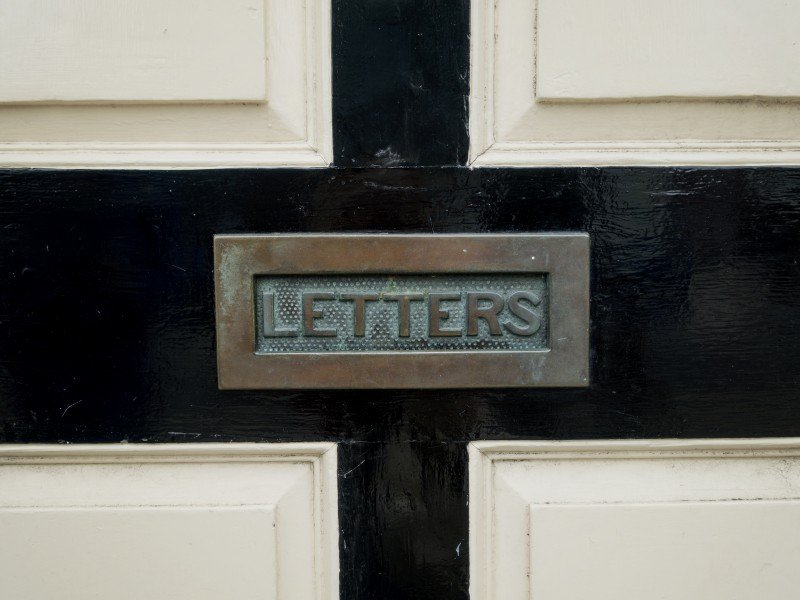
Today’s guest post is from Elise Holland, co-founder and editor of 2 Elizabeths , a short fiction and poetry publication.
When submitting your short-form literature to a magazine or journal, your cover letter is often the first piece of writing an editor sees. It serves as an introduction to your thoughtfully crafted art. As such, it is significant, but it shouldn’t be intimidating or even take much time to write.
As editor at 2 Elizabeths , I see a variety of cover letters every day; some are excellent, and others could stand to be improved. There are a few key pieces of information to include, while keeping them short and sweet. In fact, a cover letter should only be a couple of paragraphs long, and no more than roughly 100-150 words.
A little research goes a long way
Seek out the editor’s name, and address the letter to him/her, as opposed to using a generic greeting. Typically, you can find this information either on the magazine or journal’s website, or in the submission guidelines.
Read the submission guidelines thoroughly. Many publications will state in their guidelines the exact details that need to be included in a cover letter. With some variation, a general rule of thumb is to include the following:
- Editor’s name (if you can locate it)
- Genre/category
- Brief description of your piece
- If you have been published previously, state where
- Whether your piece is a simultaneous submission (definition below)
Terms to Know
The term simultaneous submission means that you will be sending the same piece to several literary magazines or journals at the same time. Most publications accept simultaneous submissions, but some do not. If a publication does not accept them, this will be stated in their guidelines.
Should your work be selected for publication by one magazine, it is important to notify other publications where you have submitted that piece. This courtesy will prevent complications, and will keep you in good graces with various editors, should you wish to submit to them again in the future.
The term multiple submission means that you are submitting multiple pieces to the same literary magazine or journal.
Cover Letter That Needs Work
Dear Editor, Here is a collection of poems I wrote that I’d like you to consider. I have not yet been published elsewhere. Please let me know what you think. Bio: John Doe is an Insurance Agent by day and a writer by night, living in Ten Buck Two. He is the author of a personal blog, LivingWith20Cats.com. Best, John Doe
What Went Wrong?
John Doe didn’t research the editor’s name. A personal greeting is always better than a simple “Dear Editor.” Additionally, John failed to include the word count, title and a brief description of his work.
There is no need to state that John has not yet been published elsewhere. He should simply leave that piece of information out. (Many publications, 2 Elizabeths included, will still welcome your submissions warmly if you are unpublished.)
John included a statement asking the editor to let him know what he/she thinks about his work. Due to time constraints, it is rare that an editor sends feedback unless work is going to be accepted.
Unless otherwise specified by the magazine or journal to which you are submitting, you do not need to include biographical information in your cover letter. Typically, that information is either requested upfront but in a separate document from the cover letter, or is not requested until a piece has been selected for publishing.
Cover Letter Ready to Be Sent
Dear Elise, Please consider this 1,457-word short fiction piece, “Summer.” I recently participated in the 2 Elizabeths Open Mic Night, and am an avid reader of the fiction and poetry that you publish. “Summer” is a fictitious tale inspired by the impact of a whirlwind, yet meaningful, romance I experienced last year. In this story, I gently explore the life lessons associated with young love, with a touch of humor. This is a simultaneous submission, and I will notify you if the piece is accepted elsewhere. Thank you for your consideration. Kindest Regards, John Doe
What Went Right?
In this letter, John includes all pertinent information, while keeping his letter clear and concise. In his second sentence, John also briefly states how he is familiar with the magazine. While doing this isn’t required, if done tastefully, it can be a nice touch! Another example might be: “I read and enjoyed your spring issue, and believe that my work is a good fit for your magazine.”
I hope these sample letters help you as you send your short works to magazines and journals for consideration. While you’re at it, I hope you will check out 2 Elizabeths ! We would love to read your work.
Elise Holland is co-founder and editor of 2 Elizabeths , a short fiction and poetry publication. Her work has appeared in various publications, most recently in Story a Day . Through 2 Elizabeths, Elise strives to create value and visibility for writers, through writing contests , events , and more!
This site uses Akismet to reduce spam. Learn how your comment data is processed .

[…] view post at https://janefriedman.com/perfect-cover-letter-advice-lit-mag-editor/ […]
[…] To get into literary magazines, you need a cover letter, so Elise Holland lays out how to write the perfect cover letter for a literary magazine. […]
Love this! The letter is short and to the point, and covers all the necessary information. Great tips! I always worry that the only publishing credit I have is the winning entry in a short story contest through the local paper. Should I mention that? And writing conferences I’ve attended?

As Elise says, it’s OK if you’re unpublished. Don’t worry about it. But feel free to mention your winning entry. If the writing conferences would likely be known to the journals’ editors, you might mention one or two.
[…] recently wrote a full article on the perfect cover letter, here. Check it out for clear, simple instructions, along with sample […]
[…] publication. Her work has appeared in various publications, most recently in Story a Day, and at JaneFriedman.com. Through 2 Elizabeths, Elise strives to create value and visibility for writers, through writing […]
Thanks for the concise and useful information! I’ve heard that it’s also a good idea to include a sentence or two that makes it clear that you are familiar with the kind of work the magazine has published in the past. Is this generally advised, or would you consider it nonessential unless specified in the submission guidelines?
- Career Advice
How to Write a Successful Cover Letter
By Victoria Reyes
You have / 5 articles left. Sign up for a free account or log in.
Istockphoto.com/bsd555
Sociologist Andrew Whitehead started a Twitter thread some months ago detailing his take on various stages of the academic job market. For the cover letter, he gave excellent advice . He suggested among other things, keeping it at a suggested length (one and a half to two pages) and avoiding jargon. He also stressed the importance of strong lead sentences, using the cover letter to highlight and point to other parts of your application, and controlling the narrative you want to tell .
Others have also written about writing a cover letter. Cheryl E. Ball, for example, provides excellent advice and a paragraph-by-paragraph breakdown . Indeed, a simple Google search on “how to write an academic cover letter” brings back 49,600 results if the clause is in quotations, and 526 million results without quotations.
I want to build on the foundational advice of those before me and provide additional insight into the purpose of a cover letter, tips for writing a successful one and what to avoid in it. At the very least, I find having multiple perspectives, styles of writing and exposure to different ways of thinking about the same topic to be useful.
This essay draws on an invited prep talk on how to write a cover letter that I gave at the 2019 American Sociological Association’s annual meeting and on my own experience as a job applicant and as a faculty member on search committees. It’s meant to be helpful for those new on the job market, as the following advice may seem obvious to those who have been in academe for a while.
The first thing that Ph.D. students need to remember about the academic cover letter is its purpose: to introduce who you are as a scholar, what you would bring to the department as a potential colleague and how you fit the requirements listed in the advertisement. The cover letter may be the first thing search committee members see, alongside the CV, so you want to make sure that it captures their attention in a good way.
Here are some tips that I hope you’ll find helpful.
Don’t assume knowledge on the part of the reader. Don’t presuppose that faculty members are reading your application holistically, or that if you mentioned something in a research statement, you won’t have to repeat it in the cover letter. As Whitehead suggests, you should walk your reader through the narrative you want to tell of who you are as a scholar. For example, what is it you study? Are you a scholar of globalization? Social movements? Race? What is the overarching question your research addresses? Even if the content of your publications covers particular topics, and it seems obvious to you who you are as a scholar, you need to specify in your cover letter what it is you study. Take the lead in shaping the narrative of you who are. If you don’t, others will.
Another aspect of not assuming knowledge on the part of the reader means that you need to be explicit, stating what you think is obvious -- because what is obvious to you is not always obvious to the reader. For example, although your dissertation may use qualitative methods, you may be able to teach undergraduate statistics. But you decide not to say in your cover letter that you are able to teach that class because you assume that anyone who has a Ph.D. in sociology could do so. However, that assumption would be incorrect, and the search committee will not know that you can, and want, to teach undergrad statistics unless you say that explicitly in your cover letter and teaching statement.
Tailor your letter. As others, like Karen Kelsky, have written , do your research on the institution and department behind the ad. Take care to understand and communicate how you fit with a given department and how you and your work connect to departmental activities and communities across the college or university. That means elaborating on your approach to teaching for a liberal arts college, for example, and demonstrating what your publications and research can specifically bring to a research university.
Tailoring your letter also means tailoring it to the job ad, remembering to be as explicit as you can about how you fit the listed requirements. If the job ad states that the position is for someone who studies religion, for example, say you study religion. Additionally, show how your broader research agenda ties to religion in some way. My department is currently hiring in organizations and institutions, and successful applicants clearly state they are scholars that study these areas. More important, the most successful applicants demonstrate that they are primarily interested in expanding theoretical knowledge about organizations and institutions more generally, rather than being theoretically interested in a different topic that happens to take place within an organization.
Something I didn’t realize until I was on the faculty side of hiring is that the areas of specialization asked for in the ad, other than those few open hires that call for anyone in any specialization to apply, are often tied to holes in the curriculum. So, for instance, at my institution, an applicant who demonstrates a teaching record related to organizations and institutions is the strongest, while a desire to teach -- with no prior record -- is slightly less ideal but still a potentially strong applicant. Someone who does not explicitly state their experience or their desire to teach in organizations and institutions is not as strong a candidate. The search committee only knows what you write down in your materials, so be sure to mention the obvious!
Write as a potential colleague rather than as a graduate student. When you write about your research, focus on your arguments and contributions rather than simply describing the details of your specific study. That demonstrates you’ve shifted to being a producer of knowledge who knows how your research fits into the broader field. Another way to write as a potential colleague, rather than as a graduate student, is to discuss how you see yourself fitting into, and contributing to, the department, college and university. That means doing your homework and seeing what centers and institutions are on the campus, as well as any workshops, symposia or other events that occur in your department and how you could contribute or add to those ventures. This involves a transition to seeing yourself as someone who is a useful resource that brings something to the academic table.
Write fact-based statements that highlight your accomplishments, including publications, awards, fellowships and teaching. It is not bragging or self-promotion to say that you’ve received an award or fellowship. It’s a statement of fact. For example, saying that you’ve won a teaching or mentoring award is evidence of excellence in teaching or mentoring. That is different than adjective-filled comments that talk about your “passion for teaching,” for example. Fact-based statements that highlight your accomplishments show , rather than tell, the reader of your commitment. Of course, you could still say you are passionate about teaching. Just follow it up with a sentence that provides concrete evidence or data that supports your claim -- such as a teaching award.
Be clear and concise. Write short, declarative sentences. Do not write long, complicated sentences, as your point may get lost in the details.
Here are a few things to avoid when writing a cover letter.
Excessive detail. Don’t try to describe each and every paper you’ve written in the cover letter. Instead, highlight one or two given papers and discuss their arguments and significance. Also, don’t give a detailed description of how your paper fits into the existing literature. That is appropriate for an article but not a cover letter, because it takes up too much space that could be better used to highlight your own accomplishments rather than others’ arguments. To be sure, you can gesture to how it fits into the existing literature, but limit it to just a short sentence or two. You should not write a whole paragraph on the intricacies of the subfield.
Jargon. Similar to what Verena Hutter and Kelsky write, be sure to avoid jargon and clichés . Remember that members of the search committee are likely not in your subfield. Translating your research for a general audience means getting rid of the jargon, or at the very least, defining the jargon you use. While each subfield’s jargon differs, think about whether a certain concept or word is familiar to an educated lay audience. If not, then it is important to try to explain your work without using the jargon.
For example, if you are dedicated to feminist praxis, talk about your commitment to both feminism and putting theory in action in lay terms, and/or define what you mean by “feminist praxis” -- particularly if you are applying to a department other than gender studies or related subfields. That said, avoiding jargon means knowing your audience, as it depends on the discipline and subfield. For example, writing that you are committed to feminist praxis may not be jargon in a gender studies department. In contrast, writing that you are committed to having students discover their “sociological imagination” may be jargon for gender studies but is a taken-for-granted concept across subfields within sociology.
Hyperbole. As previously mentioned, stick to fact-based statements that highlight your accomplishments. Remember you are probably competing with hundreds of applicants, many of whom have competitive records and accomplishments. So saying something such as “I am uniquely qualified to fill the position” is very likely to be untrue.
The three things to avoid that I mention above are common mistakes that signal someone who is still positioning themselves as a grad student, not a colleague, and thus, someone who may not be ready for a faculty job. That is a tricky but extremely important transition to make. It requires walking a delicate line between drawing on and acknowledging the work that senior scholars have done in the field and being confident enough to know you have something to contribute.

Changing the Needs Conversation: Taking the Shame out of Getting Something to Eat
Students with food insecurity often feel shame in seeking assistance, but taking three actions can help reduce and re
Share This Article
More from career advice.
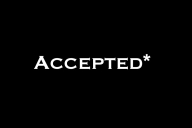
Let’s Finally Tackle the Problem of Pay Inequity
Higher ed must go beyond buzz words and stop hiding behind performative equity, which does not create change, w

The Problem With Participation Grades (and How To Solve It)
The benefits are well documented but the practice can be subjective and prone to instructor biases, warns Anna Broadb

Ensuring International Students’ Career Success
Sherry Wang and Merab Mushfiq offer several strategies to help international students overcome the challenges their N
- Become a Member
- Sign up for Newsletters
- Learning & Assessment
- Diversity & Equity
- Career Development
- Labor & Unionization
- Shared Governance
- Academic Freedom
- Books & Publishing
- Financial Aid
- Residential Life
- Free Speech
- Physical & Mental Health
- Race & Ethnicity
- Sex & Gender
- Socioeconomics
- Traditional-Age
- Adult & Post-Traditional
- Teaching & Learning
- Artificial Intelligence
- Digital Publishing
- Data Analytics
- Administrative Tech
- Alternative Credentials
- Financial Health
- Cost-Cutting
- Revenue Strategies
- Academic Programs
- Physical Campuses
- Mergers & Collaboration
- Fundraising
- Research Universities
- Regional Public Universities
- Community Colleges
- Private Nonprofit Colleges
- Minority-Serving Institutions
- Religious Colleges
- Women's Colleges
- Specialized Colleges
- For-Profit Colleges
- Executive Leadership
- Trustees & Regents
- State Oversight
- Accreditation
- Politics & Elections
- Supreme Court
- Student Aid Policy
- Science & Research Policy
- State Policy
- Colleges & Localities
- Employee Satisfaction
- Remote & Flexible Work
- Staff Issues
- Study Abroad
- International Students in U.S.
- U.S. Colleges in the World
- Intellectual Affairs
- Seeking a Faculty Job
- Advancing in the Faculty
- Seeking an Administrative Job
- Advancing as an Administrator
- Beyond Transfer
- Call to Action
- Confessions of a Community College Dean
- Higher Ed Gamma
- Higher Ed Policy
- Just Explain It to Me!
- Just Visiting
- Law, Policy—and IT?
- Leadership & StratEDgy
- Leadership in Higher Education
- Learning Innovation
- Online: Trending Now
- Resident Scholar
- University of Venus
- Student Voice
- Academic Life
- Health & Wellness
- The College Experience
- Life After College
- Academic Minute
- Weekly Wisdom
- Reports & Data
- Quick Takes
- Advertising & Marketing
- Consulting Services
- Data & Insights
- Hiring & Jobs
- Event Partnerships
4 /5 Articles remaining this month.

Sign up for a free account or log in.
- Create Free Account
12 Writer Cover Letter Examples
Writers excel at weaving words into captivating stories, painting vivid pictures with their prose, and engaging readers with their narrative. Similarly, your cover letter is your chance to craft a compelling narrative about your professional journey, using your words to captivate recruiters and paint a vivid picture of your skills and experiences. In this guide, we'll explore outstanding Writer cover letter examples to help you pen your own captivating professional story.

Cover Letter Examples
Cover letter guidelines, writer cover letter example, senior writer cover letter example, freelance writer cover letter example, creative writer cover letter example, ux writer cover letter example, blog writer cover letter example, curriculum writer cover letter example, proposal writer cover letter example, resume writer cover letter example, grant writer cover letter example, staff writer cover letter example, contributing writer cover letter example, how to format a writer cover letter, cover letter header, what to focus on with your cover letter header:, cover letter header examples for writer, cover letter greeting, get your cover letter greeting right:, cover letter greeting examples for writer, cover letter introduction, what to focus on with your cover letter intro:, cover letter intro examples for writer, cover letter body, cover letter body examples for writer, cover letter closing, what to focus on with your cover letter closing:, cover letter closing paragraph examples for writer, pair your cover letter with a foundational resume, cover letter writing tips for writers, showcase your writing skills, personalize your letter, highlight relevant experience, keep it brief, proofread thoroughly, cover letter mistakes to avoid as a writer, overloading with information, using generic language, not tailoring the letter to the job, ignoring the company's culture, not proofreading, cover letter faqs for writers.
The best way to start a Writer cover letter is with a compelling hook that grabs the reader's attention. This could be a brief anecdote about a writing achievement, a unique perspective you bring to your work, or a notable publication where your work has been featured. Follow this with a clear statement of your intent, such as the specific role you're applying for. Remember to address the letter to the appropriate person, if their name is available. This personalized and engaging approach will help you stand out from other applicants.
Writers should end a cover letter by summarizing their interest in the position and expressing gratitude for the reader's time. They should reiterate their unique skills or experiences that make them a good fit for the role. It's also important to include a call to action, such as a request for an interview or a meeting. The closing should be professional and polite. Here's an example: "I am excited about the opportunity to bring my unique storytelling skills to your team and I am confident that I can contribute to your editorial goals. Thank you for considering my application. I look forward to the possibility of discussing this opportunity with you further." Finally, they should sign off with a professional closing like "Sincerely" or "Best regards," followed by their full name.
A writer's cover letter should ideally be one page long. This is because the purpose of a cover letter is to provide a brief introduction of yourself and to explain the reasons for your interest in the specific position or organization. It's important to be concise and to the point, while effectively communicating your skills, experiences, and why you would be a good fit for the role. A one-page cover letter is usually sufficient to achieve this. If it's too long, there's a risk that the hiring manager might not read the entire letter, and if it's too short, it might not provide enough information about your qualifications.
Writing a cover letter with no experience as a writer can seem daunting, but it's important to remember that everyone starts somewhere. Here's a step-by-step guide on how to approach it: 1. Start with a strong introduction: Begin your cover letter by introducing yourself and stating the position you're applying for. Make sure to grab the reader's attention with your enthusiasm for the role and the company. 2. Highlight your relevant skills: Even if you don't have direct writing experience, you likely have other skills that are relevant. Perhaps you have strong research skills, creativity, or a knack for storytelling. Maybe you've written blog posts, social media content, or academic papers. All of these can be valuable in a writing role, so be sure to highlight them. 3. Showcase your knowledge about the company: Show that you've done your homework about the company and the industry. This can demonstrate your interest and your initiative, both of which are attractive qualities in a potential hire. 4. Discuss your education: If you've taken any writing-related courses or earned a degree in a related field (like English, journalism, or communications), be sure to mention it. Even if your education isn't directly related, discuss how it's helped you develop valuable skills. 5. Provide examples: Use specific examples to demonstrate your skills. For instance, if you're applying for a content writing role, you might discuss a time when you wrote a well-received research paper or a blog post. 6. Show your passion: Passion can often make up for a lack of experience. If you're passionate about writing, make sure that comes across in your cover letter. 7. Close with a strong conclusion: Wrap up your cover letter by reiterating your interest in the role and your eagerness to contribute to the company. Thank the reader for considering your application and express your hope for further discussion. 8. Proofread: This is especially important for a writing role. Make sure your cover letter is free of typos and grammatical errors. Remember, everyone has to start somewhere. Even if you don't have professional writing experience, your unique skills and perspectives can still make you a strong candidate. Good luck!
Related Cover Letters for Writers
Content writer cover letter.

Copywriter Cover Letter

Editor Cover Letter

Journalist Cover Letter

Technical Writer Cover Letter

Digital Marketing Specialist Cover Letter

Writer Cover Letter

Senior Writer Cover Letter
Freelance writer cover letter, creative writer cover letter, ux writer cover letter, blog writer cover letter, curriculum writer cover letter, proposal writer cover letter, resume writer cover letter, grant writer cover letter, staff writer cover letter, contributing writer cover letter, related resumes for writers, writer resume example.

Try our AI-Powered Resume Builder

How To Write A Killer Cover Letter to Publishers
May 20, 2015
A cover letter introduces you and your novel to potential publishers . This letter is your first point of contact between you and a publisher, therefore, it is crucial that aspiring authors know how to write a decent cover letter.
Here are three common questions, answered for writers looking to pave a successful path into the world of publishing with a cover letter that leaves an impression…

What do I need?
1. an ‘elevator pitch’ and hook.
An ‘elevator pitch’ is a brief and punchy summary of your novel that could be told to someone important between floors of a short elevator ride. Condense the core ideas of your novel in a dynamic and enthusiastic couple of sentences.
Remember that your cover letter should be no longer than a page, so this section can only take a up a paragraph or two. Show them why it’s worth reading and be sure to include a ‘hook’ – something that drags your reader into the story, and has them dying to know what happens next.
2. A target audience
Outline your target audience to publishers and demonstrate an alignment to their publishing vision . A good way to start is by looking at previous novels they have published and whether these books fall in the same category as yours, and share a target audience.
Remember to be specific; publishers need more information than ‘Adult’. Include your audience’s age group, interests etc. if applicable.
3. Novel titles comparable to yours
Give two titles comparable to your novel (even better if they’re published by the publisher you’re reaching out to). This is a great way to establish direct relevance and relation to potential publishers.
More than that, it gives them an idea of where your novel will sit in the marketplace and how it will work with their existing list.

4. A word count
This is a simple and necessary inclusion to let publishers know how long your novel is.
5. A killer author bio
Be interesting, be readable and draw publishers in with who you are and what you intend to do with your work.
Here is also the place to list existing publishing credentials, and relevant education such as writing courses or degrees. You want to be able to get publishers to see that you are a capable, focused and passionate writer.
6. Contact details
Give yourself the opportunity to be contacted if the publishers decide to get in touch for further questions or discussions. Include your phone number, address and most importantly, your email address.
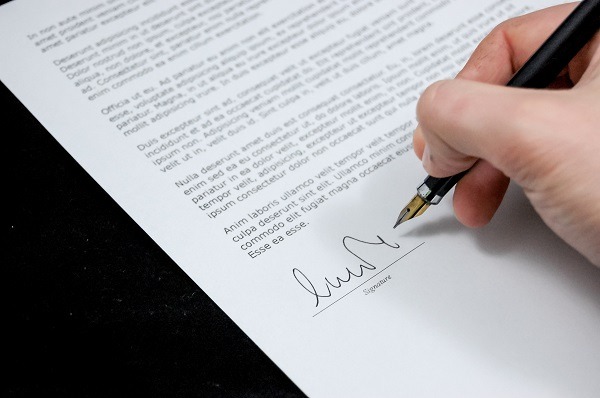
How do I put it together?
Put the above elements together in an easy-to-read, simple form. Keep sentences short, purposeful and in an active voice. The desired length of your letter should no longer than a page. Opt for 12pt standard font such as Times New Roman, and 1.5 spacing.
Many new authors make the mistake of attempting to detail their background, life achievements and a lengthy breakdown of their novel. Long, unnecessary paragraphs will irritate the editor, and an irritated submissions editor is not someone you want reading your life’s work and deciding its future.
In addition to being concise, remember to keep it error-free. Creatively written content may help you stand out, but keep in mind that your letter is still a business proposal.
It also goes without saying that a successful pitch leaves no room for error, so before you click send, proofread it again and again. Better still, have other writer friends review it and provide you with feedback.

Do I include my manuscript?
Always follow the publisher’s submission guidelines. These guidelines are usually accessible on publisher’s website. The most common request is to include the first three chapters. In addition, you might also be asked for a synopsis (usually no longer than 300 words).
We cannot stress enough the importance of adhering to the guidelines. This shows that you care about the publisher’s work as well as yours.
Some other useful tips
- Address your cover letter by name. Avoid clichés such as ‘Dear sir/madam’ or ‘To whom it may concern’. It is more genuine and respectful.
- Use more formal language throughout the letter.
- Have a logical and readable structure.
- Thank the publisher for their time.
- Sign off gracefully – e.g. ‘Yours sincerely’ – before your name.
With these tips, you’re good to go!
This post was written by Natalie Ong Lih Tyng
Carmel JOYCE
Hello A cover letter introduces you and your novel to potential publishers. This letter is your first point of contact between you and a publisher, therefore, it is crucial that aspiring authors know how – “to” – write a decent cover letter.
Could you please correct the first sentence on this web page? I was told once that my emails, no matter how appealing, would be rejected because of a spelling mistake or a sentence that was not constructed correctly. I can not be a member of AWG as I do not have any credits for my drama script writing. I can not gain a credit until my work is accepted. How do I attract Australian publishers with Australian/British drama scripts without credits?
Claire Bradshaw
Thanks for pointing that out – things do slip through the cracks sometimes, but the sentence is fixed now!
As for your submissions: generally, book publishers won’t accept unsolicited submissions of play scripts or screenplays, no matter whether you’re a member of AWG or not. We’d recommend looking into more specific submission opportunities, such as Australian Plays ( https://australianplays.org/about/submissions ), and also visiting sites like Playwriting Australia ( http://www.pwa.org.au ) for more information and opportunities.
You might also like to purchase a subscription to the Australian Writer’s Marketplace ( https://www.awmonline.com.au ), which has a comprehensive directory that includes opportunities for plays/theatre and screenplays.
Best of luck with your writing.
Is it possible to have an example of a submission letter? Even if something general. Cheers!
Here’s a site with a list of examples of successful cover/query letters from different genres: http://www.adweek.com/galleycat/successful-query-letters-for-literary-agents/63594
Hope this helps!
Kathy Steinemann
Thanks, Claire.
Your third point highlights how important (and time-consuming) advance research is. A writer might have to read several novels to find two comparable titles.
Glad you enjoyed Natalie’s post! Definitely agree that research can take up a lot of a writer’s time – definitely worth it, though, if it improves your cover letter in the end!
Comments are closed.
- Inspiration
Explore Jobs
- Jobs Near Me
- Remote Jobs
- Full Time Jobs
- Part Time Jobs
- Entry Level Jobs
- Work From Home Jobs
Find Specific Jobs
- $15 Per Hour Jobs
- $20 Per Hour Jobs
- Hiring Immediately Jobs
- High School Jobs
- H1b Visa Jobs
Explore Careers
- Business And Financial
- Architecture And Engineering
- Computer And Mathematical
Explore Professions
- What They Do
- Certifications
- Demographics
Best Companies
- Health Care
- Fortune 500
Explore Companies
- CEO And Executies
- Resume Builder
- Career Advice
- Explore Majors
- Questions And Answers
- Interview Questions
How To Write A Cover Letter For A Job In 2023 (With Examples)
- How To Write A Cover Letter
- When Is A Cover Letter Necessary
Free Cover Letter Templates
- Cover Letter Mistakes To Avoid
- Cover Letter Tips
- How To Sell Yourself In A Cover Letter
Find a Job You Really Want In
Cover letters aren’t required with every application, but the majority of managers pay more attention to a candidate who includes a cover letter. This is especially so if you make an effort to tailor your letter to the specific position. It’s important not to just change the names and job positions, but also to show how your professional experience fits with the job.
A good cover letter greatly increases your chance of getting an interview. If you’re looking to write a cover letter, rework a letter that you have, or just want to know what’s involved in the job application process, then keep reading.
Key Takeaways:
A cover letter should be a maximum of one page long, with three to five paragraphs.
Before writing your cover letter, it’s important to reread the job description and include keywords from it.
Do research to figure out who you are addressing, and make sure to keep your greeting gender neutral if you don’t know.
Tailoring your resume to each job can help you stand out from other candidates.
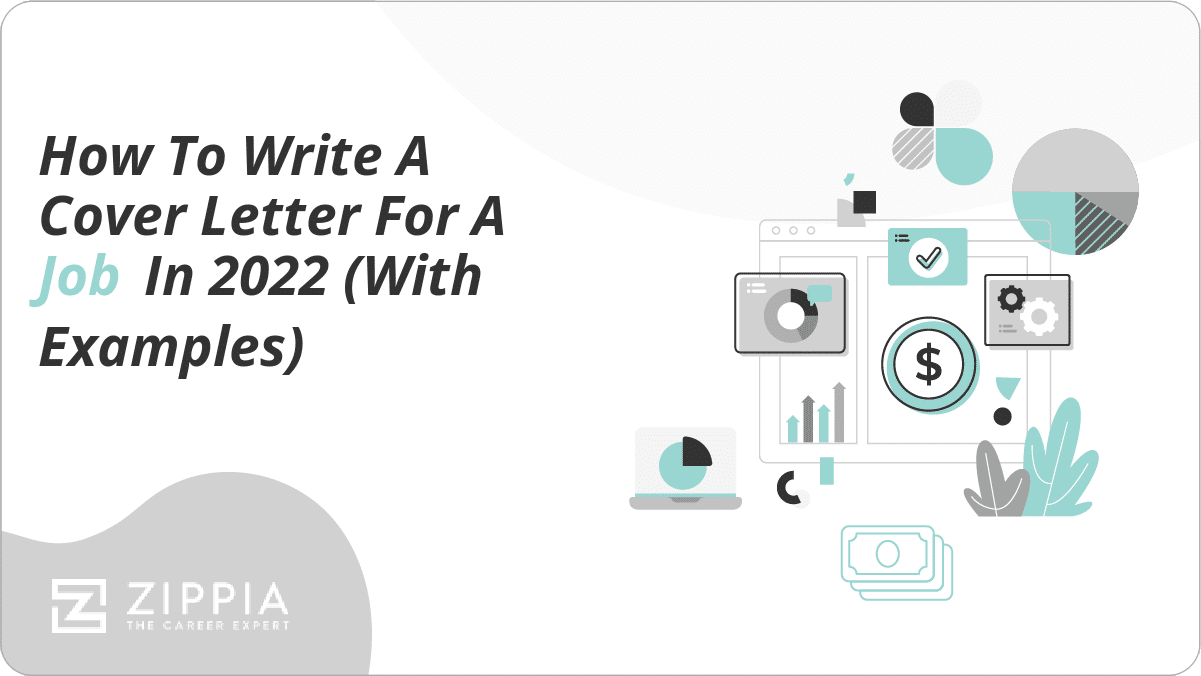
What is a cover letter?
Why cover letters are important, how to write a cover letter, cover letter examples, cover letter template, do’s and don’ts in a cover letter, cover letter faq, expert opinion.
- Sign Up For More Advice and Jobs
A cover letter is a one-page document that describes your professional background, fitness for the role, and interest in the company. Cover letters are a way of introducing yourself to hiring managers in a more engaging way than resumes can.
While your resume spells out the “who, what, where, when” of your relevant experience, a cover letter fills in the “why” and “how.” A good cover letter not only expands on your resume’s accomplishments but also highlights the soft skills that make you an excellent person to work alongside.
While there are no official formatting guidelines for cover letters, hiring managers and recruiters do have certain expectations regarding structure, length, and content.
Writing a good cover letter is important because it is your chance to stand out from other potential candidates. Showing your personality while also matching the tone of the company will help recruiters to visualize how you could fit into the role.
Simply submitting a cover letter isn’t enough though. Each cover letter you write should be specifically tailored to the job you’re applying for (just like resumes). It’s essential that you show the reader that you’ve done your homework and understand exactly what function you’d be serving if hired. You do that by providing examples of past work experiences that directly relate to the responsibilities of the new job.
Cover letters are inherently unique based on who’s writing them and for what position. However, as a cover letter is a business letter, it has an expected format that it should follow. This is important because you want the hiring manager to be able to look over your cover letter quickly and understand your qualifications and interest in the position.
Here’s the standard way that a cover letter should be formatted and what to include:
The header. The header of your letter is where you should input all of the contact information for yourself and the hiring manager . Do you best to address it directly to the person who’ll be reading the letter — typically either the hiring manager or HR manager.
Traditionally, you should include both your name and address and the employer’s name and address. However, as the majority of applications are online, the employer’s address is often omitted. But a traditional cover letter’s heading would look like this:
Page Roman 444 Frog Rd. Marigold, TX, 10987 August 27th, 2021 Chris Morgan Marketing Manager New Media Company 833 Rune Rd. Marigold, TX, 10987
If you’re emailing your cover letter, you can simply include your name, telephone number, email address, and fewer address details (just your city and state will suffice). You can also include a zip code if you live in a big city with multiple zip codes.
Jessica Dancer jessica. dancer @email.email | (555)-444-3333 | Colombus, OH 43110
Be sure to use a professional-sounding email address that’s not associated with your current or past employer. It’s disrespectful to both your current employer and the company you’re applying to, and will likely hurt your chances of being invited for an interview.
The greeting or salutation. Traditionally, the best salutation would be to use Dear Mr./Ms. [Last Name]. Make sure that you know the person’s gender when doing this, however, as you don’t want to misgender the hiring manager. Using “Dear [First Name] [Last Name]” is becoming more popular for this reason, patriotically among younger workers.
Dear Mr. Morgan, Dear Mrs. Smith Dear Ms. Conner
Avoid using generic greetings such as “To whom it may concern” as it’ll look like you didn’t bother to personalize the letter (even if you did.) That particular phrase has become somewhat controversial as well, so if you need to put a generic address — if you can’t find the hiring manager’s name, for instance — use something else, such as:
Dear Hiring Manager Dear [Department] Manager Dear [Title of the Person You’d Report to if Hired] Dear [Department] Hiring Team
Opening paragraph. The opening of your professional cover letter should instantly grab the attention of your reader . Try to lead off with one of your most relevant and impressive accomplishments.
Open strong . Open with a statement other than your name or stating your interest in the position. Lead with an interesting experience or achievement that directly relates to the new position.
Convey your personal value. There are always other qualified applicants with similar skills, so it is key to express why you personally would bring value to the organization. Give specific details as to the value you brought in a previous position, and how that could transfer to the new role.
Show your enthusiasm. Recruiters want to hire candidates who are excited about the position. Express enthusiasm and convey why you are passionate about the role. This is another opportunity to share a quick personal anecdote related to the job.
Keep it short. All of these points in your opening paragraph shouldn’t be more than a sentence or two each. You don’t want your introduction to be too long, as you want the reader to be able to quickly go through your cover letter.
As a Content Writer with a passion for travel and literature, I was thrilled to see the Senior Content Writer position open up at BookFly. My past experience driving organic traffic by 23% YoY to the travel website, XTravel, would translate perfectly into the position’s stated goals from the job description.
First body paragraph. Here is where you should really sell yourself across several areas. Showcase how your personality traits, such as being honest or having the ability to work under pressure, make you a good fit.
Emphasize transferable skills. Explain how the skills you’ve cultivated make you the perfect fit for the role. This can include collaborative work you’ve done in the past, a leadership role you had that drove results, or interpersonal skills.
Revisit the job description. Make sure to pull relevant skills from the job description and put them in your cover letter. If the hiring manager spent the time to list those skills, they’re going to be looking for candidates that have them.
It also helps with applicant tracking systems that may sift through cover letters looking for keywords.
Don’t skimp on personality traits. These are especially important if you don’t have a lot of experience. Desirable skills such as ambition, dedication, and getting work done on time are good for both entry-level positions and if you’re making a career change.
I have a passion for content creation and a deep understanding of the content cycle, from ideation to promotion. My years in the digital publishing world have crafted my ability to drive killer CTR and resonate with an audience. Not only did CTR jump by 2.1% in the months after I was brought on board, but it had a knock-on effect on social media engagement, which rose by 8% in the same time frame. I believe good content has its roots in good data. This is why while at Media Company I created a content-marketing dashboard to highlight KPIs like those mentioned above. The dashboard allowed us to take advantage of wins more rapidly and avoid repeating losses.
Second body paragraph. Just as an employer wants to know why you’d want the role, they also want to know why you’d want to work at their company. Do your research and learn more about the core values of the company. Discuss how they align with your own.
Check the company’s website but also start to explore LinkedIn for greater insights. Employers want to make sure that you fit into the overall culture, and this is also something you should consider for yourself. However you feel you fit into the work culture, explain to the recruiter why. Paint a picture of how you’ll be better from the company, and how the company will also benefit.
I thrive in a fast-paced environment and excel at creating structures from scratch. I spearheaded our SEO efforts, developing workflows and systems to ramp up content production from zero. BookFly’s commitment to core values of “collaboration and imagination” aligns with my own preferred approach to tackling projects and dreaming of big ideas.
Closing. The closing of your letter is your final impression to the hiring manager, and therefore should clearly express your eagerness to take on the position. You don’t need to rehash all of the accomplishments and skills highlighted in previous sections. Consider this more of a statement of intent.
First, express gratitude that they took the time to consider you for the job by making it all the way through your letter. Then, quickly remind them of the benefits that you can bring to the role and company.
Finally, your closing should state a clear call-to-action (CTA) for the recruiter to take next, such as calling you to schedule an interview. Being confident and direct at the end of your cover letter helps to close the deal.
I look forward to learning more about how the Senior Content Writer operates within BookFly and the current content process. Thank you for taking the time to consider my application. Sincerely, Jessica Dancer
With thousands of cover letter templates on the internet, you want to make sure you choose the right one. Here’s a basic format of what a good cover letter will contain:
Jessica Dancer [email protected] | (555)-444-3333 | Colombus, OH 43110 Dear Mr. Morgan, As a Content Writer with a passion for travel and literature, I was thrilled to see the Senior Content Writer position open up at BookFly. My past experience driving organic traffic by 23% YoY to the travel website, XTravel, would translate perfectly into the position’s stated goals from the job description. I have a passion for content creation and a deep understanding of the content cycle, from ideation to promotion. My years in the digital publishing world have crafted my ability to drive killer CTR and resonate with an audience. Not only did CTR jump by 2.1% in the months after I was brought on board, but it had a knock-on effect on social media engagement, which rose by 8% in the same time frame. I believe good content has its roots in good data. This is why while at Media Company I created a content-marketing dashboard to highlight KPIs like those mentioned above. The dashboard allowed us to take advantage of wins more rapidly and avoid repeating losses. I thrive in a fast-paced environment and excel at creating structures from scratch. I spearheaded our SEO efforts, developing workflows and systems to ramp up content production from zero. BookFly’s commitment to core values of “collaboration and imagination” aligns with my own preferred approach to tackling projects and dreaming of big ideas. I look forward to learning more about how the Senior Content Writer operates within BookFly and the current content process. Thank you for taking the time to consider my application. Sincerely, Jessica Dancer
If you’re putting the cover letter in an email, you can omit putting the contact information at the top and instead include it below your signature. You want to make sure to include your name, phone number, and LinkedIn link, as well as a professional portfolio , if applicable.
Dear hiring manager: I am writing about the position of veterinary receptionist at Pet Care Clinic posted on indeed.com. I am a certified dog trainer with both Petsmart and Petco, allowing me insight into animal behavior. I’m also an aspiring novelist , making me a fast, experienced typist as well as adept with Microsoft Word and Apple Pages. Since I’ve worked at pet stores for several years, I am familiar with different kinds of animal and animal care, as well as building a rapport with pet owners. While I enjoy working with animals and my coworkers, I would like to move into a business where I can continue to learn and build on my experience. I would also like to work for a smaller business. Veterinary medicine has always interested me, and I very much enjoy learning new things. I’m eager to learn more about it in order to help customers make the best choices for their pets. I’ve always enjoyed working with animals, even before I was able to get a job that allowed me to. I grew up with dogs and cats, so I’m comfortable and familiar with their behavior. Being a pet owner myself, I’m able to understand what customers are looking for in a veterinary clinic and tailor the experience to their needs. Thank you for your time and I look forward to hearing from you. Sincerely, Michelle Bolivar Email: [email protected] Phone: (555) 545-9706
[your contact information] [date] Dear [Hiring Manager], I’m writing to apply for the open [position] at [company] that you posted [place job ad was found]. I believe that my [relevant experience] would be an excellent fit with [company name]. I have long been interested in [specific industry/department], and particularly your company because [why you’re interested in the company/awards they have won/accomplishments]. That experience and [relevant skills] that I’ve cultivated as a [current position] for [time worked in position or industry] will be an asset to the company as it’ll make me effective [at the job/particular aspect of the job]. The [responsibilities required in the job description] will be a [challenge/interesting task] and I look forward to making use of my [relevant skills]. I excel at [working with a team/working alone] and I want to use my expertise to further [company’s] success. I am excited about the possibilities this position holds, and I believe that my qualifications ensure I’d be an asset to your team. I look forward to being able to further discuss the details of the position and my qualifications with you in an interview. Please let me know if you require further information from me. Thank you for your time and I look forward to hearing from you. Sincerely, [Your name] [Your contact information (if it’s an email)
Knowing the proper format of a cover letter is the most important factor, of course, but there are some additional dos and don’ts that if you follow can make your cover letter better. It’s during the editing process, it’s important to go over and make sure that you haven’t made any common mistakes that’ll hurt your chances.
Here are 10 dos and don’ts for writing a good cover letter:
Do’s:
Do start by scanning the original job posting for keywords you can include in your letter.
Do be proud of your accomplishments and make sure to highlight them.
Do clearly express why you would be an asset to the organization.
Do tailor your cover letter to every hiring manager and position that you apply for.
Do try to find unique experiences, but make sure to always discuss measurable and relevant results.
Don’ts:
Don’t feel the need to lie about your skills or accomplishments. One of the worst mistakes to make is being caught in a lie.
Don’t copy and paste a template and only change your name and job titles. Recruiters will not see the value in a plug-in-play cover letter that has been used by multiple applicants.
Don’t forget to be direct and include a call to action.
Don’t make your cover letter too long. Similar to your resume, you want the reader to sum up who you are and get a quick explanation of why you’re a good fit.
Don’t forget to proofread. Grammatical errors on a cover letter and resume are a quick way to get your packet in the “no pile”.
What do you write in a cover letter?
In a cover letter, you should mostly write about impressive accomplishments from past jobs or academic experiences that relate to the job you’re applying for.
What is the purpose of cover letter?
The purpose of a cover letter is to help a hiring manager see why your background makes you suitable for the role in question. While a resume lists achievements, educational background , and skills , it doesn’t give the reader an idea of your actual expertise or personality.
A cover letter allows you to share your approach to work, as well as your ability to communicate your value effectively. A good cover letter makes it easy for a reader to think “I could imagine this person working for us.”
How do you write a simple cover letter?
To write a simple cover letter, start with the header and greeting we outlined above. Next, state your interest in the position (give the exact job title as listed in the job description) and mention your years of industry/job experience.
To keep your cover letter simple, you can now briefly mention in 1-2 sentences or 3-4 bullet points what parts of your background are most important for the hiring manager.
Finally, thank the reader for considering your application, and sign off as usual (e.g., “Sincerely, [full name]”).
What is the best way to start a cover letter?
The best way to start a cover letter is with an accomplishment that speaks directly to your ability to provide value for the company. Other good strategies include describing your long-standing passion for the field, mentioning an important reference at the company, or referring specifically to challenges the company is currently facing.
Do you introduce yourself in a cover letter?
No, you do not introduce yourself in a cover letter. By that we mean you do not say “My name is so-and-so” — you simply jump into your background and why you’re interested in the position.
Your name can be found at the bottom of the cover letter, as well as the header, your email address, and your resume, so there’s no need to force it awkwardly into your cover letter’s opening.
How do you end a cover letter?
To end a cover letter, thank the reader for their time and/or consideration, express enthusiasm for further correspondence and conversation, and sign off with a standard closing like “Sincerely.”
How long should a cover letter be?
A cover letter should be a maximum of one page long, with three to five paragraphs. Half a page is the shortest that your cover letter should be.
Harvard Business Review — How to Write a Cover Letter
University of Washington — Writing the Cover Letter
What’s a quick cover letter tip?

Michael Akbar Vice President Certified Professional Career Coach
Use your six seconds to show the employer in a tailored cover letter and resume that you understand their pain and will make their lives better if put in the position.
How useful was this post?
Click on a star to rate it!
Average rating / 5. Vote count:
No votes so far! Be the first to rate this post.

Chris Kolmar is a co-founder of Zippia and the editor-in-chief of the Zippia career advice blog. He has hired over 50 people in his career, been hired five times, and wants to help you land your next job. His research has been featured on the New York Times, Thrillist, VOX, The Atlantic, and a host of local news. More recently, he's been quoted on USA Today, BusinessInsider, and CNBC.
Matt Warzel a President of a resume writing firm (MJW Careers, LLC) with 15+ years of recruitment, outplacement, career coaching and resume writing experience. Matt is also a Certified Professional Resume Writer (CPRW) and Certified Internet Recruiter (CIR) with a Bachelor of Science in Business Administration (Marketing Focus) from John Carroll University.
Recent Job Searches
- Registered Nurse Jobs Resume Location
- Truck Driver Jobs Resume Location
- Call Center Representative Jobs Resume Location
- Customer Service Representative Jobs Resume
- Delivery Driver Jobs Resume Location
- Warehouse Worker Jobs Resume Location
- Account Executive Jobs Resume Location
- Sales Associate Jobs Resume Location
- Licensed Practical Nurse Jobs Resume Location
- Company Driver Jobs Resume
Related posts
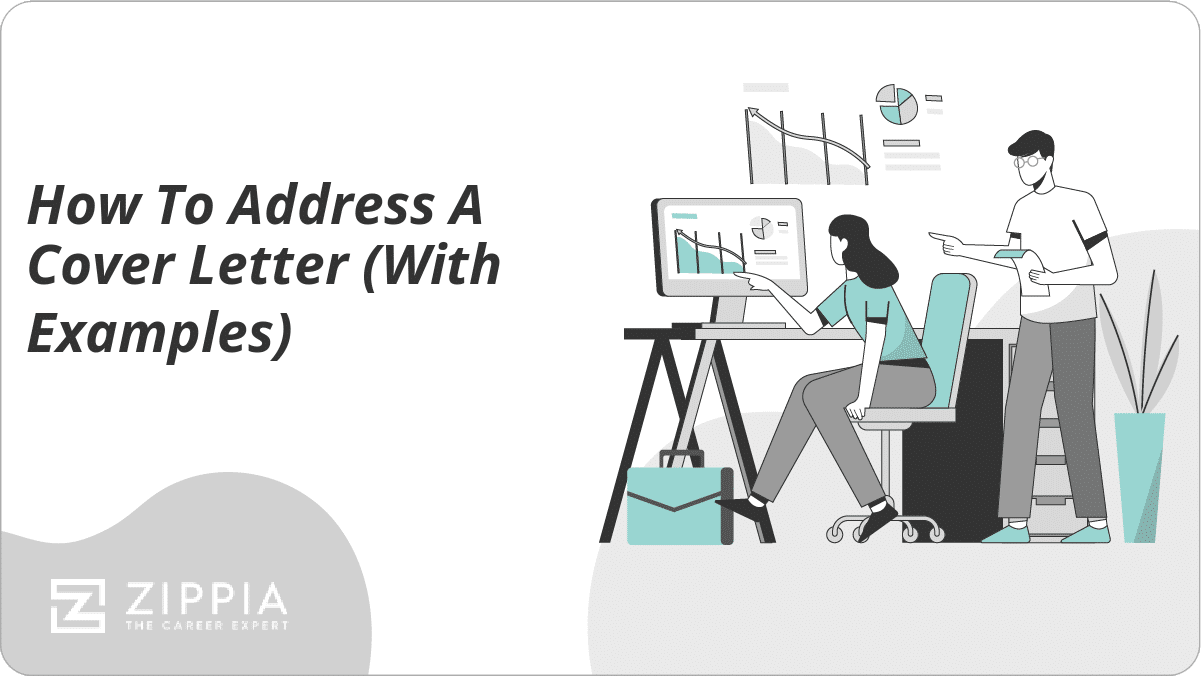
How To Address A Cover Letter (With Examples)

When Are Cover Letters Necessary (With Examples)
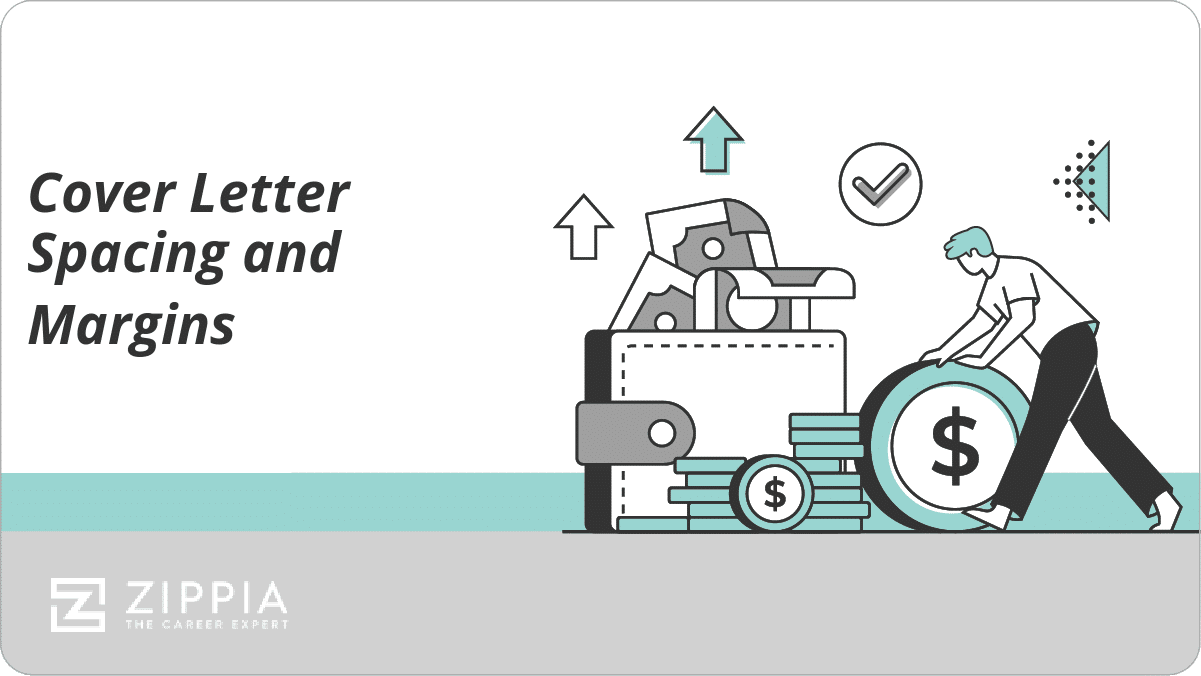
Cover Letter Spacing and Margins
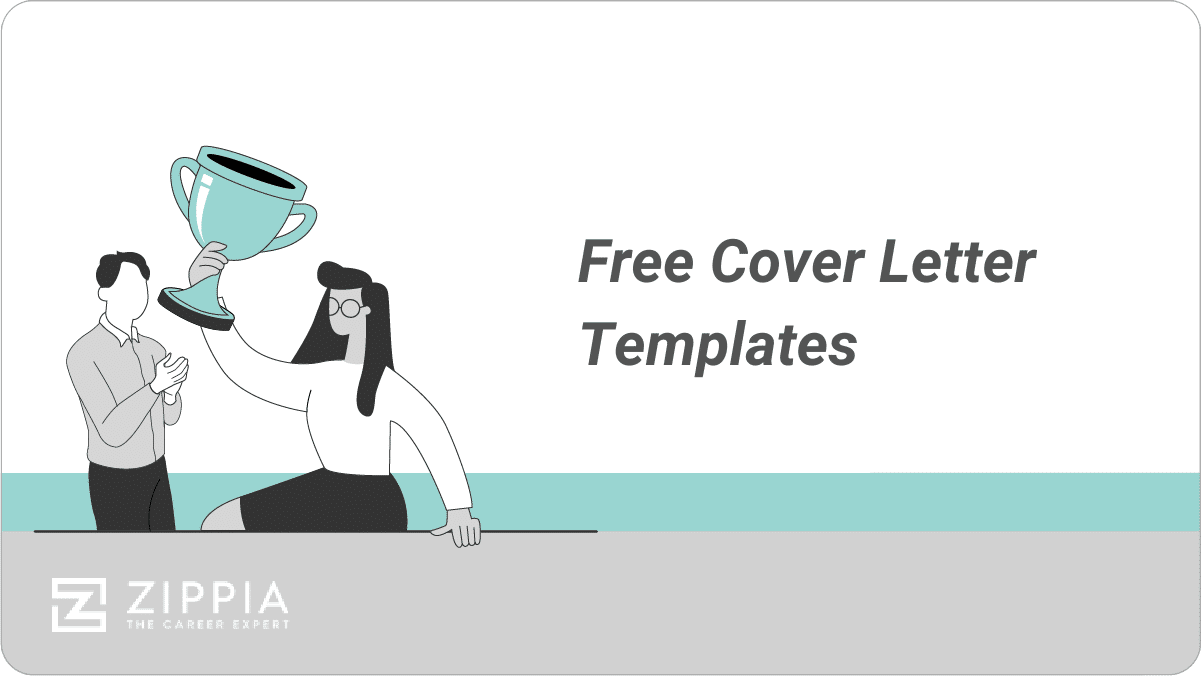
- Career Advice >
- Cover Letter >
How to Write a Cover Letter With No Experience (Examples Included!)

Writing a cover letter with no experience might feel like an intimidating task. The anxiety of facing a blank page—often with that inner voice whispering you may not be qualified enough—can indeed be paralyzing. But guess what? We’ve all been there, and trust me, you can do it too.
Everyone who has a job today started with no experience and had to write their first cover letter . Some of us even did it in a time when technology wasn’t around to help out (thankfully, things have changed!).
Need some guidance on writing yours? Here is everything you need to know to craft a cover letter with no experience, plus examples to guide you through the process.
What is a cover letter?
First things first: A cover letter is a document that you send to introduce yourself when applying for a job or internship. It complements your resume, providing more insight into who you are and the skills and qualifications that make you perfect for the role.
Think of it like a virtual handshake with the hiring manager. It’s your first interaction and your chance to quickly introduce yourself to secure an interview. Together with your resume , the cover letter is your opportunity to make a strong impression.
Why should you write a cover letter
Writing a cover letter, even if you lack experience, can set you apart from other candidates. It gives you space to delve more deeply into the skills and qualifications mentioned on your resume.
“Rather than focusing on what you have not accomplished yet in your career, focus on what you bring to the table: your skills, competencies, personality traits, and the values that you have developed in your life and education,” says Eloïse Eonnet , career coach and communication skills expert.
How to write a cover letter with no experience: 7 tips
When writing your cover letter, keep in mind your goal: leaving a positive first impression on the reader. It should include relevant information for the position you're applying for and maintain a professional yet engaging tone.
That’s your chance to convince the recruiter that you are the right person for the job and schedule an interview. “So, make sure you are clear on what skills and competencies you bring, and what personality traits make you a great fit,” says Eonnet.
If you still feel stuck and don’t know where to start, here's our seven-step guide on how to write a cover letter with no experience:
1. Check the company and job description
The first step in crafting a well-written cover letter is to research the company where you want to work. Carefully review what the organization shares about its values and culture on social media or its website to understand how you can relate to it in your letter.
The job description should also be examined closely because it typically includes keywords that you can incorporate into your cover letter when explaining your skills and competencies.
2. Include contact details
Mastering the cover letter format is as important as the content itself. Traditionally, a cover letter begins with your name and contact details—ensuring that if the recruiter decides to interview you, the information will be visible and easy to find.
And below your information, right before your opening paragraph, should be the hiring manager contact details. This format is considered more professional and is what is typically expected from candidates.
For example:
[Your First and Last Name]
[Phone number]
[Optional, unless it’s asked for: Your address]
[Date you're sending the letter]
[Hiring managers First and Last Name]
3. Begin with a friendly yet professional greeting
Remember, a cover letter is your initial interaction with the hiring manager, but in a virtual setting. Like in the real world, you begin with a greeting and then proceed to introduce yourself.
Choose a formal greeting such as “ Dear First and Last Name” , avoiding casual words like “ Hi” or “ Hey” to keep a professional tone. After that, you can start your first paragraph by introducing yourself and stating the position you are applying for.
Dear Lucia Carter,
My name is Alana Reeves, and I’m excited to apply for the Copywriter position at ABC Agency, which I discovered on LinkedIn. As a recent graduate from Columbia University, I’d be thrilled to work for a company that aligns with [Company’s values and/or culture].
4. Highlight relevant qualifications
Now, it’s time to showcase that you have what it takes to fulfill the desired position. When writing a cover letter with no experience, the key is to emphasize any relevant skills and competencies, detailing how they were developed.
“If a candidate has no work experience to pull from, I suggest that they talk about projects they completed at school, courses they took, extracurricular activities and community based projects they focused on, and even personal life events and projects they have experienced,” says Eonnet.
Filter what’s most relevant to the role you’re applying for and create a link between your skills and the job description.
“ Since my first semester at school, I’ve cultivated a passion for producing digital content for companies and institutions. I acted on this by creating a blog for the Mass Communication's website, where I wrote stories that captured the daily lives of the students on campus and the Columbia University culture. I also created a series providing recommendations of books, websites, films and TV shows relevant to a Mass Communication graduate.”
5. Showcase hard and soft skills
At this point, you’ve probably heard about hard and soft skills , right? Hard skills are technical abilities or knowledge that you can acquire through education, work experience, or training, whereas soft skills are linked to behavior and interpersonal relationships.
Recruiters seek candidates with a good mix of both types of skills, and the second and third paragraphs of your cover letter are perfect to show that you have what they are looking for.
“Show, do’’t tell! Rather than list your traits, they need to be in context of your past experience, even if it’s not official ’work experience,’” says Eonnet. So, use what you know about the company to show why you’re a good fit—be sure to explain how your skills match their needs.
“ During my four years as a blog content creator, I developed a strong understanding of SEO strategy, creative copywriting, and data analysis using Google Analytics, attracting approximately 1000 monthly visitors to the blog. I also applied my communication and self-management skills by interviewing students and managing the content by myself.”
If you have any top accomplishments, whether personal or academic, you can also include them in this section of your cover letter.
6. Close professionally
Wrap up your cover letter by reiterating your interest in the position and closing with a professional sign-off . You can use an engaging and friendly tone—and even ask for an interview—but don’t go overboard. Avoid overly casual language like “See you soon” or “Cheers”.
“I’m impressed by ABC Agency’s culture and creative approach to copywriting. I look forward to the opportunity to discuss my qualifications further in an interview.
Thank you for considering my application.
Best regards,
Alana Reeves”
7. Proofread carefully
This should go without saying, but make sure to submit a flawless letter free from grammatical, spelling, or punctuation errors. Unfortunately, even great candidates can be overlooked if their cover letter or resume has too many mistakes.
To avoid this, take time to proofread your writing before submission. Remember, you’re not the only one job hunting, and recruiters probably go through tons of cover letters and resumes daily. Anything less than impeccable could be a deal-breaker.
Cover letter examples with no experience (but willing to learn!)
Ready to see these tips in action? Check out two examples of cover letters with no experience to guide you.
1# Sample cover letter for internship with no experience
Alana Reeves
123-456-7890
February 26, 2024
Lucia Carter
123 Payne St.
I’m excited to apply for the marketing internship position at ABC Agency. As a recent graduate from Columbia University, I’m eager to delve deeper into marketing strategies and their role in the business world.
In addition to my commitment to college studies, over the past year, I’ve completed courses in digital marketing essentials and inbound marketing. I’ve also been actively involved in extracurricular activities, creating content and promoting student events across multiple platforms. These experiences have not only expanded my creativity but also enhanced my teamwork skills.
I’m enthusiastic about the prospect of joining your marketing team, as I’m an admirer of your creative marketing campaigns and ABC Agency’s commitment to social responsibility. I'm confident in my ability to contribute to your growth by offering innovative solutions and fresh perspectives for the business.
I look forward to the opportunity to discuss my qualifications further.
2# Sample cover letter for job with no experience
My name is Alana Reeves, and I’m writing to express my interest in the entry-level social media management position at ABC Agency, which I discovered on LinkedIn. As a recent graduate with a major in Mass Communication from Columbia University, I am eager to apply my education in a dynamic and innovative company like yours.
During my four years of undergraduate studies, I initiated and managed a TikTok and Instagram page to share my study routine. I was successful in creating a community of 5,000 followers, including students from Columbia University and other universities nationwide.
This experience equipped me with a robust understanding of content creation, image and video editing, community management, and social media analytics. I strengthened my self-management and organization skills, effectively balancing my academic responsibilities with this project.
Being an admirer of ABC Agency’s creative and humorous content, I am enthusiastic about the prospect of contributing to your team. I believe I can bring fresh ideas and an innovative approach to enhance your social media presence.
What to avoid when writing your cover letter
Understanding what not to say is also helpful when crafting a cover letter without experience. Here are two things to steer clear of:
Don’t be too apologetic
It’s easy to fall into the trap of downplaying your past experiences just because they weren’t formal jobs. However, you should—or at least try to—avoid this negative and overly apologetic approach at all costs.
“I would definitely avoid qualifying any past experience (school projects, odd jobs, internships, community service, personal projects) as ’not work experience.’ I see candidates use an apologetic tone sometimes, which is counterproductive.” says Eonnet.
Don’t focus on your lack of experience
If you’re searching for tips on how to write a cover letter with no experience, examples and such, chances are you're applying for an entry level position. In this case, avoid dedicating too much space in your letter to the fact that you haven’t had a traditional job.
“Recruiters who are looking to fill an entry-level role do not expect you to have a bunch of full-time work experience. Rather, they’re looking for candidates who are self-aware, ready to work, and interested in the position.” says Eonnet.
- English (UK)
- Português (BR)
- Cover Letter
How to Write a Cover Letter for Any Job [2024 Guide]
A cover letter can make or break your entire job application. Discover how to write a cover letter that will impress any recruiter.
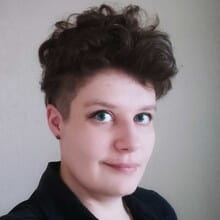
Many people think that writing a cover letter is daunting and anxiety-inducing, but the truth is that more than half of employers prefer candidates with cover letters. Missing a cover letter means missing a lot of interviews. Having a bad cover letter means...almost the same.
If you don't know how to write a cover letter, do not worry. We'll teach you how to write a good cover letter. The one employers want to see and will get you a lot of job interviews.
This guide will show you:
- How to write a cover letter for a job application that stands out.
- A cover letter sample that will get you more interviews.
- How to write a cover letter for different types of jobs.
- A full step-by-step guide to writing a cover letter quickly and painlessly
Save hours of work and get a cover letter like this. Pick a template, fill it in. Quick and easy. Choose from 20+ cover letter templates and download your cover letter now.
Create your cover letter now
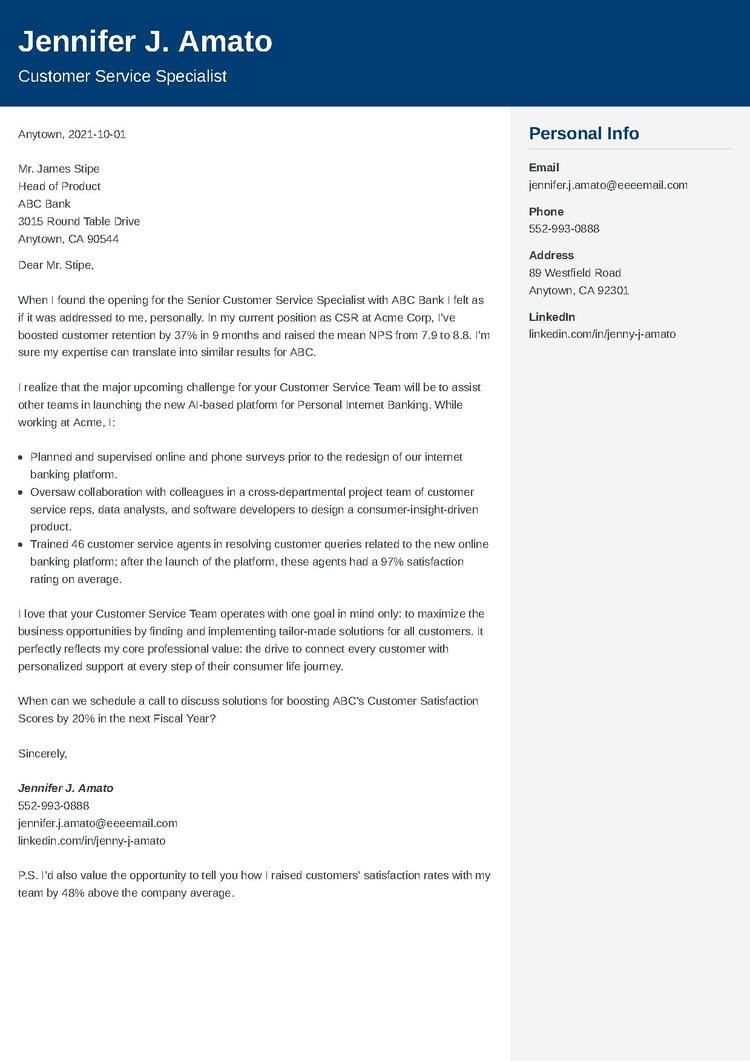
What users say about ResumeLab:
I had an interview yesterday and the first thing they said on the phone was: “Wow! I love your cover letter.” Patrick I love the variety of templates. Good job guys, keep up the good work! Dylan My previous cover letter was really weak and I used to spend hours adjusting it in Word. Now, I can introduce any changes within minutes. Absolutely wonderful! George
Want to see cover letter examples for a specific positions? Feel free to check out these articles:
- Business Cover Letter
- Consulting Cover Letter
- Customer Service Cover Letter
- Digital Marketing Cover Letter
- Human Resources Cover Letter
- Internal Position Cover Letter
- Internship Cover Letter
- IT Cover Letter
- Marketing Cover Letter
- No Experience Cover Letter
- Non-profit Cover Letter
- Project Management Cover Letter
- Social Work Cover Letter
- Teacher Cover Letter
Looking for a different cover letter example? See Cover Letter Examples for all professions .
How to Write a Cover Letter—Example
Jennifer J. Amato
Customer Service Specialist
89 Westfield Road
Anytown, CA 92301
552-993-0888
linkedin.com/in/jenny-j-amato
Anytown, 1/10/2021
Mr. James Stipe
Head of Product
3015 Round Table Drive
Anytown, CA 90544
Dear Mr. Stipe,
When I found the opening for the Senior Customer Service Specialist with ABC Bank I felt as if it was addressed to me, personally. In my current position as CSR at Acme Corp, I’ve boosted customer retention by 37% in 9 months and raised the mean NPS from 7.9 to 8.8. I’m sure my expertise can translate into similar results for ABC.
I realize that the major upcoming challenge for your Customer Service Team will be to assist other teams in launching the new AI-based platform for Personal Internet Banking. While working at Acme, I:
- Planned and supervised online and phone surveys prior to the redesign of our internet banking platform.
- Oversaw collaboration with colleagues in a cross-departmental project team of customer service reps, data analysts, and software developers to design a consumer-insight-driven product.
- Trained 46 customer service agents in resolving customer queries related to the new online banking platform; after the launch of the platform, these agents had a 97% satisfaction rating on average.
I love that your Customer Service Team operates with one goal in mind only: to maximize the business opportunities by finding and implementing tailor-made solutions for all customers. It perfectly reflects my core professional value: the drive to connect every customer with personalized support at every step of their consumer life journey.
When can we schedule a call to discuss solutions for boosting ABC’s Customer Satisfaction Scores by 20% in the next Fiscal Year?
P.S. I’d also value the opportunity to tell you how I raised customers’ satisfaction rates with my team by 48% above the company average.
After reading this cover letter, Mr. Stipe couldn’t resist inviting Ms. Amato to a job interview. Yours can be just as effective. Let’s start with the basics:
What is a Cover Letter?
A cover letter is a one-page document that’s a part of your job application alongside your resume. In your cover letter, you get a chance to introduce yourself, set yourself apart from all the other candidates, and prove you’re the best person for this job.
A cover letter isn’t just a retelling of the facts you share in your resume. It gives a glimpse of your personality while showcasing your professional achievements in greater detail. It should also show your passion for the specific job you’re applying for—otherwise, the recruiter will think you don’t really want the job and move on to the next candidate.
In short, a cover letter is a document that can make or break your entire job application. Let’s see how to write one that’s guaranteed to become a success:
How to Write a Cover Letter
Many people—even seasoned professionals—aren’t quite sure how to write a cover letter. So, if the very thought of writing it makes you anxious, you’re definitely not alone. But you’re not doomed to dedicate half of your day to anxious guesswork along the lines of “How do I even get started?”
Effective cover letters follow a clear underlying structure that you can easily borrow:
- Opening paragraph that grabs the reader’s attention
- Paragraph that shows why you’re the best candidate
- Another paragraph that demonstrates your passion for this specific job at this specific company
- Call to action
- P. S. (optional)
If you include all these elements in your cover letter, you’ll be a lot closer to getting your dream job than you think.
Now, let’s go through all these elements. Here's how to write a successful cover letter:
1. Stick to the Proper Cover Letter Format
Your cover letter should follow the best practices for writing business letters. Keep your cover letter short and to the point—in fact, your entire cover letter shouldn’t be longer than 350 words. Yes, that doesn’t look like much, but it’s a good cover letter length to aim for.
Pick a professional, easy-to-read font, set the line spacing to 1 or 1.15, and align your paragraphs to the left . This formatting is easy on the eyes and won’t give the recruiter a headache.
Recruiters are busy people, remember? Add an extra line between paragraphs so that your cover letter is easy to scan within a few seconds.
Not sure how to format your cover letter and choose the best layout? Check out our guide to cover letter formatting or, even better, use our cover letter builder that does the job for you.
Double your impact with a matching resume and cover letter combo. Use our cover letter generator and make your application documents pop out.
CREATE YOUR COVER LETTER NOW

Want to try a different look? There's 21 more. A single click will give your document a total makeover. Pick a cover letter template here .
2. Write a Professional Cover Letter Header
Writing a cover letter heading sounds simple, but if you happen to get it wrong, your job application is doomed.
Fortunately, writing cover letter headers is easy. Just follow this template:
[Your First and Last Name]
[Your Job Title]
[Phone Number]
[Email Address]
[LinkedIn Profile URL]
[Location / Date of Writing]
[Hiring Manager’s First and Last Name]
[Hiring Manager’s Professional Title]
[Name of Company]
[Company Street Address]
[City, State, Zip Code]
You can also add links to other online profiles that are relevant for your job. For example, you can link to your GitHub if you’re a software developer. If you’re an illustrator, add a link to your portfolio on Behance.
Expert Hint: Double-check your cover letter header for typos—no hiring manager wants to see their name misspelled! Also, make sure your contact info is the same as the info you give in your resume header.
3. Open a Cover Letter with a Killer First Paragraph
Done with the header? Good, let’s move on to the next step.
Start with a simple, professional greeting . If you’re applying for a corporate job, opt for “Dear Mr./Ms. Lastname”. If your dream employer has a more relaxed company culture, you can write “Dear Firstname” instead.
Can’t find the hiring manager’s name in the job ad? Research the company’s website, do a quick search on Google or LinkedIn… or just call the company and ask who’s responsible for the hiring process.
If you still can’t find out their name, write “Dear Hiring Manager” or “Dear Hiring Team”. This greeting isn’t as great as addressing a letter to a specific person, but it’s still better than “Dear Sir or Madam” or “To whom it may concern”.
Now it’s time to write the first paragraph. Your main goal here is to grab the reader’s attention and make them read on. Here are some ways to start a cover letter :
- Tell a brief story of your key achievement
- Drop a name
- Mention the company’s recent achievement and compliment them on it
Let’s look at some examples.
How to Write a Cover Letter: Opening Paragraph
In this opening paragraph, the candidate shares two epic achievements and promises to bring similar value to the company she’s applying to.
Hi there,
In response to your Senior Customer Service Specialist opening, I’d like to submit my application. With 7+ years of experience in customer service, I know I would be a perfect fit for the position.
First , “Hi there” isn’t the best way to address a hiring manager at a bank.
Second , simply having 7+ years of experience doesn’t automatically make you qualified for a specific job.
Third , this intro is simply boring. HR people see those clichés dozens of times every day, and, unless they’re extremely bored and have nothing else to do, they won’t read the rest of the letter.
4. Prove You’re the Best Person for This Job
Our candidate, Jennifer, is applying for a Senior Customer Service Specialist position with The ABC Bank.
Her prospective employer has specific plans: they’re launching a new AI-based, customized platform for personal internet banking . She researched the bank’s website, read the job ad once again, and identified that the employer is specifically looking for:
- A skilled Customer Service Specialist , obviously
- Someone experienced in developing customer surveys to analyze insights
- An employee good at collaboration with members from other teams
In the next paragraph of her cover letter, Jennifer shows two things:
- She’s researched the company and knows what project she’ll be working on.
- She has a history of professional achievements that clearly match the ideal candidate’s profile.
Here’s how she did it:
How to Write a Cover Letter: Second Paragraph
I realize that the major upcoming challenge for your Customer Service Team will be to assist other teams in launching the new AI-based platform for Personal Internet Banking . While working at Acme, I:
See how she gives specific, highly relevant proof? This is how you should write your own cover letter.
Now, let’s look at what another candidate wrote:
In my career, I’ve performed a wide array of customer service duties. I was responsible for providing assistance to customers via phone, email, and fax, performing general clerical duties, filing, data entry, billing, as well as recognizing and resolving documentation errors.
OK, so they did customer service stuff. Were they good at it? Just listing a bunch of responsibilities doesn’t prove you were actually good at any of them. After all, someone was responsible for making the Titanic unsinkable!
5. Let Your Cover Letter Show Why This is Your Dream Job
In the next paragraph of your cover letter, show why you’re passionate about working for this particular company. Why?
Well, no one wants to hire a person who doesn’t care about their job.
Here are some ways to show your passion:
- Compliment the employer on an award they won or some other recent achievement
- Demonstrate that you share the company’s values
- Make it clear that you’d be honored to be a part of such an excellent team
How to Write a Good Cover Letter: Examples
Jenny wrote the following:
You may need to look at the company’s website to learn more about its values. But you always do your research before applying for a job, don’t you?
Also, make sure you tailor this paragraph to every job offer you’re applying to. Don’t be like this person:
This one screams, “I’VE ALREADY COPIED AND PASTED THIS A MILLION TIMES AND I’M NOT GOING TO STOP!”
If you just copy and paste generic phrases like this, recruiters will just assume that you don’t care about this specific job offer. So they won’t care to invite you to an interview either.
6. End Your Cover Letter with a Powerful Call to Action
What’s the point of your cover letter? To persuade the reader to take action and invite you to a job interview. And the best way to get someone to act is… by asking them. Yep, it’s that straightforward.
Ask the reader to schedule a call or a meeting, and offer to talk about the value you can bring to the company.
What to Write in a Cover Letter: Sample Call to Action
Jenny clearly means business. She’s confident, straightforward, and eager to help the employer achieve specific, measurable results. Looks like the right person for the job.
This doesn’t even look like a call to action. Rather, it’s yet another boring cliché—the recruiter will probably just yawn and move on to the candidate.
7. Sign off Like a Pro
You’re almost done! Now’s the time to end your cover letter . Write something like “Sincerely” (or any other classic closing formula for business letters ) and then add your full name.
If you’ve got a scanned version of your handwritten signature, paste it into the document for that cool, ultra-professional look. After that, repeat your contact information. This is a common practice in business letters and makes it easier for the reader to contact you immediately.
Here’s what it looks like for Jenny:
8. Add a Tasty P. S.
Now you know how to write a cover letter. But if you want to put an extra cherry on the cake, add a P. S. under your sign-off.
In the P. S., promise to tell the reader a story about one of your most impressive achievements. They won’t resist inviting you, even if it’s just to hear the story.
Expert Hint: You may be tempted to put a joke in the P. S., but that’s very risky. The joke might fall flat and ruin your entire job application. Stay professional throughout your entire cover letter.
9. Make Sure Your Resume is as Good as Your Cover Letter
We've covered all the information you need to write in a cover letter. But, your cover letter, no matter how amazing, is just one half of your job application. Your resume needs to be just as good, so give it some love, too.
We've prepared a dedicated guide on how to write a resume . It'll show you step-by-step instructions, similary to this one.
With ResumeLab’s resume builder you’ll write your resume in a flash. Get specific content to boost your chances of getting the job. Add job descriptions, bullet points, and skills. Improve your resume in our resume builder now .
CREATE YOUR RESUME NOW

Nail it all with a splash of color, choose a clean font, highlight your skills in just a few clicks. You’re the perfect candidate and we’ll prove it. Just pick one of 21 resume templates and get started now .
You’ve just read a ton of information, so let’s recap. Here’s how to write a cover letter for any job or internship:
- Start with a professional cover letter layout and formatting (use our cover letter builder or a free MS Word cover letter template)
- Create a header and make sure it’s perfectly error-free
- Craft an attention-grabbing first paragraph
- Give specific examples showing that you’ve the right person for this specific job
- Show your passion for the company
- Add a call to action
- Sign off like a pro
- Surprise the reader with a P. S. (optional)
Got questions about how to write a great cover letter? Need assistance with writing your cover letter for a job? That’s what the comments section is for. Get in touch and I’ll respond right away.
About ResumeLab’s Editorial Process
At ResumeLab, quality is at the crux of our values, supporting our commitment to delivering top-notch career resources. The editorial team of career experts carefully reviews every article in accordance with editorial guidelines , ensuring the high quality and reliability of our content. We actively conduct original research, shedding light on the job market's intricacies and earning recognition from numerous influential news outlets . Our dedication to delivering expert career advice attracts millions of readers to our blog each year.
How to Write a Cover Letter: Frequently Asked Questions
How to write a good cover letter.
Here are some tips for writing a successful cover letter:
- Keep it short and to the point
- Pick a professional cover letter template
- Tailor your cover letter to a specific job offer —never send out generic cover letters!
- Craft a strong opening paragraph
- Explain how you'll bring value to the company
- Show passion
- Close with a compelling call to action
What is a cover letter?
A cover letter is a one-page document that you send in with your resume . Here's what to include in a cover letter : additional information about your achievements and skills, proof that you're the best candidate for this job, and proof of your passion for this specific company.
Use a cover letter builder to craft a cover letter that follows all best practices.
What do employers look for in a cover letter?
Here's what employers want to see in your cover letter:
- Clear , to-the-point writing
- Solid proof that your skills and achievements will bring value to the company
- A genuine passion for this specific company and this specific role
- Your understanding of the company's values
- Signs that you've researched the company before applying
Check out more cover letter writing tips .
How to address a cover letter without a name?
If you can't find the recruiter's name in the job ad or on the company website, opt for "Dear Hiring Team" or "Dear Hiring Manager" .
Take care to avoid outdated, impersonal phrases like "Dear Sir or Madam" or "To whom it may concern". Learn more in the dedicated guide to addressing cover letters .
How to format a cover letter?
Format your cover letter like you would format any business letter:
- Your contact info
- The date and your location
- The recruiter's contact info
- Business salutation (Ideally "Dear Mr./Ms...")
- Opening paragraph
- Closing paragraph
- Sign-off ("Best regards" followed by your name will do just fine)
- Optional P. S.
For more information on page margins, fonts and layout, check out our guide on cover letter formatting . Or head straight to a cover letter generator that will take care of the formatting.
Is a cover letter the same as a resume?
A resume provides an overview of your career and education, usually in the form of bullet points. A cover letter, on the other hand, provides context and explains why you're the best candidate. To make sure your job application is successful, submit both a resume and a cover letter. Use a resume builder and a matching cover letter builder for a consistent look.
Is a cover letter necessary?
Short answer: yes . More than 70% of recruiters prefer candidates who do send a cover letter, even if the job ad says it's optional.
Unless you're applying via an online form where you can't upload a cover letter, always make sure to include one . Use a cover letter builder to make the writing process quick and painless.
How long should a cover letter be?
200–350 words . This is a good cover letter length to aim for—just enough to put your message across without unnecessary fluff.

Olga is a career expert with a background in teaching. At ResumeLab, she writes actionable guides to help job-seekers highlight their unique strengths and unlock their career potential.
Was it interesting? Here are similar articles
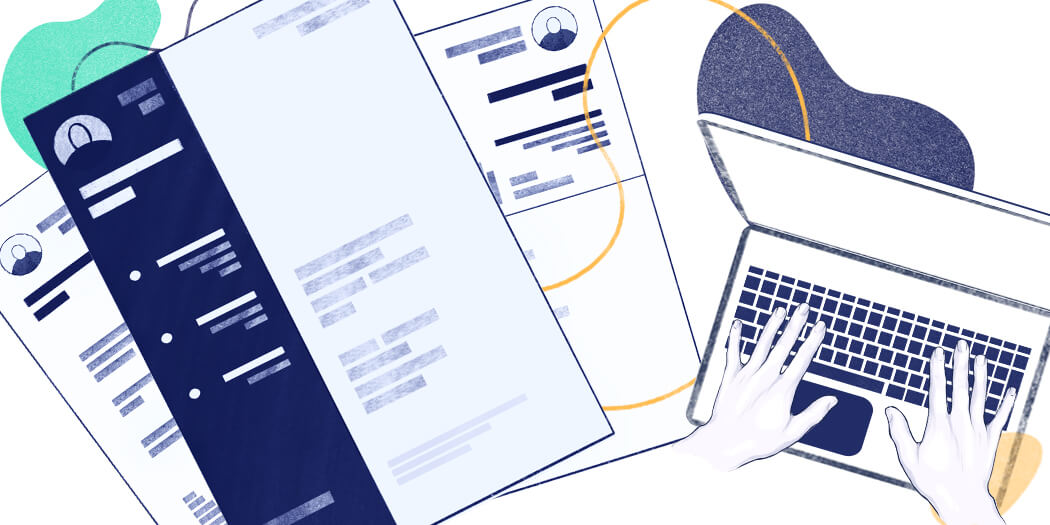
Free Cover Letter Templates for Word to Start With
Unlock your dream job with free, editable Word cover letter templates! Discover a collection of expertly designed templates with pro tips. Download now for a winning application!

Mariusz Wawrzyniak
Career Expert
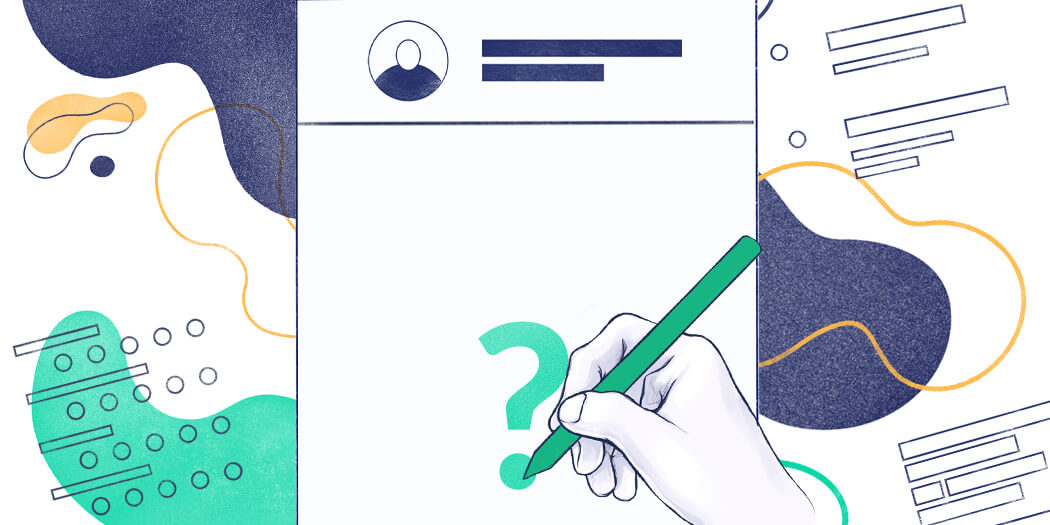
General Cover Letter That’s Not Generic: Free Samples (2024)
A resume is just another sheet of paper without a cover letter to show your human side. Use these 3 generic cover letter samples to write your own non-general cover letter fast.

Tom Gerencer, CPRW
Writer, Career Expert
![5 what should a writer not include in a cover letter 20+ Modern Resume Templates [Examples for 2024]](https://cdn-images.resumelab.com/pages/modern_templates_listing.jpg)
20+ Modern Resume Templates [Examples for 2024]
You’ve just come across a modern resume template treasure trove. Now, take your time, look around, pick the modern resume you like most, and make a job-winning resume.

English Use arrow key to access related widget.
- Customer Service
- My USPS ›
- Español
Top Searches
Alert: USPS.com is undergoing routine maintenance from 10 PM ET, Saturday, May 18 through 4 AM ET, Sunday, May 19, 2024. During this time, you may not be able to sign in to your account and payment transactions on some applications may be temporarily unavailable. We apologize for any inconvenience.
Alert: Some of our applications may be unavailable during routine maintenance from Saturday, May 11 through Sunday, May 12. We apologize for any inconvenience.
Alert: Severe weather in the South, Southeast, and Midwest may impact package delivery. Read More ›
Alert: The online Postal Store is currently unavailable. We are working to resolve the issue and apologize for the inconvenience.
Alert: We are currently experiencing issues with some of our applications. We are working to resolve the issues and apologize for the inconvenience.
Alert: USPS.com is undergoing routine maintenance from 10 PM ET, Saturday, March 9 through 4 AM ET, Sunday, March 10, 2024. During this time, you may not be able to sign-in to your account and payment transactions on some applications may be temporarily unavailable. We apologize for any inconvenience.
Alert: Severe weather conditions across the U.S. may delay final delivery of your mail and packages. Read more ›
Alert: USPS.com is undergoing routine maintenance from 11 PM ET, Saturday, March 2 through 4 AM ET, March 3, 2024. During this time, payment transactions on some applications will be temporarily unavailable. We apologize for any inconvenience.
Alert: We are currently experiencing issues with some of our applications. We apologize for the inconvenience.
Alert: Payment transactions on some applications will be temporarily unavailable from 11 PM ET, Saturday, January 6 through 3 AM ET, Sunday, January 7, 2024. We apologize for any inconvenience.
Alert: Some of our applications are undergoing routine maintenance on Monday, October 30 from 10-11 PM ET and may be unavailable. We apologize for any inconvenience.
Alert: Some of our applications are undergoing routine maintenance from Saturday, August 26 through Sunday, August 27 and may be unavailable. We apologize for any inconvenience.
Image of play button
Find out how to send mail. 1:53
Video Description: How to Send a Letter or Postcard (TXT 4 KB)
How to Send a Letter or Postcard: Domestic
Sending mail with USPS is easy! Our video will help you with most letters, cards, and postcards you send domestically (inside the U.S.), including U.S. territories and military bases in the U.S. and abroad.
For how to ship a package, see How to Send a Package: Domestic .
Send Mail: Step-by-Step Instructions
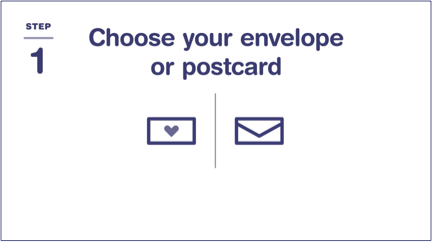
Step 1: Choose Envelope or Postcard
Envelopes are for sending flat, flexible things, like letters, cards, checks, forms, and other paper goods. For just 1 $0.68 First-Class Mail ® Forever ® stamp , you can send 1 oz (about 4 sheets of regular, 8-1/2" x 11" paper in a rectangular envelope) to anywhere in the U.S.!
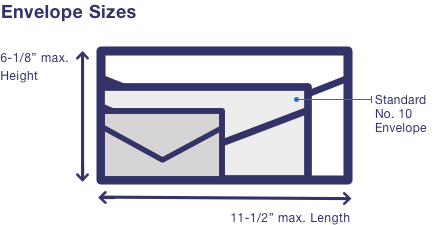
Envelopes must be rectangular and made of paper to qualify for letter prices. Your envelope can be a maximum of 11-1/2" long x 6-1/8" high. (A standard No. 10 envelope is 9-1/2" long x 4-1/8" high.) You can fold what you put in your envelope, but it needs to stay flat—no more than 1/4" thick.
If you want to send letter-sized papers without folding them, you can use a large envelope (called a "flat"); the postage for flats starts at $1.39 . If your large envelope is nonrectangular, rigid (can't bend), or lumpy (not uniformly thick), you'll have to pay the package price.
TIP: If your envelope can't fit through USPS mail processing machines, or is rigid, lumpy or has clasps, string, or buttons, it's "nonmachinable" and you'll have to pay $0.44 more to send it. ( See additional postage in Step 3 .) You'll also have to pay more if your envelopes are square or vertical (taller than they are wide).
Postcards are for short messages that you don't need to put in an envelope. Save money using a $0.53 postcard stamp to send a standard-sized postcard anywhere in the U.S. Standard postcards are usually made of paper, are between 5" to 6" long and 3-1/2" to 4-1/4" high, and are between 0.007" and 0.016" thick.
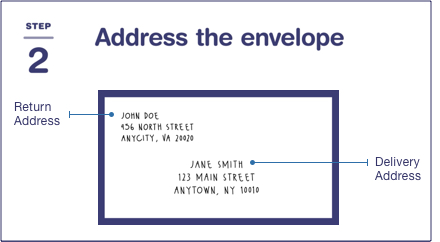
Step 2: Address Your Mail
Envelopes: Write your address (the "return" or "sender" address) in the top left corner. Write the delivery address (the "recipient" address) in the bottom center.
Postcards: Postcards come in different formats, so write the delivery address in the space it gives you (on the same side you write your message and put the stamp).
Print your return address and the delivery address clearly, in the correct spots, to make sure your mail is delivered on time.
Address Format Tips
- Use a pen or permanent marker.
- Do not use commas or periods.
- Include the ZIP+4 ® Code whenever possible.
Write Sender Address
Write your address (the "return address") in the top-left corner. Include the following on separate lines:
- Your full name or company name
- Apartment or suite number
- Full street address
- City, State, and ZIP+4 Code
Write Delivery Address
Write the delivery address (the "recipient" address) in the bottom center of the envelope. Include the following on separate lines:
- Recipient's full name or company name
If the apartment or suite number cannot fit on the delivery address line above the city, state, and ZIP+4 Code, place it on a separate line immediately above the delivery address line.
Write the sender's address in the top-left corner. Include the following on separate lines:
- Full street address and apartment or suite number, if applicable
Special U.S. Addresses
Puerto rico.
Some Puerto Rico addresses include an urbanization or community code for a specific area or development. Addresses with an urbanization code, abbreviated URB, should be written on 4 lines:
MS MARIA SUAREZ URB LAS GLADIOLAS 150 CALLE A SAN JUAN PR 00926-3232
More Puerto Rico Address Examples
U.S. Virgin Islands
Virgin Islands addresses have the same format as standard addresses. The right abbreviation for this territory is "VI," not "US VI" or "USA VI":
MS JOAN SMITH RR 1 BOX 6601 KINGSHILL VI 00850-9802
Military and Diplomatic Mail (APO/FPO/DPO)
Mail to military and diplomatic addresses is treated differently:
- Do not include the city or country name when you send something to an APO/FDO/DPO address in another country. This keeps your mail out of foreign mail networks.
- Do include unit and box numbers if they're assigned:
SEAMAN JOSEPH SMITH UNIT 100100 BOX 4120 FPO AP 96691
More Details on Military Addresses
When you're done addressing your envelope, put what you're sending inside the envelope, then close and seal it (using the envelope's glue or tape).
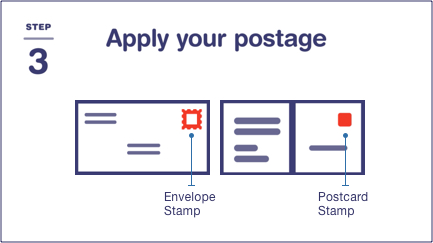
Step 3: Calculate Postage (& Add Insurance or Extra Services)
A First-Class Mail ® Forever stamp costs $0.68 and goes in the upper right corner of the envelope. (You can also use any combination of stamps that adds up to $0.68.)
If your letter is heavier or bigger, or if you want to add insurance or extra services like Certified Mail ® service, you'll pay more.
A standard postcard stamp costs $0.53 . (Large or square postcards will cost more.) Put the postcard stamp in the space provided near the delivery address.

Postage for letters mostly depends on weight and size/shape. You can weigh your letter with a kitchen scale, postal scale , at a self-service kiosk, or at the Post Office ™ counter.
TIP: As a rule of thumb, you can send 1 oz (4 sheets of printer paper and a business-sized envelope) for 1 First-Class Mail ® Forever ® stamp (currently $0.68).
The postage for a large envelope (or flat) starts at $1.39 for 1 oz.
Where Can I Buy Postage?
- The Postal Store ® Shop online for all stamps and add-on postage for oversized or heavier envelopes.
- Post Office Locations Buy stamps at Post Office locations , self-service kiosks , or at National Retailers such as grocery and drug stores.
TIP: If you're sending larger envelopes (flats) using Priority Mail ® or Priority Mail Express ® service, you can use Click-N-Ship ® service to pay for and print your own postage online.
Additional Postage
If your envelope weighs over 1 oz, you can buy additional postage in the amount you need:
- Each additional 1 oz is $0.24, for letters up to 3.5 oz and large envelopes up to 13 oz.
- Nonmachinable items, including envelopes that are lumpy or rigid, or have clasps, string, or buttons will cost $0.44 more to send. You'll also have to pay more if your envelopes are square or vertical (taller than they are wide).
- You can also buy 1¢, 2¢, 3¢, 4¢, 5¢, and 10¢ stamps at The Postal Store .
TIP: Put the stamp on last; that way, if you make a mistake at any other point, you won't waste a stamp.
Calculate a Price
Add-On Services
If you want insurance, proof of delivery, signature services, or other optional services, you'll have to pay extra.
Our Insurance & Extra Services page has more details; some of the more common add-on services for letters include:
- Certified Mail ® : Get proof that you mailed your item and that the recipient signed for it.
- Registered Mail ® : USPS's most secure mail service–mail is processed manually, handled separately and securely, and signed for along every step of its journey. The recipient must sign for the mail to confirm delivery (or attempted delivery).
- Return Receipt: You'll get a printed or emailed delivery record showing the recipient's signature. You can combine Return Receipt with other services, including Certified Mail, Registered Mail, Priority Mail Express ® service, and more.
- Adult Signature Required: Only an adult (age 21+) can sign for the mail after showing a valid government ID .
Postage Options
There are several ways to get postage for your envelope.
- The Postal Store ® --> ® and Priority Mail Express ® envelopes.
- Post Office ™ Locations --> ® such as grocery and drug stores.
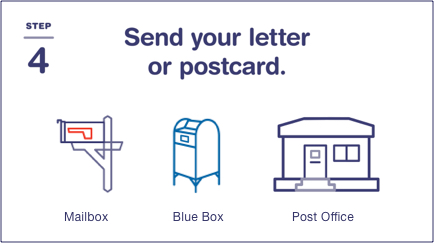
Step 4: Send Your Mail
Once your envelope or postcard has the correct addresses and postage, you can send it several ways, including putting it in your mailbox or dropping it in a blue collection box or at a Post Office ™ location.

- Put your letter inside your mailbox and raise the flag (if you have one).
- If you have a cluster mailbox, drop it in the outgoing mail slot.
- Drop it off in a blue collection box.
- Take it to a Post Office lobby drop.
Important Note: If your envelope has postage stamps and weighs more than 10 oz or is thicker than 1/2", you can't put it in a collection box; you have to give it to an employee at a Post Office location. See more details on What Can and Cannot be Deposited in a Collection Box?
Bonus: Sending Mail Pro Tips
The Postal Service uses high-speed sorting machines to help process and deliver 425.3 million mail pieces each day. Here are some extra tips to improve your mail sending experience:
- Stay flexible : Don't send rigid (hard) objects in paper envelopes.
- Sending embellished invitations (for weddings, graduations, etc.)? Get them hand-canceled or put them inside another envelope.
- Need tracking? Learn about your options.
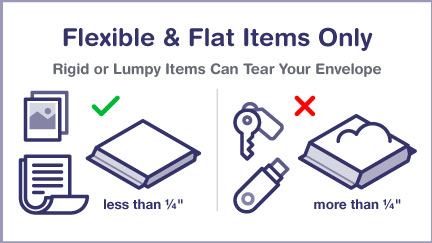
Stay Flexible
Postcards, letter envelopes, and large envelopes (flats) all need to bend to fit through USPS ® high-speed sorting machines.
- OK: Flexible, flat things like stickers, photos, trading cards, etc. should be okay—as long as your envelope stays flat, not lumpy, and less than 1/4" thick.
- Not OK: Don't put rigid objects (like flash drives, coins, keys, hard plastic card cases, etc.) loose in unpadded paper envelopes: They could get torn out of the envelope, jam the sorting machines, cause a delay, or even get lost.
Instead, for rigid and odd-shaped objects (or things you don't want to get bent), we recommend using a padded envelope or small box and sending it as a package .
Sending Embellished Invitations (for Weddings, Graduations, etc.)
If you want to send a specially decorated envelope (like some wedding invitations):
- You can pay the extra fee for nonmachinable First-Class Mail ® items, bring your mail to the Post Office™ counter, and ask the retail associate to hand-cancel your embellished invitations.
- For externally decorated invitations: If you use wax seals, strings, ribbons, etc. on your envelopes, don't try to send them exposed. Instead, to make sure your envelopes arrive looking the way your designer intended, put them inside another envelope .
Need Tracking?
Tracking is not available for First-Class Mail items. If you'd like to get tracking information for your letter:
- You can pay extra to send your letter using Priority Mail Express ® or Priority Mail ® service.
- You can get delivery confirmation by adding Certified Mail ® or Registered Mail ® service. (You can even combine it with Return Receipt if you want the recipient's signature.)
Purdue Online Writing Lab Purdue OWL® College of Liberal Arts
Welcome to the Purdue Online Writing Lab

Welcome to the Purdue OWL
This page is brought to you by the OWL at Purdue University. When printing this page, you must include the entire legal notice.
Copyright ©1995-2018 by The Writing Lab & The OWL at Purdue and Purdue University. All rights reserved. This material may not be published, reproduced, broadcast, rewritten, or redistributed without permission. Use of this site constitutes acceptance of our terms and conditions of fair use.
The Online Writing Lab at Purdue University houses writing resources and instructional material, and we provide these as a free service of the Writing Lab at Purdue. Students, members of the community, and users worldwide will find information to assist with many writing projects. Teachers and trainers may use this material for in-class and out-of-class instruction.
The Purdue On-Campus Writing Lab and Purdue Online Writing Lab assist clients in their development as writers—no matter what their skill level—with on-campus consultations, online participation, and community engagement. The Purdue Writing Lab serves the Purdue, West Lafayette, campus and coordinates with local literacy initiatives. The Purdue OWL offers global support through online reference materials and services.
A Message From the Assistant Director of Content Development
The Purdue OWL® is committed to supporting students, instructors, and writers by offering a wide range of resources that are developed and revised with them in mind. To do this, the OWL team is always exploring possibilties for a better design, allowing accessibility and user experience to guide our process. As the OWL undergoes some changes, we welcome your feedback and suggestions by email at any time.
Please don't hesitate to contact us via our contact page if you have any questions or comments.
All the best,
Social Media
Facebook twitter.
- Skip to Content
- Skip to Sidebar
- Skip to Footer
Resume Genius
The World's Smartest Resume Builder
Monday to Friday, 8AM – 12AM (Midnight) and Saturdays and Sundays, 10AM – 6PM EDT (866) 215-9048
Blog Resume Help How to Make a Resume
How to Write a Resume for a Job in 2024
Hiring managers decide whether you’re right for the job within seconds of seeing your resume. To land the job you want, you need to know how to write a resume that grabs attention (and how to write a cover letter to go with it).

As featured in *
How to write a resume
Make a resume quick and easy
Tips for writing a better resume
7 resume examples and templates
Resume writing faqs.
Whether you’re a recent graduate or an experienced professional, you need a great resume to get the best job offers.
We explain your options for creating a resume in 2024 , including everything you need to know to make sure your resume attracts recruiters and interests employers.
1. Decide your resume’s layout
Not sure how to start your resume? Before you begin writing, you need to know what a resume is and why writing one is so important to your chances of landing a job.
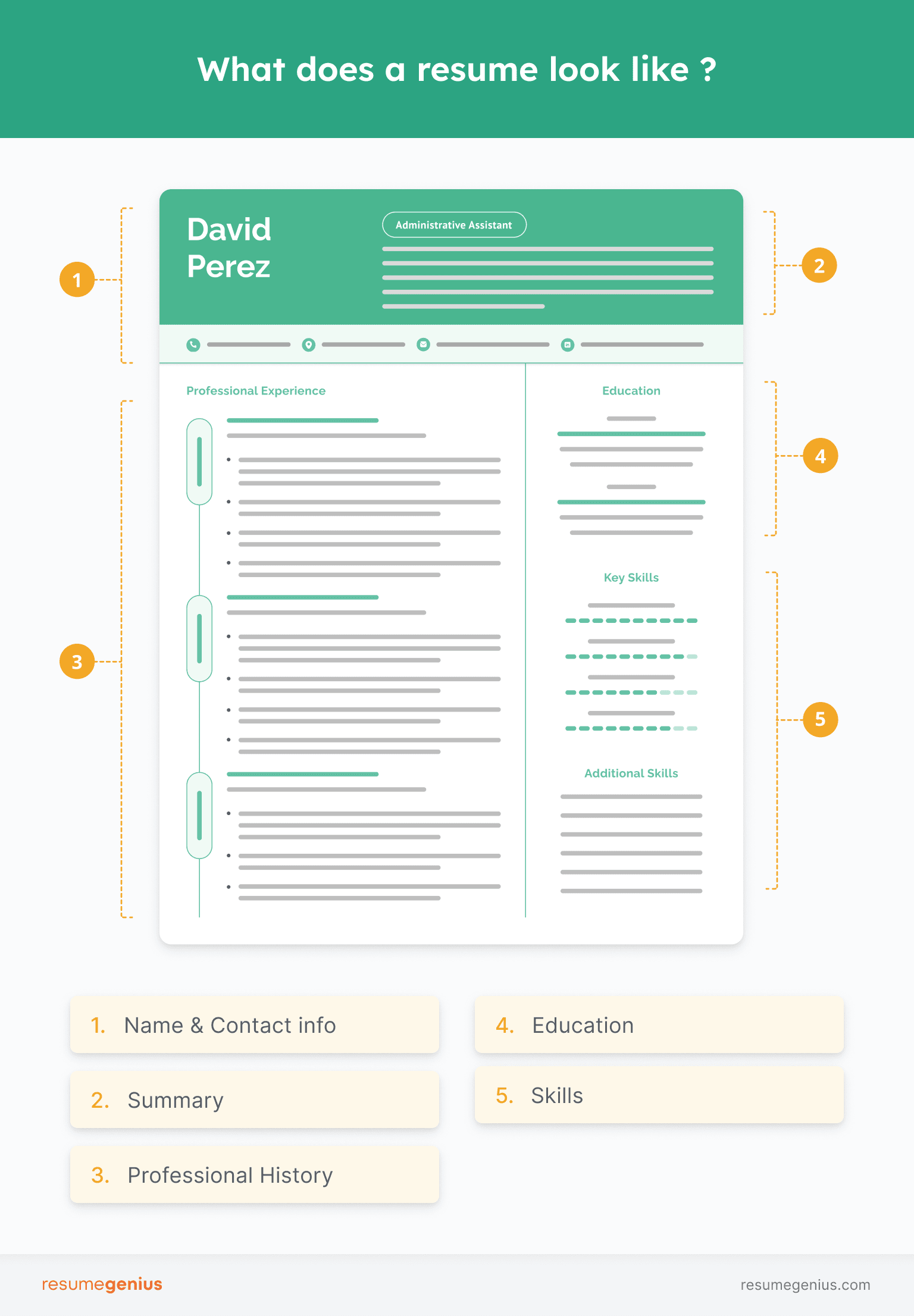
A resume is a document used in the hiring process that summarizes your work history, skills, and qualifications. The goal of your resume is to quickly communicate to employers why you’re the best candidate for the job .
There are a variety of ways to format your resume .
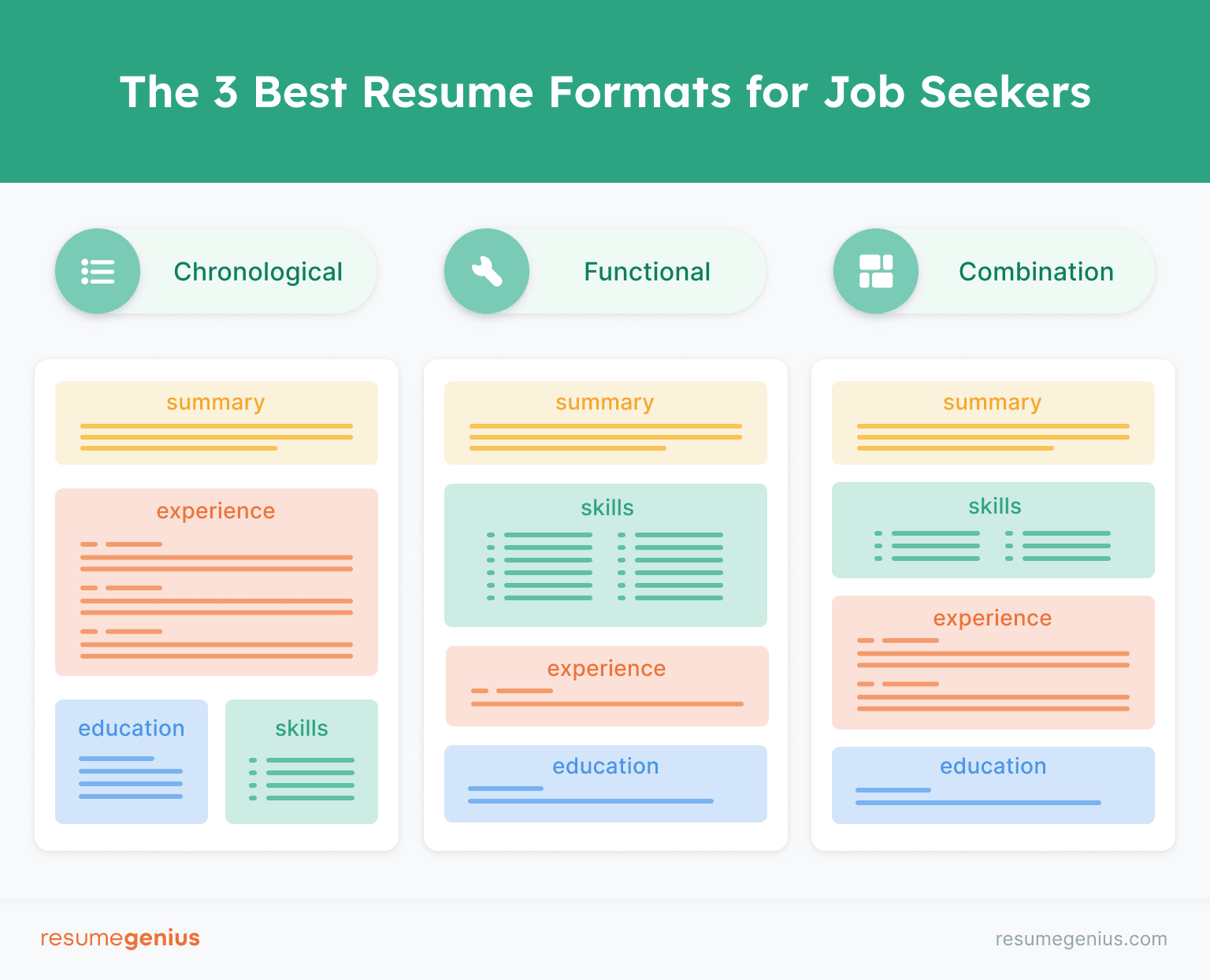
Unless you have large gaps in your work history, you should format your resume chronologically (with your most recent experience at the top) because it’s easy for employers to understand and demonstrates your career progression.
Depending on your work history or the type of job you want, you might want to consider using an alternative resume format. For example, you could use the:
- Combination resume – if you have an advanced technical skill set and work history
- Functional resume – if you have gaps in your work history and want to emphasize your skills
- Federal resume – if you’re applying to work with the federal government
- Video resume – if you’re looking for jobs that require video or performance skills
2. Pick a template with the formatting you want
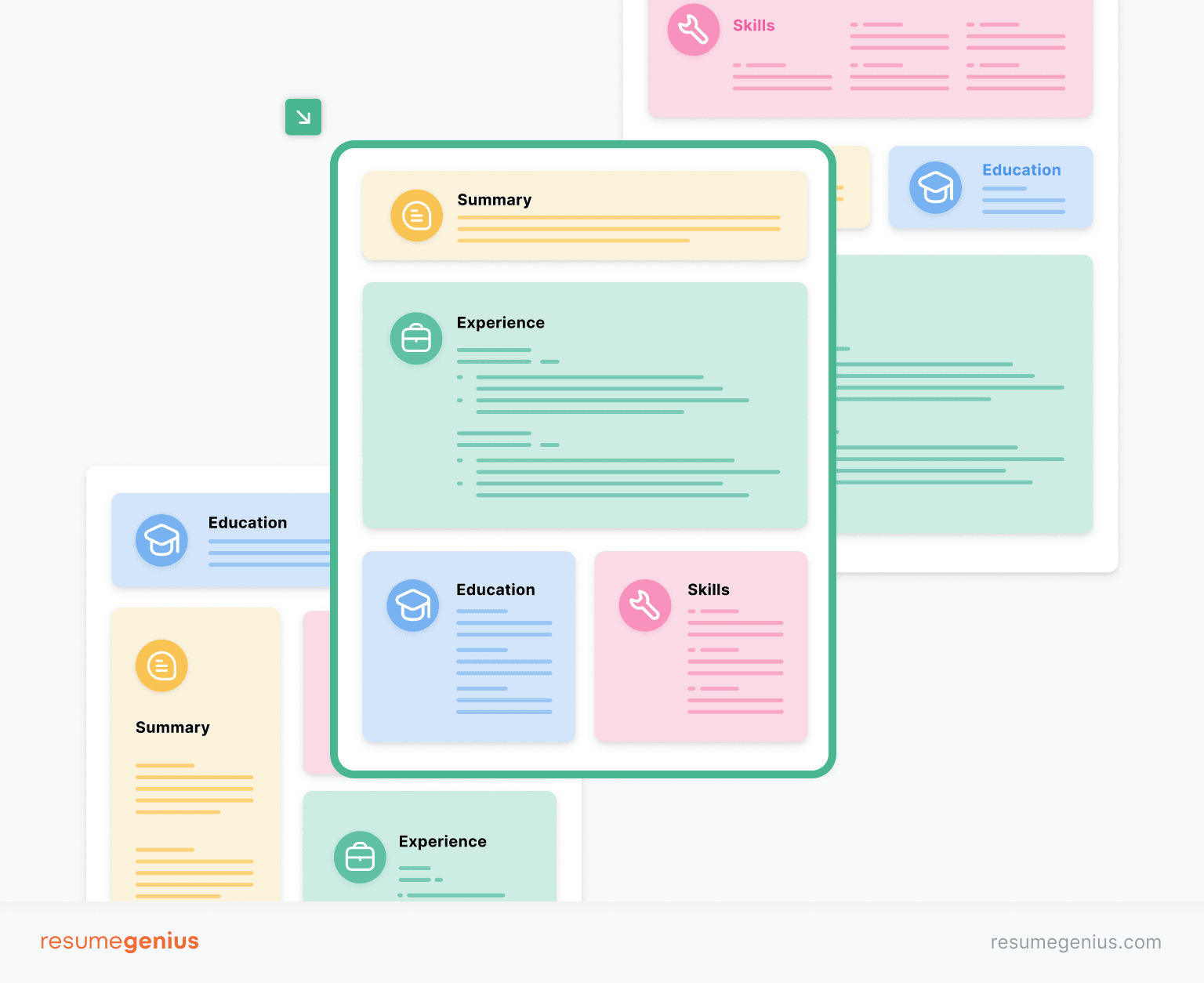
One of the most convenient ways to make a resume is to download a free resume template and fill it out with your information.
To help you get started, you can download the template below and fill in each section as you follow along in this article.
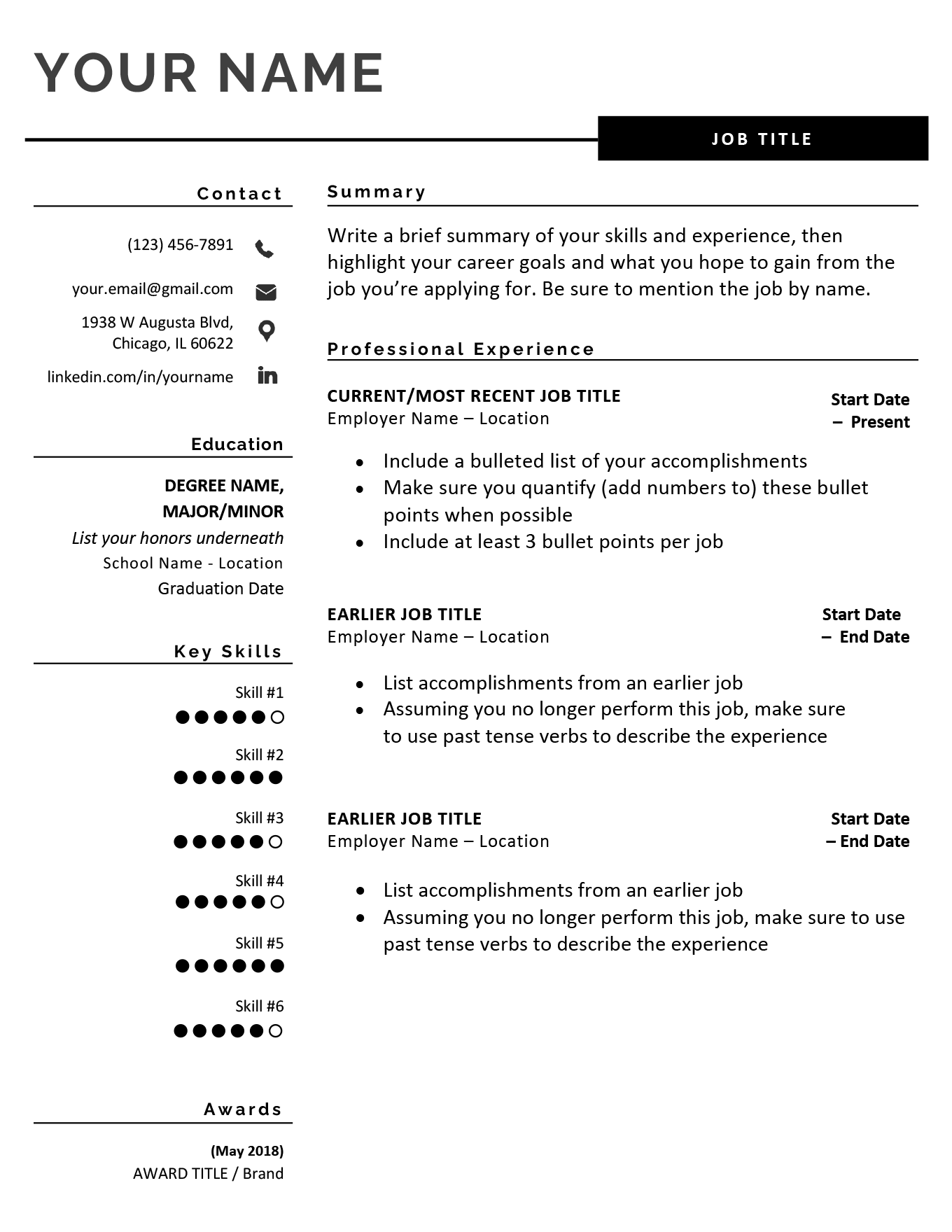
This resume template includes visual skill levels , which can make your resume more eye-catching. However, if you’re applying to a more formal job you should remove them in favor of a simple list.
3. List your name and contact information
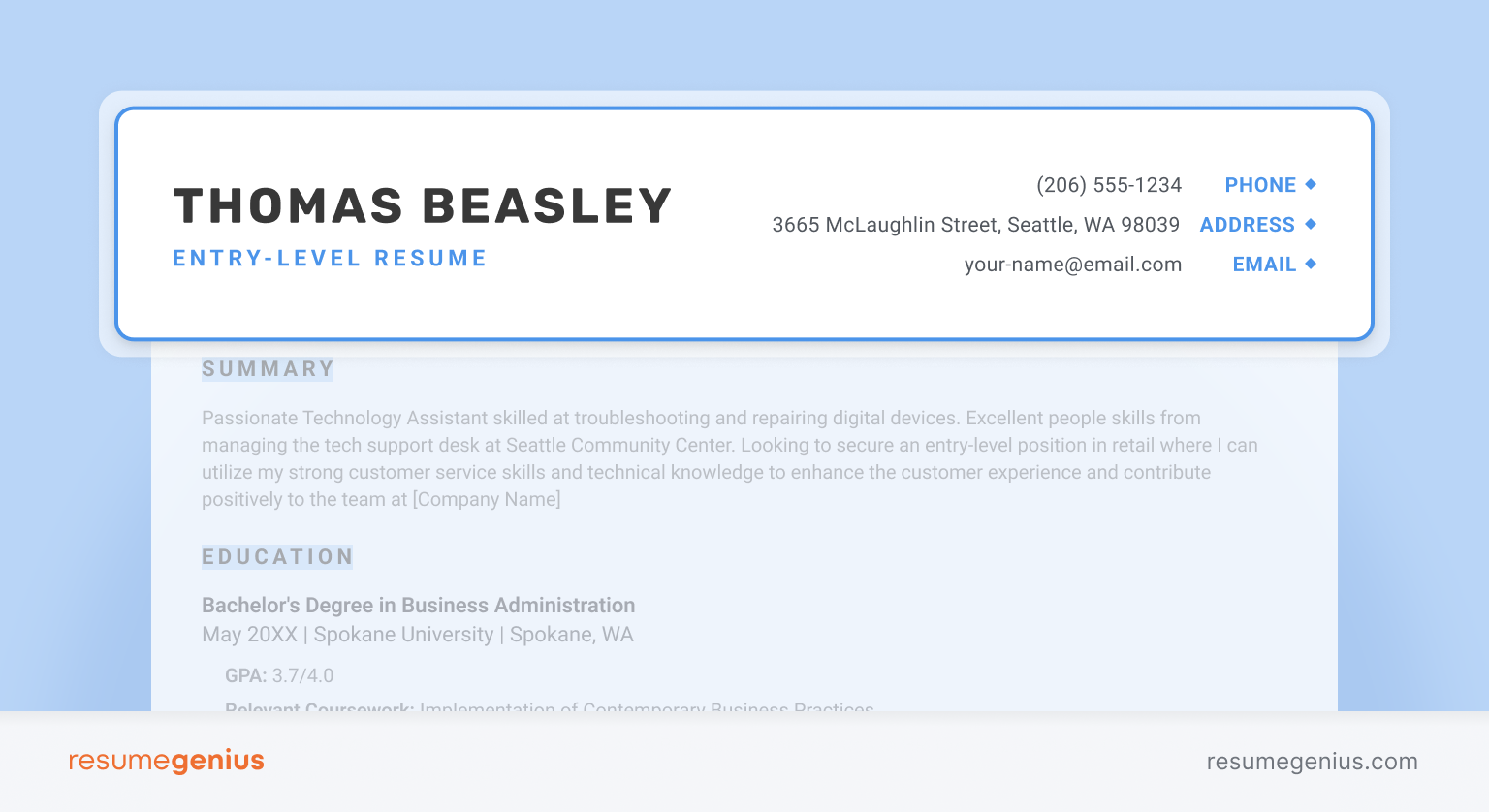
Your name should always be the largest element on your resume to make it stand out, so use a font size larger than 20 points.
The basic contact information on your resume includes your:
- email address (use a professional one like [email protected])
- phone number
You can also add these optional details :
- an online portfolio or website (if relevant to the job)
- your LinkedIn URL
- your mailing address (if you want to show you’re a local)
You might see some examples of resumes online that include professional headshots in the header. If you’re applying to jobs in the US, you shouldn’t include a picture on your resume because it could lead to hiring bias.
4. Add a resume summary
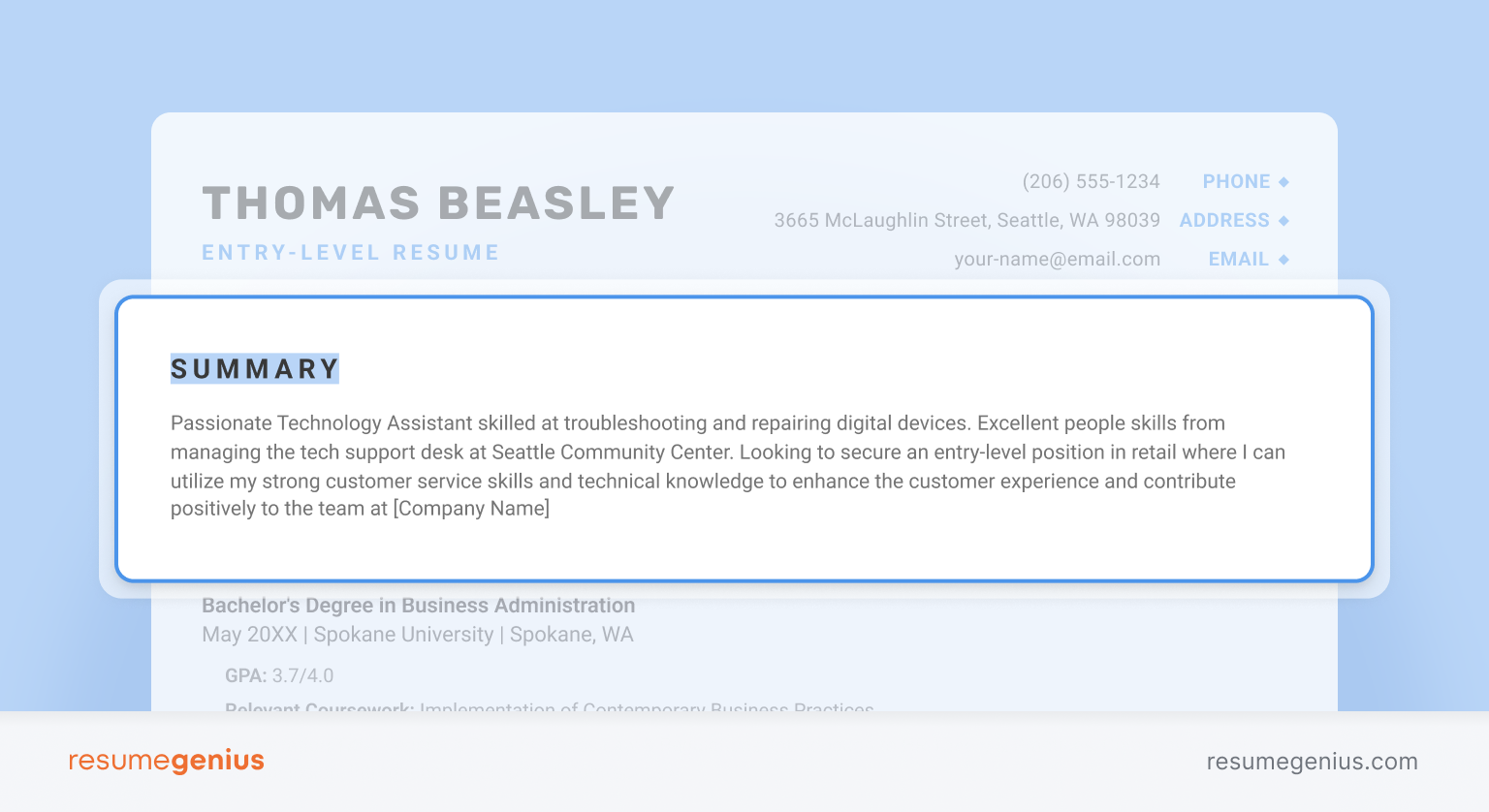
A professional resume summary is a type of 3-5 sentence introduction that provides a snapshot of your primary qualifications, with an emphasis on your most impressive achievements and skills.
Here’s exactly how to structure a resume summary :
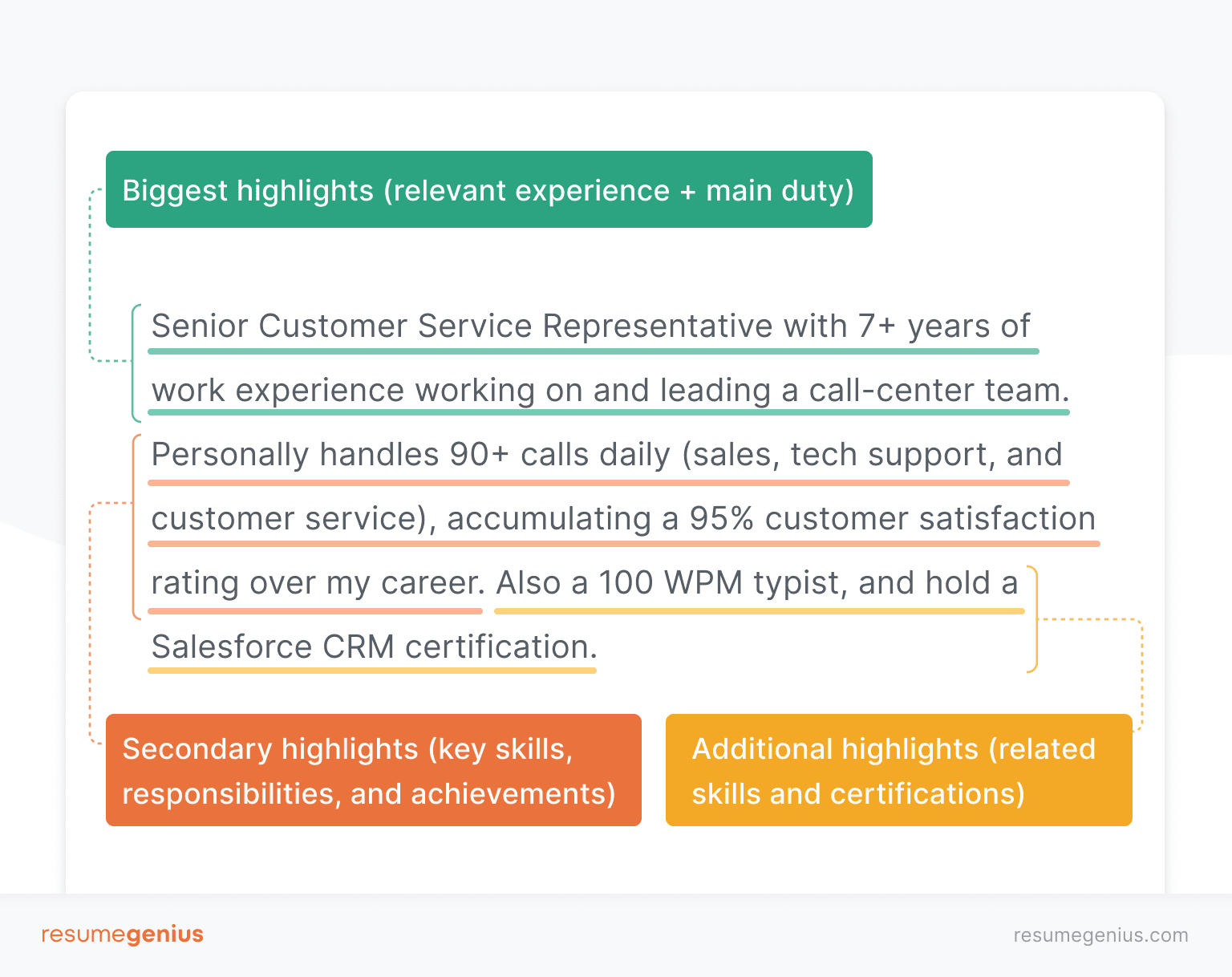
Other resume introductions
Aside from the resume summary, there are a variety of other ways to start your resume. For example, you could use a:
- Resume objective (best for first-time job seekers or career changers)
- Resume profile (best if you want to add more detail)
- Summary of qualifications (best for highly accomplished, experienced job seekers)
5. Fill out your work experience section
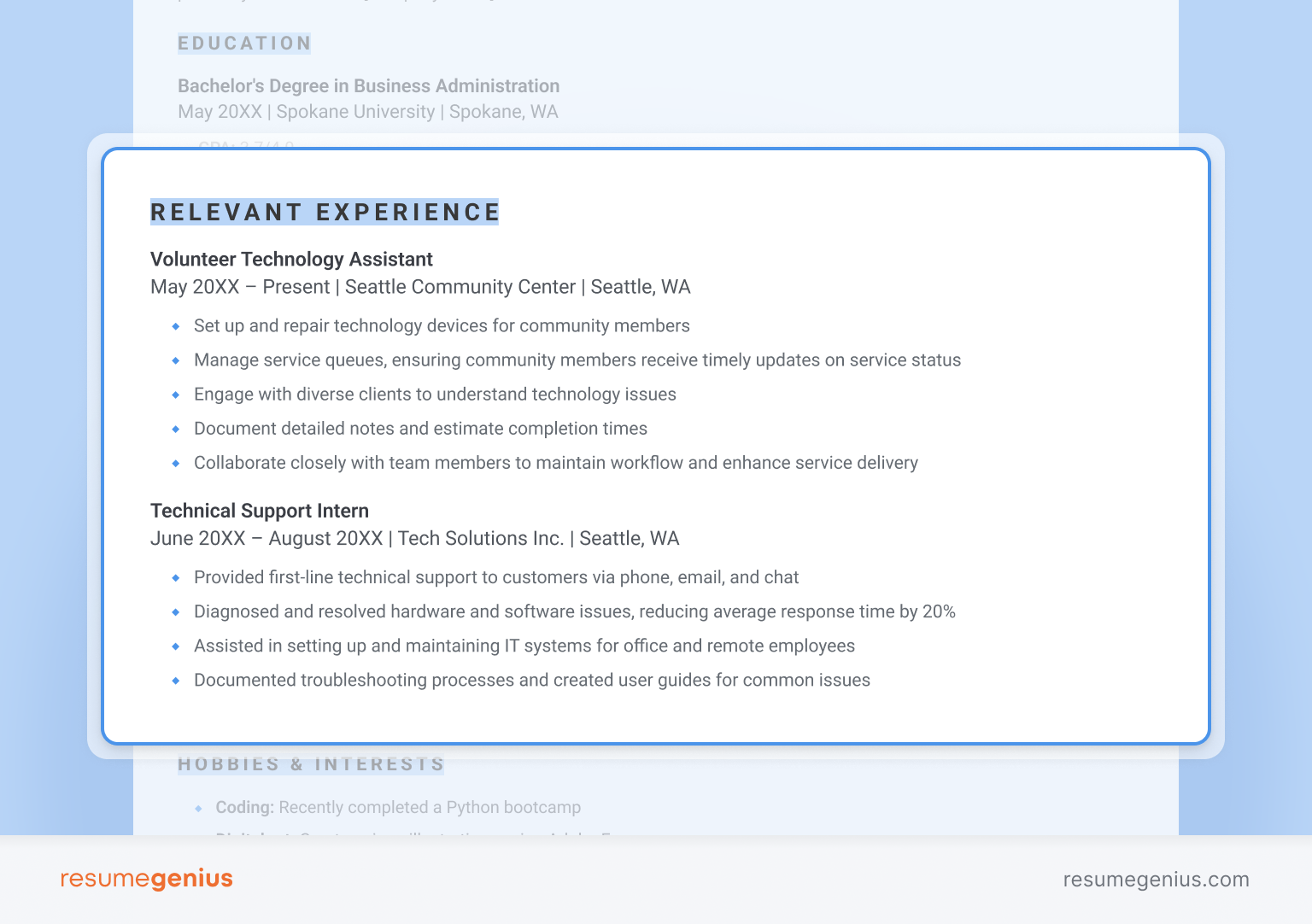
Describe your responsibilities and achievements
List each job you’ve worked with your most recently held/current job at the top, and older jobs underneath.
For each position, list the following information:
How to structure work experience on your resume
Job title – Dates employed (year and month) Company name – Company location (city and state)
- Three to five bullet points describing your achievements and responsibilities
- Include hard numbers in your bullet points when possible
Use present tense when describing current responsibilities, and past tense when discussing previous roles or completed projects.
Additionally, if you’ve been promoted at a job, list each role separately and specify how long you held each title.
Including multiple titles is the best way to show promotions on your resume and demonstrate to employers that you’ve grown as a professional even if you’ve only worked at one company.
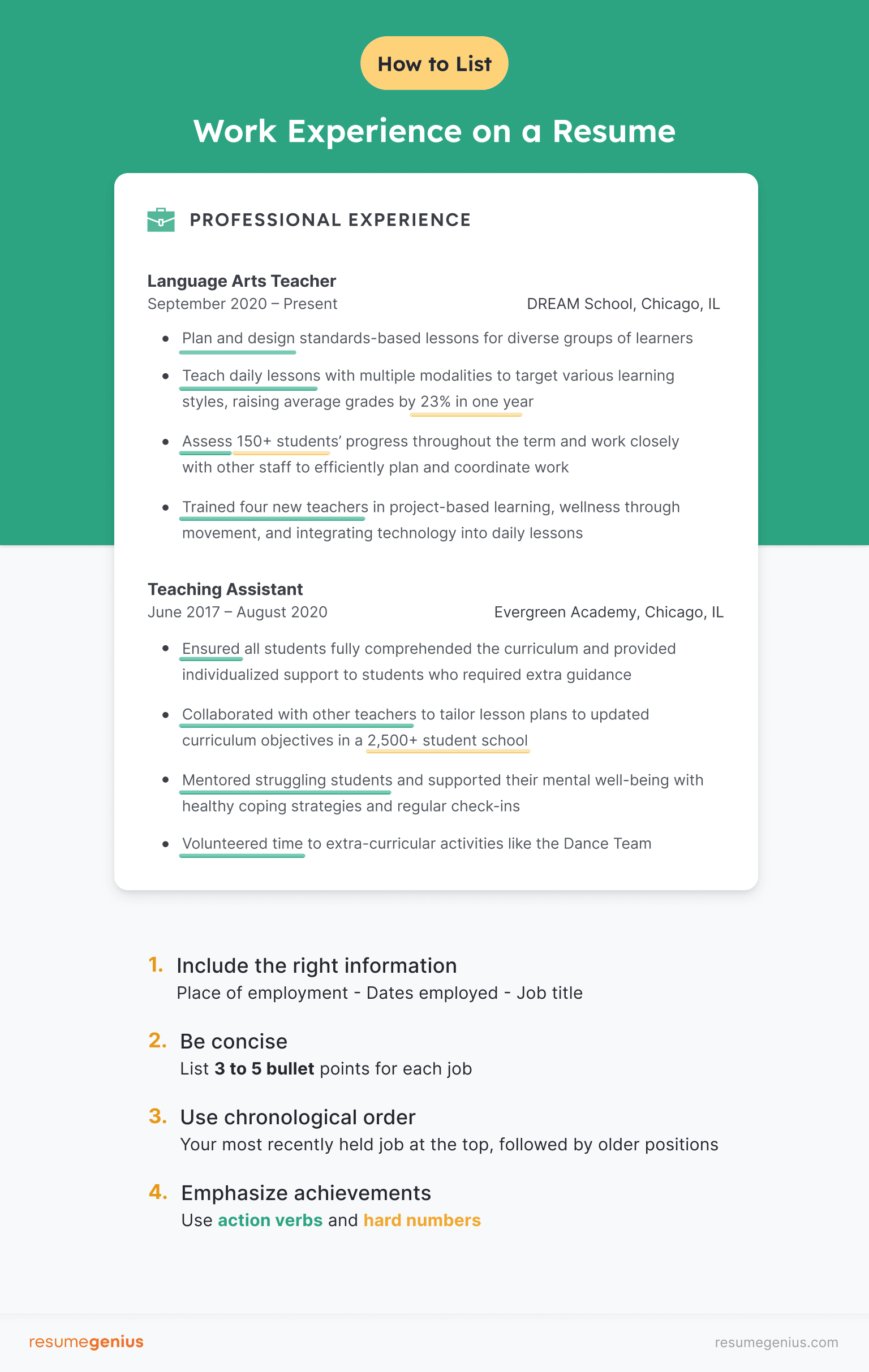
Use action verbs
Many job seekers make the mistake of starting every resume bullet point off with passive phrases like “ responsible for ,” which don’t do a good job of explaining what you accomplished at work.
To make your resume’s experience section best highlight your professional accomplishments, start each bullet point with an action verb that highlights specific actions you carried out.
Action verbs for your resume
Highlight results using hard numbers
The best way to demonstrate the impact of your professional accomplishments is to include hard numbers in your bullet points.
Hard numbers provide context to these work achievements, and show hiring managers what you’re capable of if hired.
Doesn't use numbers or action verbs
- Responsible for making media kits for company projects
Uses numbers and action verbs
- Spearheaded the development of the first media kit for all company projects, increasing annual revenue by 12%
List only your most relevant positions
Many job seekers make the mistake of listing every job they’ve ever held on their resume. The end result is in a resume that’s unfocused and cluttered.
Your resume shouldn’t be a comprehensive summary of your work experience. Think of a resume as a highlights reel for your career – showcasing only your most impressive professional achievements and skills.
To keep your resume focused, remove any positions or skills that aren’t relevant to the job you’re applying for. If you’re not sure how many jobs to list on your resume , stick to between two and four of your most relevant positions .
What to do if you don’t have work experience
Writing a resume with no work experience ? No problem! You can still make an effective work experience section.
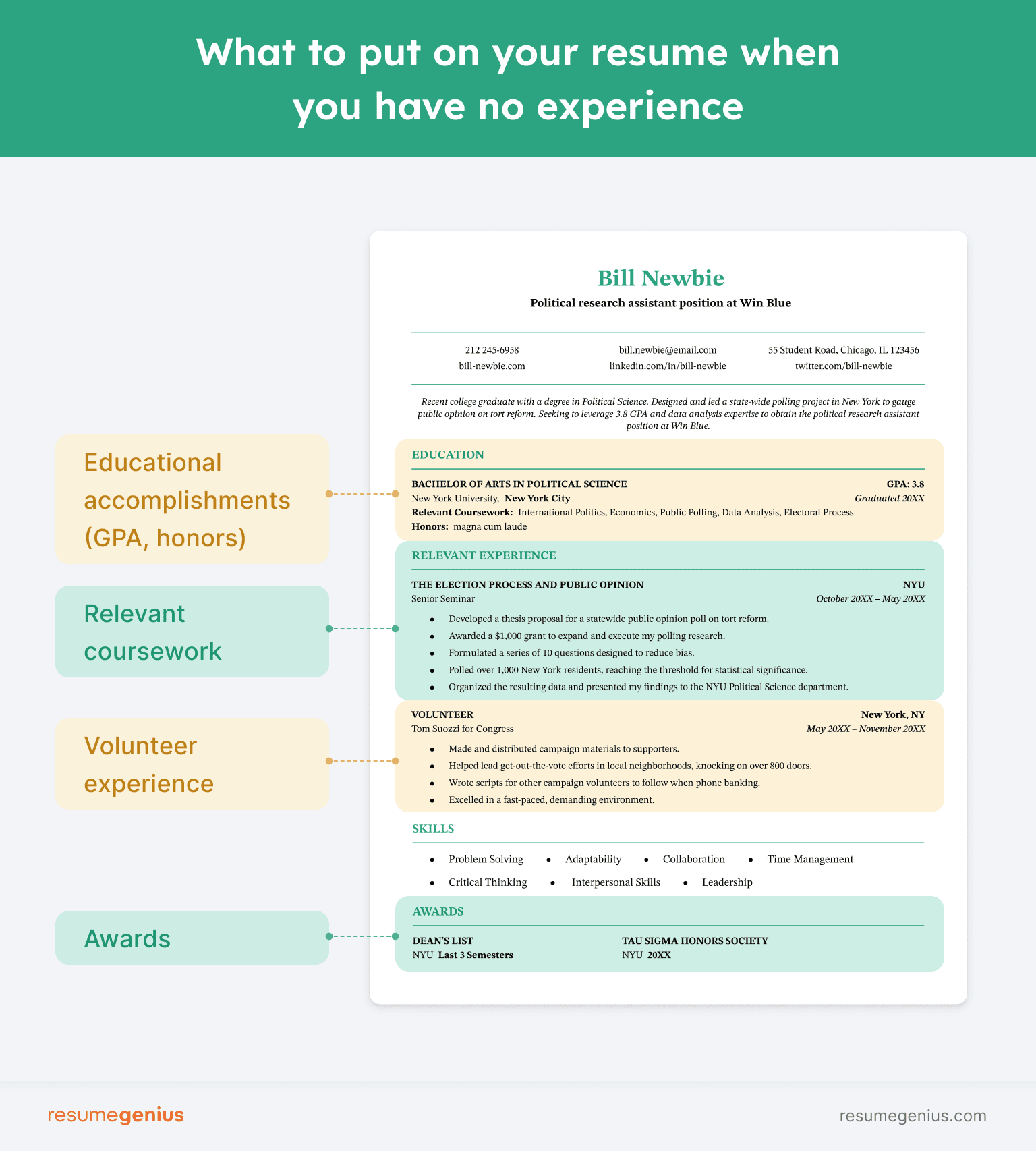
Start by renaming your work experience section to “Relevant Experience” – this will give you more flexibility. Then, list any relevant experience you have the same way you would for a full-time job. Relevant experience could be anything from independent projects to classwork.
If you’re self-employed, you can also use a “Relevant Experience” section to put your freelance work on your resume or highlight relevant experience you’ve gained through specific projects.
List volunteer work or internships
Volunteer work and internships provide opportunities to learn valuable skills that are directly transferable to full-time employment.
This makes volunteering a great way to show employers you’re qualified for the job – even if you’ve never held a full-time job.
List volunteer work on your resume in your relevant experience section with full bullet points, just like you would describe any other job. Do the same thing if you’re putting an internship on your resume .
Example of how to list volunteer experience on your resume
Volunteer, Cranford Food Distribution Center, Cranford, NJ
May 2020 – Present
- Trained 5 new volunteers, helping them develop a strong commitment to community service.
- Helped prepare food and dish out meals to over 200 people per day.
- Planned and organized two successful fundraising events, which raised the food bank over $2,500 in total.
Highlight relevant coursework
If you’re a student and you don’t have any internships yet, you can list relevant coursework on your resume to give employers an idea of what you’re capable of.
This could involve listing some relevant classes you’ve taken, or providing a full list of bullet points highlighting a school project that you worked on.
Example of how to list relevant coursework on your resume
Bachelor of Arts in Anthropology
New York University, New York City, 2020
Relevant Coursework
Social and Developmental Psychology:
- Studied qualitative research methods by reading and discussing 10+ academic articles
- Designed an online, 20-question qualitative research survey about language and identity formation
- Conducted a qualitative survey with 147 college students using Qualtrics
- Aggregated and interpreted survey results in a 10-page paper and 15-minute presentation
6. Showcase your skills
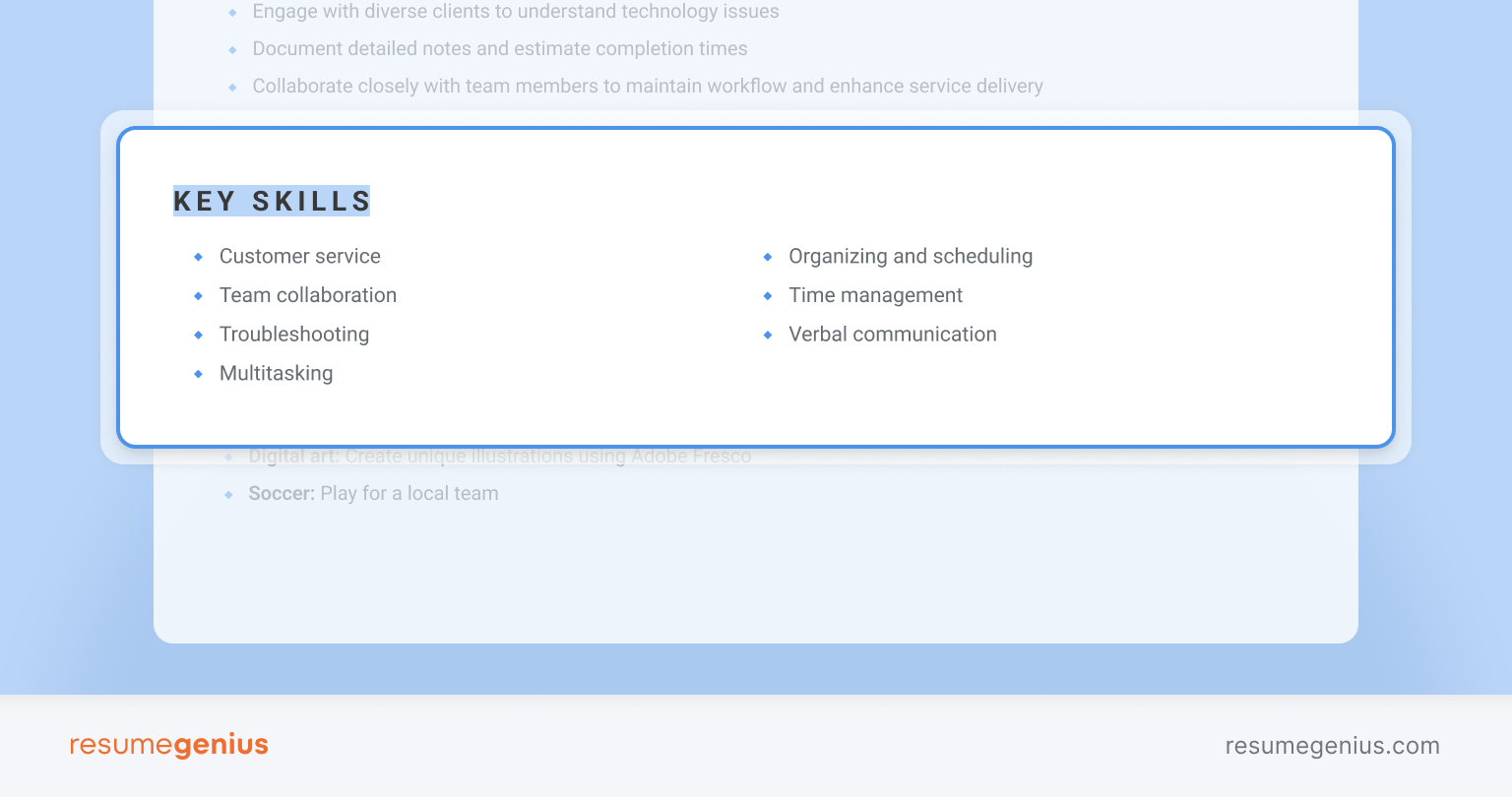
Hard skills are learned through specific training, workshops, work experience, or school and include the skills you need to operate equipment at work (like point-of-sale systems).
Soft skills relate to your personality, and you develop them by simply interacting with others and accomplishing daily tasks at work. Organizational skills like coordination and self-management are good examples of soft skills valued by employers.
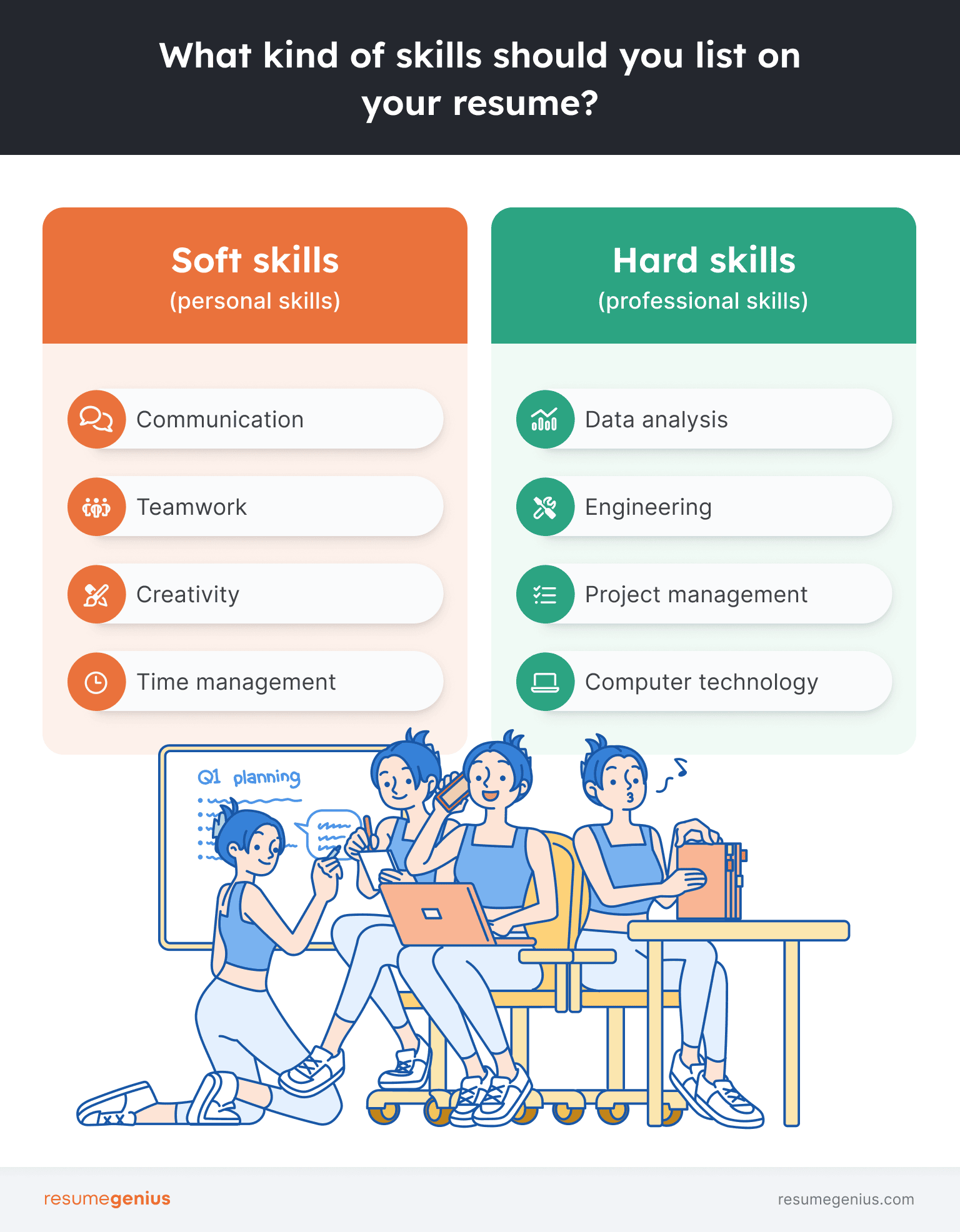
How to list your hard skills
Employers are primarily interested in your hard skills , because these are the abilities you need to perform the basic tasks associated with your job.
There are three ways you can highlight your hard skills on your resume:
- List them clearly in your skills section
- Mention them in your resume’s introduction
- Add a bullet point to your work experience section describing how you used one of your skills to achieve something
Ideally, you should combine both approaches to highlight any technical skills that are explicitly required for the job.
How to showcase your soft skills
While soft skills are valuable for any career, they’re also difficult to quantify, which make them tricky additions to your resume.
Unlike your hard skills, you should avoid listing your soft skills in your skills section. That’s because soft skills need to be demonstrated if you want employers to believe you.
The best way to highlight your soft skills is by including examples of how you used your soft skills to achieve something in your work experience section.
Here’s an example of a bullet point that effectively highlights the candidate’s leadership skills :
• Led a cross-functional team of 10 members to successfully implement a new project management system, resulting in a 20% increase in team productivity
7. Outline your education history
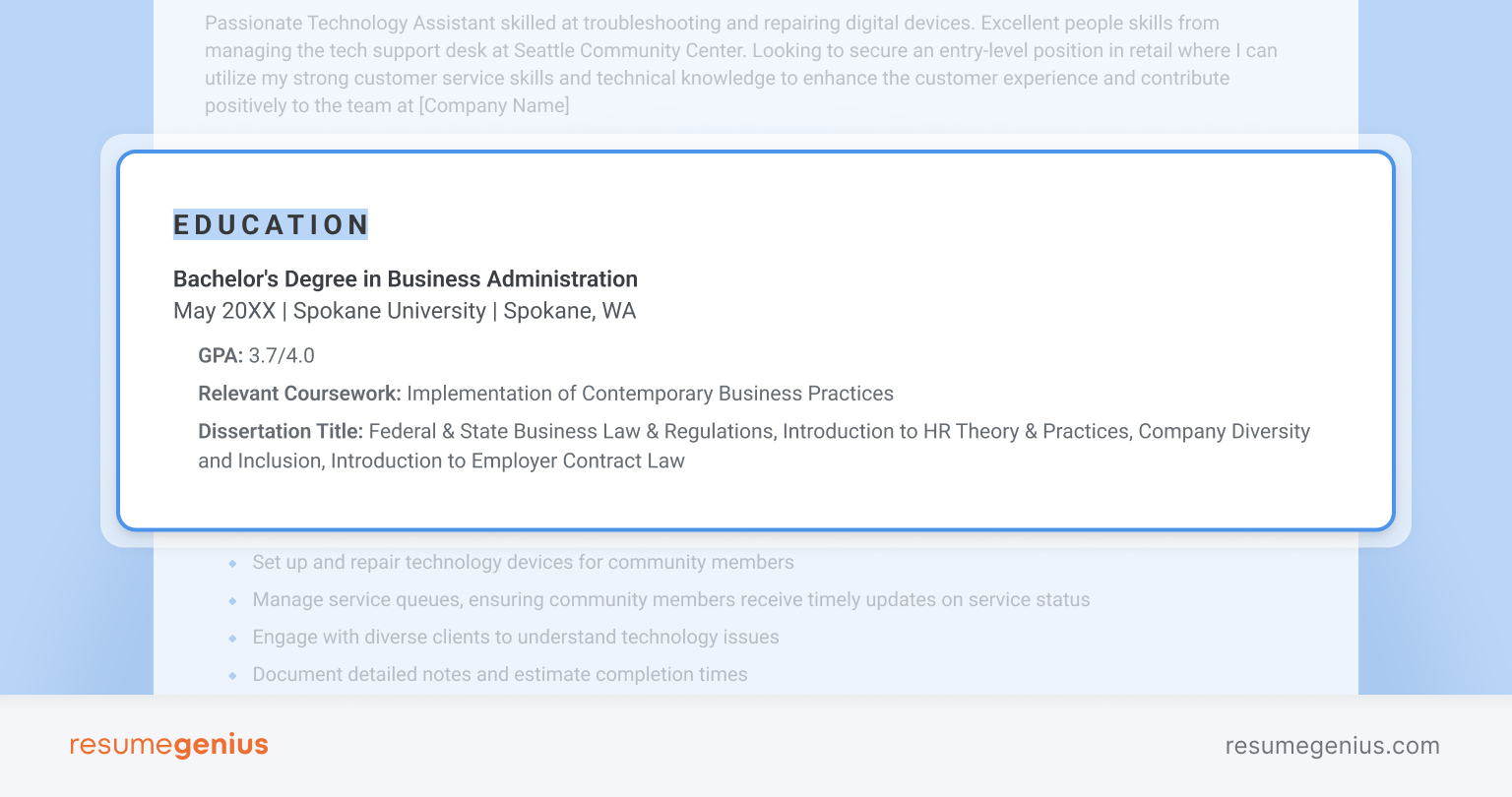
However, the amount of detail you include in your resume’s education section will differ depending on your situation:
- If you haven’t attended college – list your high school or GED, and your graduation date.
- If you’re a college student or recent graduate – list your school, degree, graduation date, GPA (if above 3.5), and any honors you were awarded.
- If you have 2+ years of work experience – just list your school, degree, and graduation date.
- If you have 10+ years of work experience – list your school and degree.
Your education section normally comes after all of your work experience, but you should place it first if you’ve never held a full-time job or you’re writing a student resume because you’ll want extra space to talk about your academic achievements.
Your degree name The name of the college or high school (and its location) – Your graduation date (if it’s within the last 15 years) Your GPA (if higher than 3.5) Latin honors
For teaching jobs in higher education and college applications you need to write an academic CV, which requires that you list all of your degrees, including high school diplomas, bachelor’s degrees, master’s degrees, and PhDs.
8. Add additional relevant information
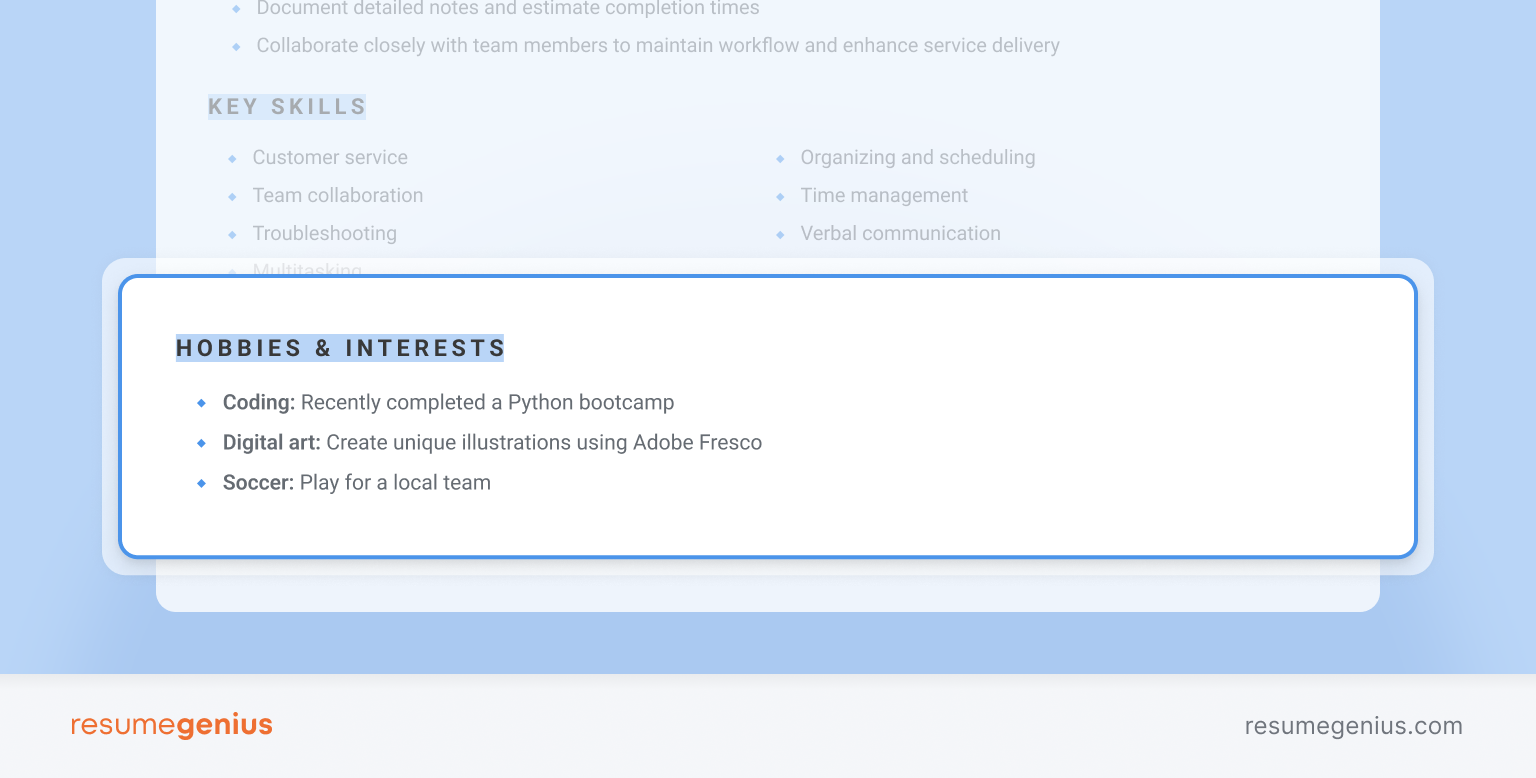
One of the most common additions people make to their resume is a certifications section:
List your certifications
If you’re applying for jobs that require specific certifications to get hired, you should include a section on your resume that clearly highlights those certifications.
For example, if you work in education, medicine, or construction, you likely have more than one professional certification. In these fields, you should add a certifications section to your resume to clearly show employers that you’re qualified.
Other optional sections to put on your resume
Aside from certifications, there are many other optional sections you can add to your resume.
For example, some additional qualifications you could add a section to your resume for include:
- Hobbies and interests
- Extracurriculars
- Publications
- Language skills
- Personal projects
9. Proofread your resume and finish your application
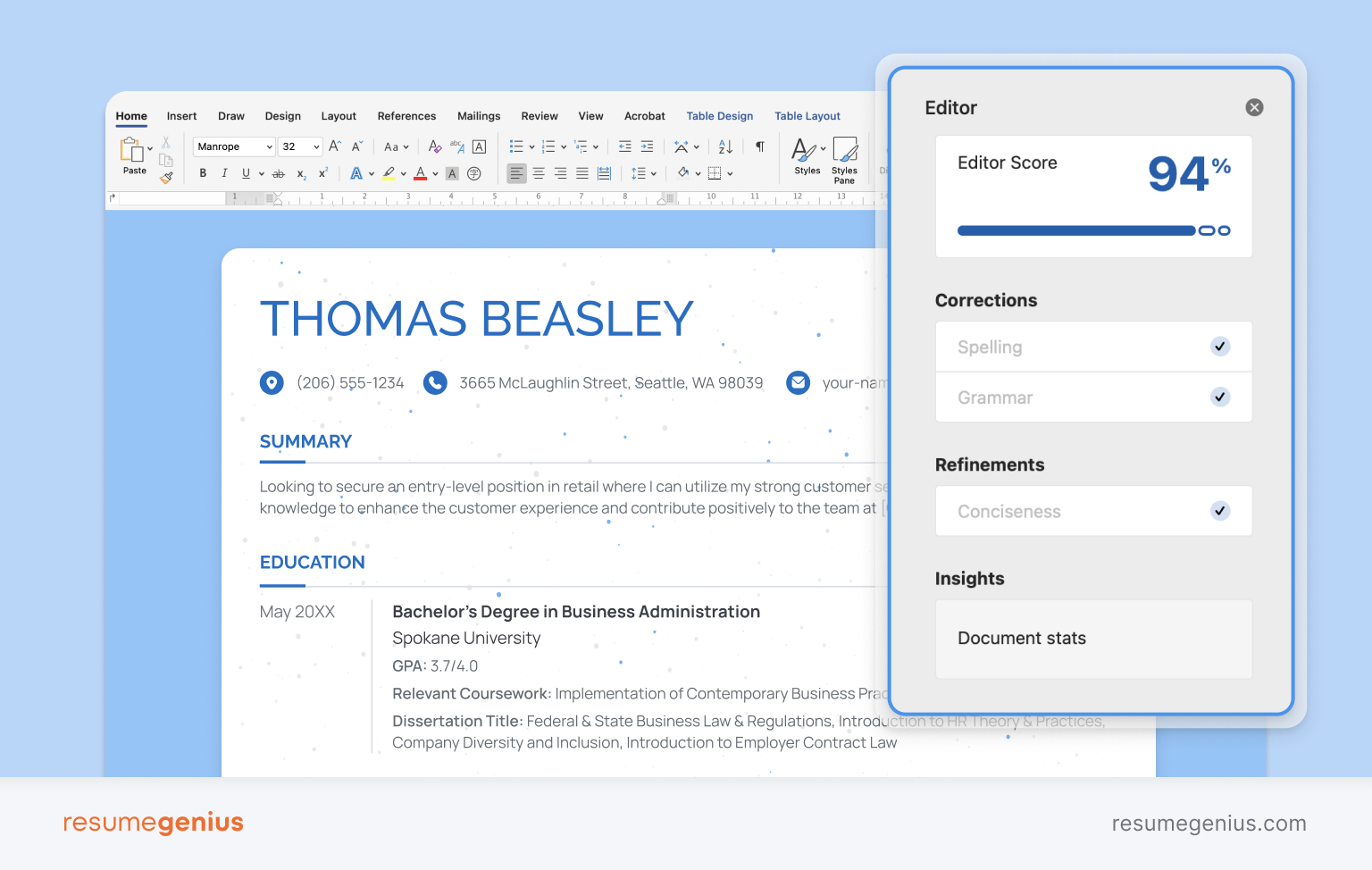
You should also give your resume to a friend or relative to read through so they can help you notice any mistakes on your resume .
Also consider using an AI resume checker to scan your resume for issues outside of grammar and spelling mistakes.
To help make the proofreading process easier, here’s a checklist you can tick as you complete it:
Is your contact information accurate?
Is your email address professional?
Does your resume leave out details like headshots or sensitive personal information?
Does your resume fit on one page (or two pages if you’re highly experienced)?
Is your information easy to read (fonts are above 10pt+ and sections don’t look too crowded)?
Is the design of your resume appropriate for the position you’re applying for?
Did you include all relevant sections on your resume?
Did you quantify achievements in your resume work experience section?
Did you use action verbs to describe your experience?
Does your resume address the requirements stated in the job ad?
Is your resume free of typos and grammatical errors?
Is all of your information clearly formatted and professional?
Feel free to use our on-page checklist, or make a copy in Google Docs and begin reviewing your resume.
Save your resume as a PDF (or Docx)
If the job description doesn’t specify, save your resume as a PDF . PDFs save your formatting even if you use fonts that aren’t installed on the hiring manager’s computer, so they’ll appear exactly as you want them to appear.
Your resume’s file name should be simple and clear and make it easy for the hiring manager to find later. For example, Gloria-Chen-Resume.pdf is a good file name because it contains the applicant’s name and the word “resume.”
Make a matching cover letter
Many jobs request or require that you send in a cover letter along with your resume.
So before you start sending out job applications, make sure you know how to write a compelling cover letter that highlights your strengths as a candidate.
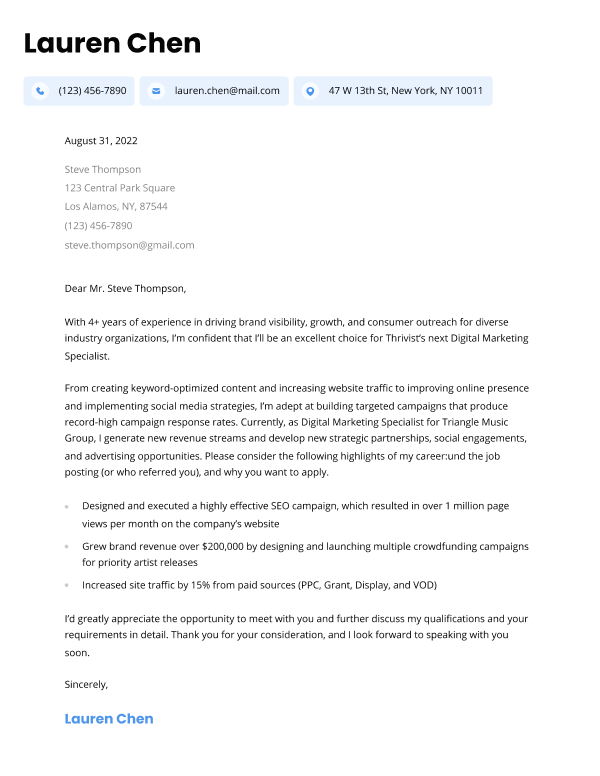
Our free-to-use cover letter builder can make you a cover letter in as little as 5 minutes. Just pick the template you want, and our software will format everything for you.
Your cover letter should use the same design and formatting as your resume, giving your job application a polished, cohesive look.
If you’re not sure how to start your cover letter, look at cover letter examples written by other candidates in your industry.
How to make a resume quick and easy
If you’re short on time or simply don’t like writing, use a resume builder to put together a resume that earns you interviews.
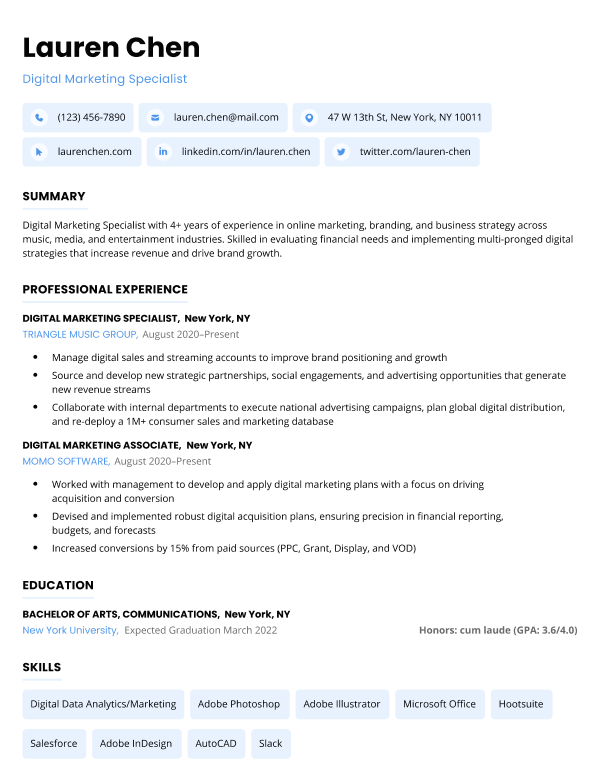
Our free-to-use resume builder can make you a resume in as little as 5 minutes. Just pick the template you want, and our software will format everything for you.
There are plenty of good resume builders online to try out in 2024. Our own AI resume builder helps simplify the process of creating a resume by guiding you through each step and formats all your information for you.
Our software also provides helpful suggestions and fills out parts of your resume like your summary and work experience. At the end of the process, it formats all your information properly, so you end up with a sleek new resume that’s sure to impress hiring managers.
If you plan to use our software to create a cover letter as well, we recommend using the same template to create a visually consistent application.
Tips for making a better resume
Now that you know how to write a great resume, here are some tips for making the process as painless as possible:
You can either write your resume from scratch in Microsoft Word or Google Docs, fill out a template you find online, or use software like a resume builder :
Choose an appropriate design for your resume
The way you design your resume has a huge impact on how employers perceive you, and can make or break or chances of landing a job if you’re not careful.
Your resume design includes all the visual details like:
- the colors used on your resume
- which resume font you pick
- whether or not you use a sidebar
- how you set up your headers
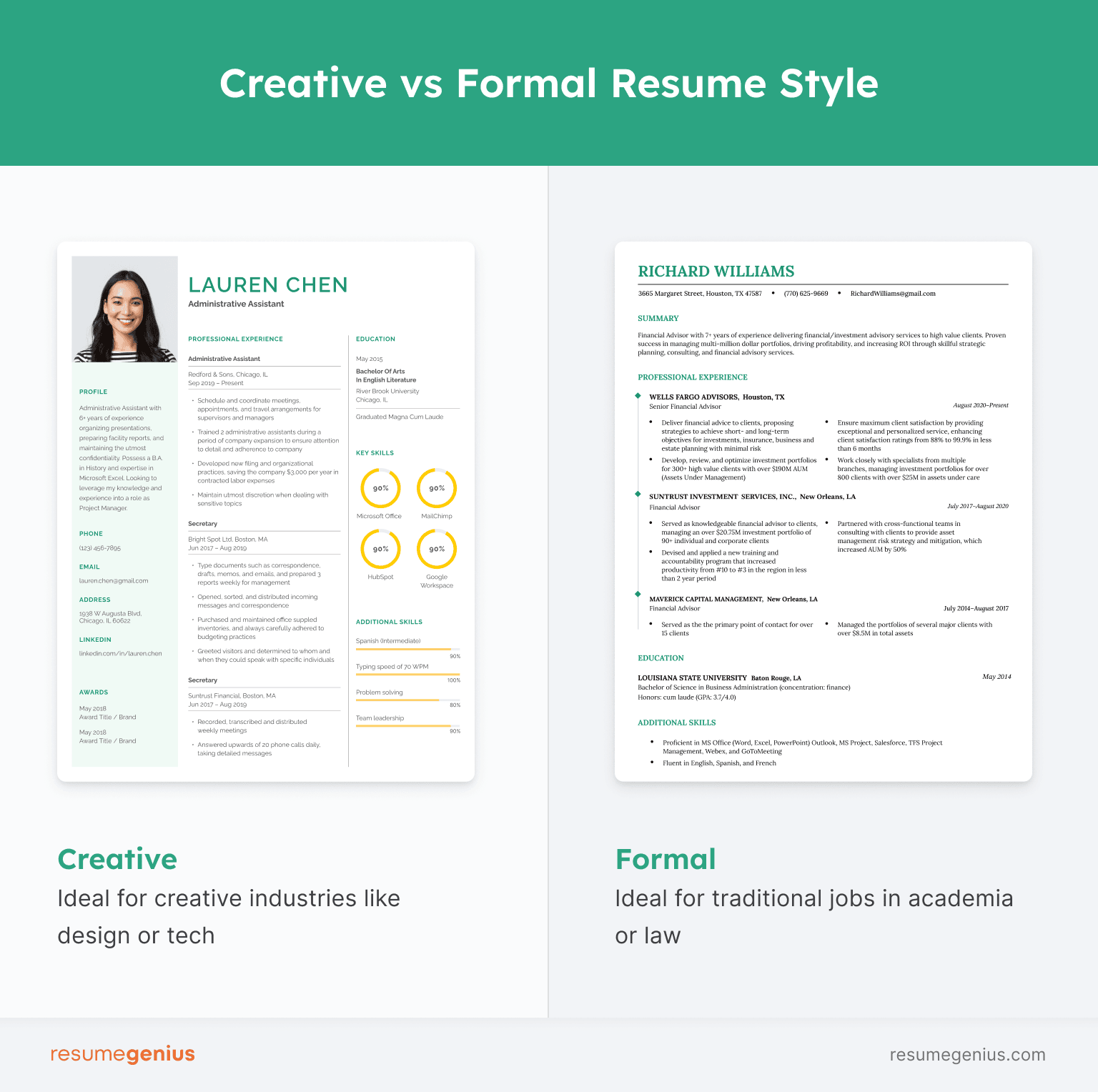
For formal industries like law or finance, stick to a simple, traditional resume style. Simple resume templates with clean lines, no graphics, and dark colors like navy blue or burgundy are most appropriate.
For creative industries like tech or marketing, you should use a more modern design for your resume. Modern resume templates include brighter colors, sans-serif fonts, and graphic details like illustrated skill levels or sidebars.
Use ChatGPT to polish your resume or get suggestions
ChatGPT is a great tool for making your resume, and is becoming more popular with job seekers in all industries.
However, before you rush to make a resume with ChatGPT , it’s important to remember that AI tools aren’t a magic wand. To get the best results from ChatGPT, you need to think carefully about how you structure your prompt, the information you provide, and the limitations of AI software.
The best way to check that your resume meets the standards for your industry is to look at examples written by other people in your field.
Here are two resume examples for different levels of experience to see what a strong, general resume looks like.
Entry-level resume
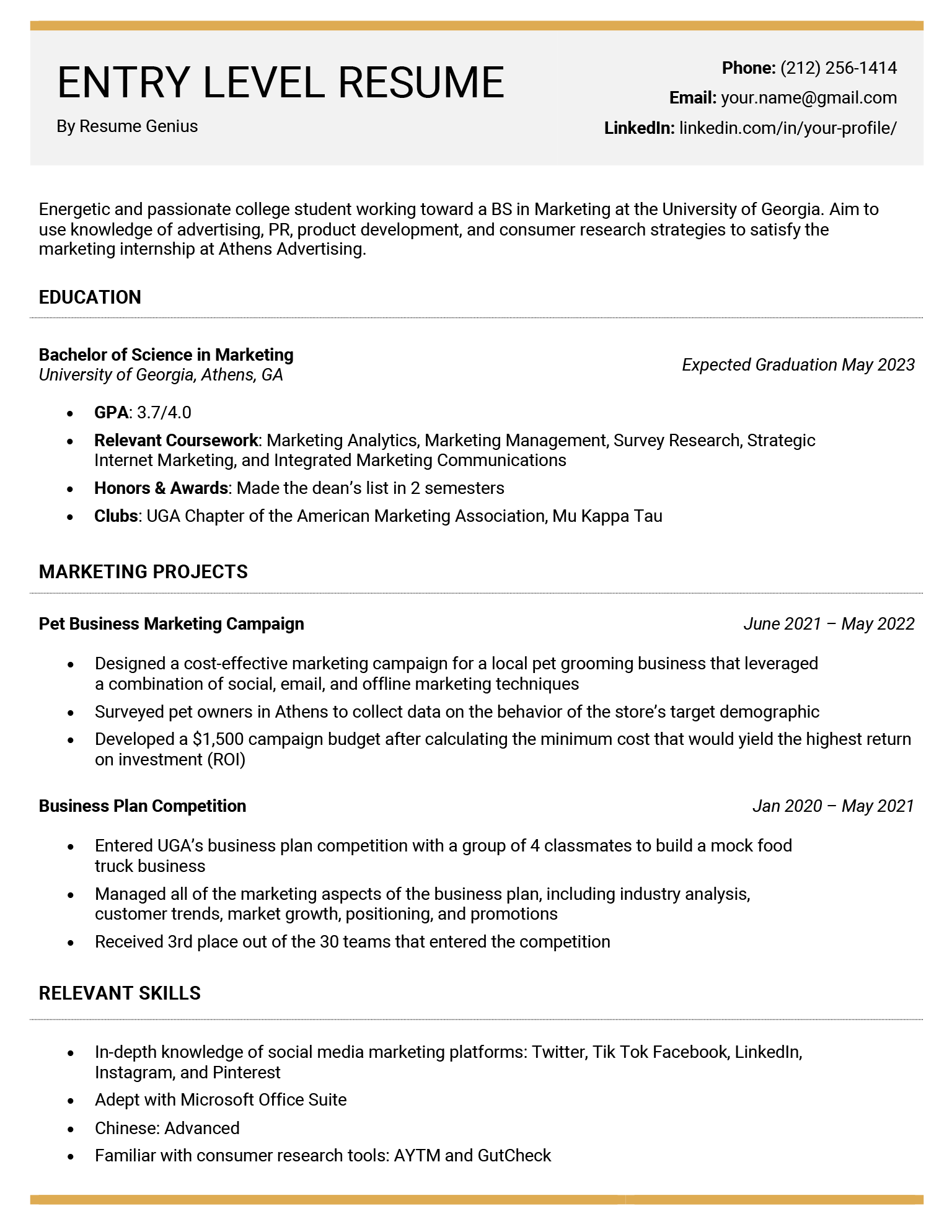
Experienced resume
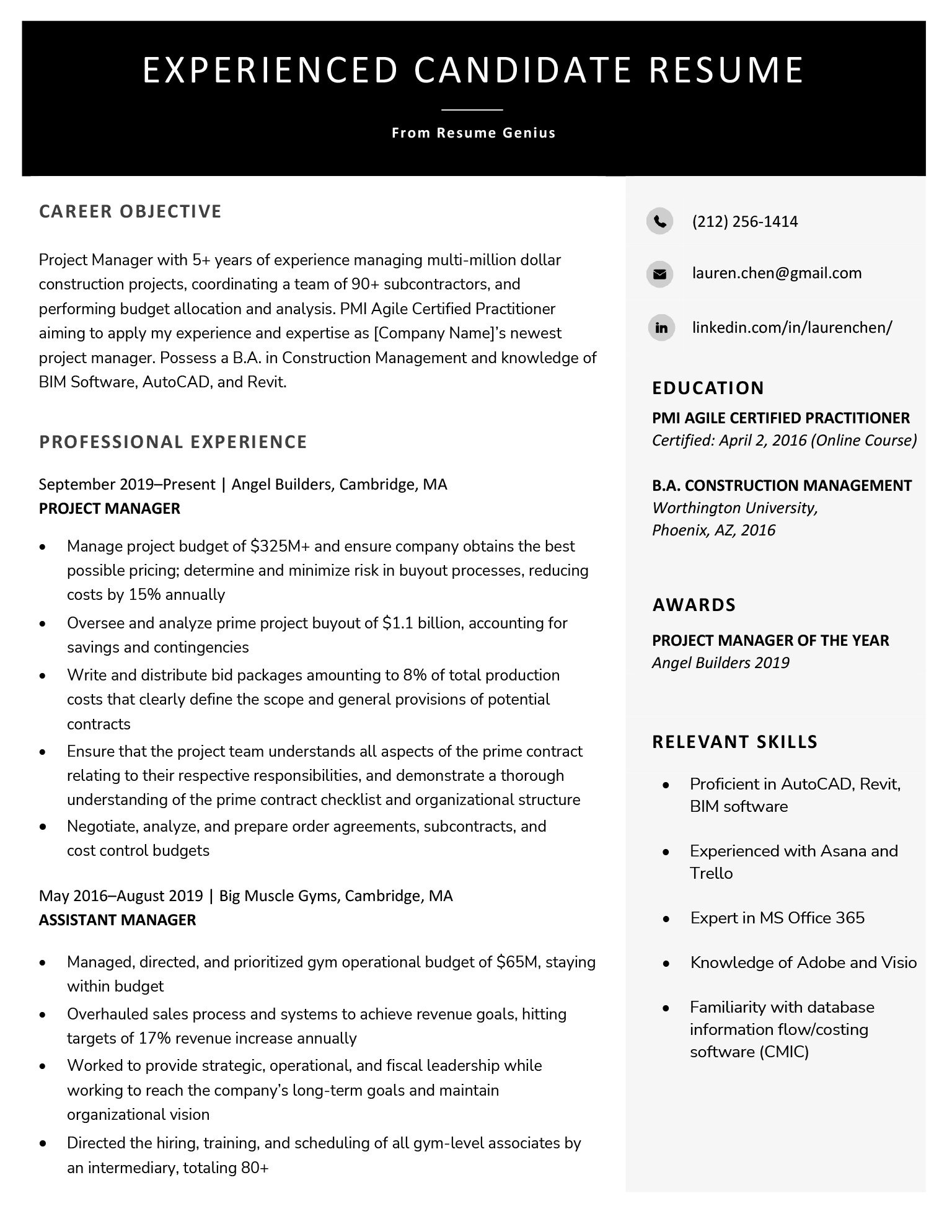
Modern template
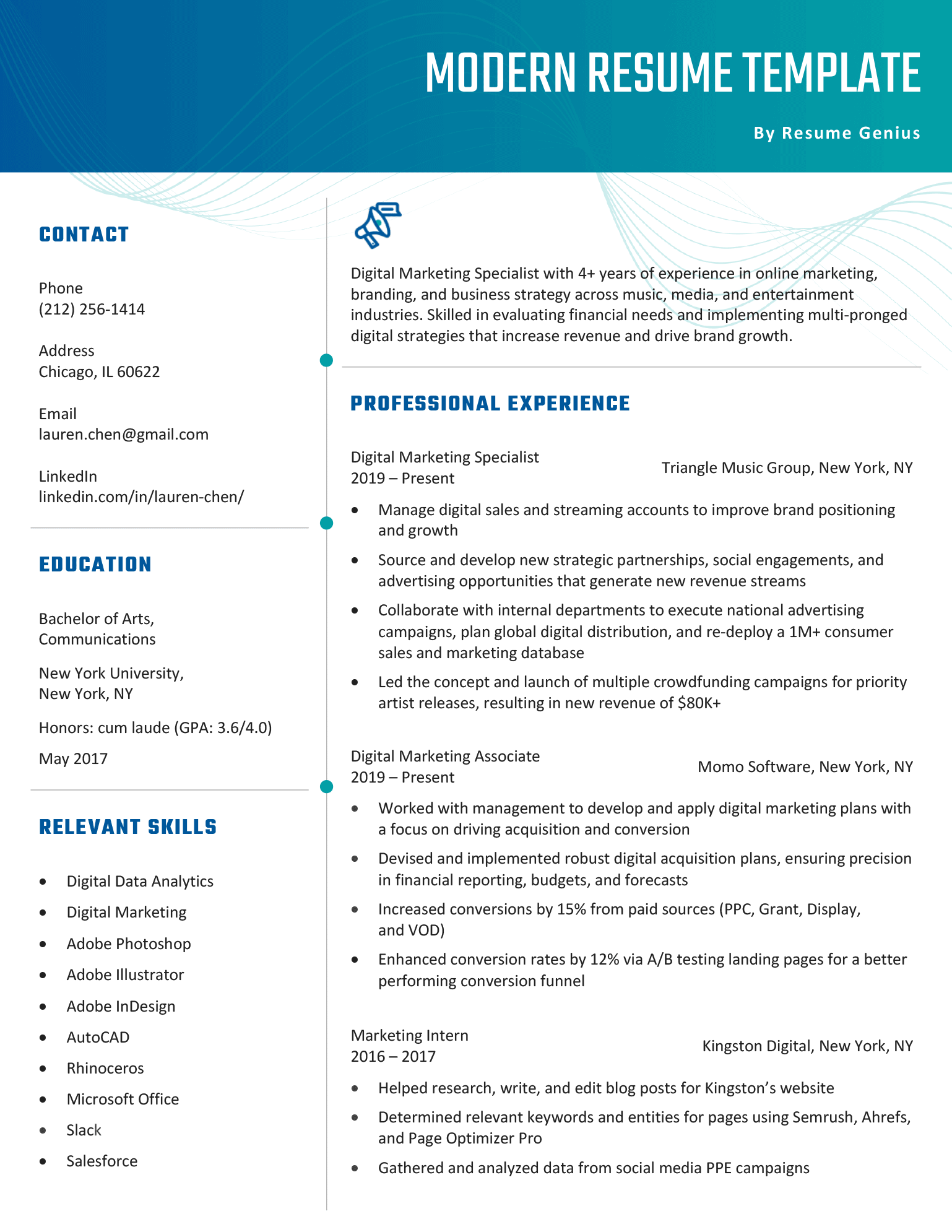
Ideal for jobs in marketing or tech, this modern resume template communicates to employers that you’re forward-thinking and innovative.
Formal template
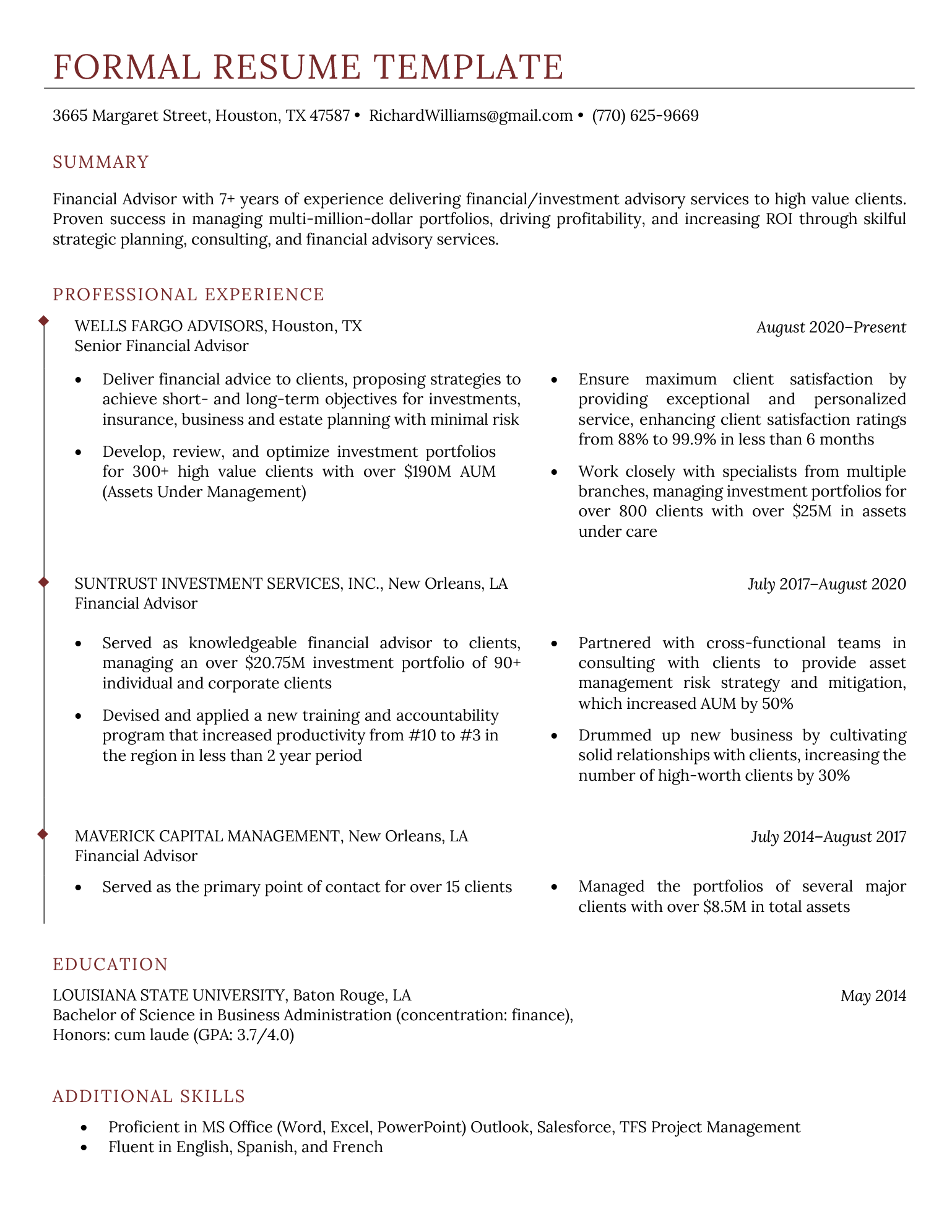
Applying for work in a highly formal industry? This basic resume template is as buttoned-up as it gets. If you’re looking for work in law or finance, this is the perfect template for you.
Creative template
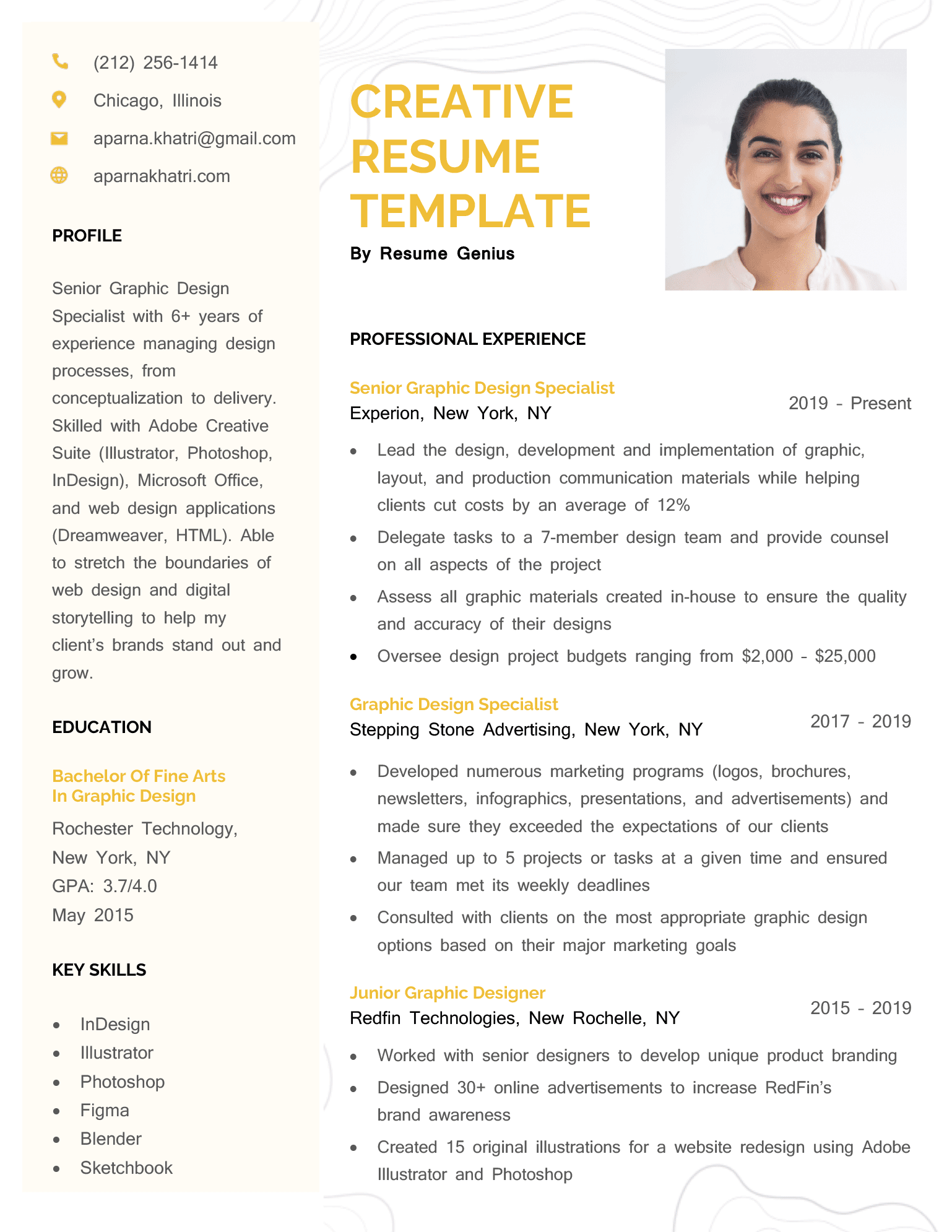
With its bright colors and background illustrations, this creative resume template is a good choice for careers in social media management or design.
While this template includes space for a photo on your resume , we recommend not to do this unless you’re applying for work in a field where your appearance is relevant (like acting or modeling).
Professional template
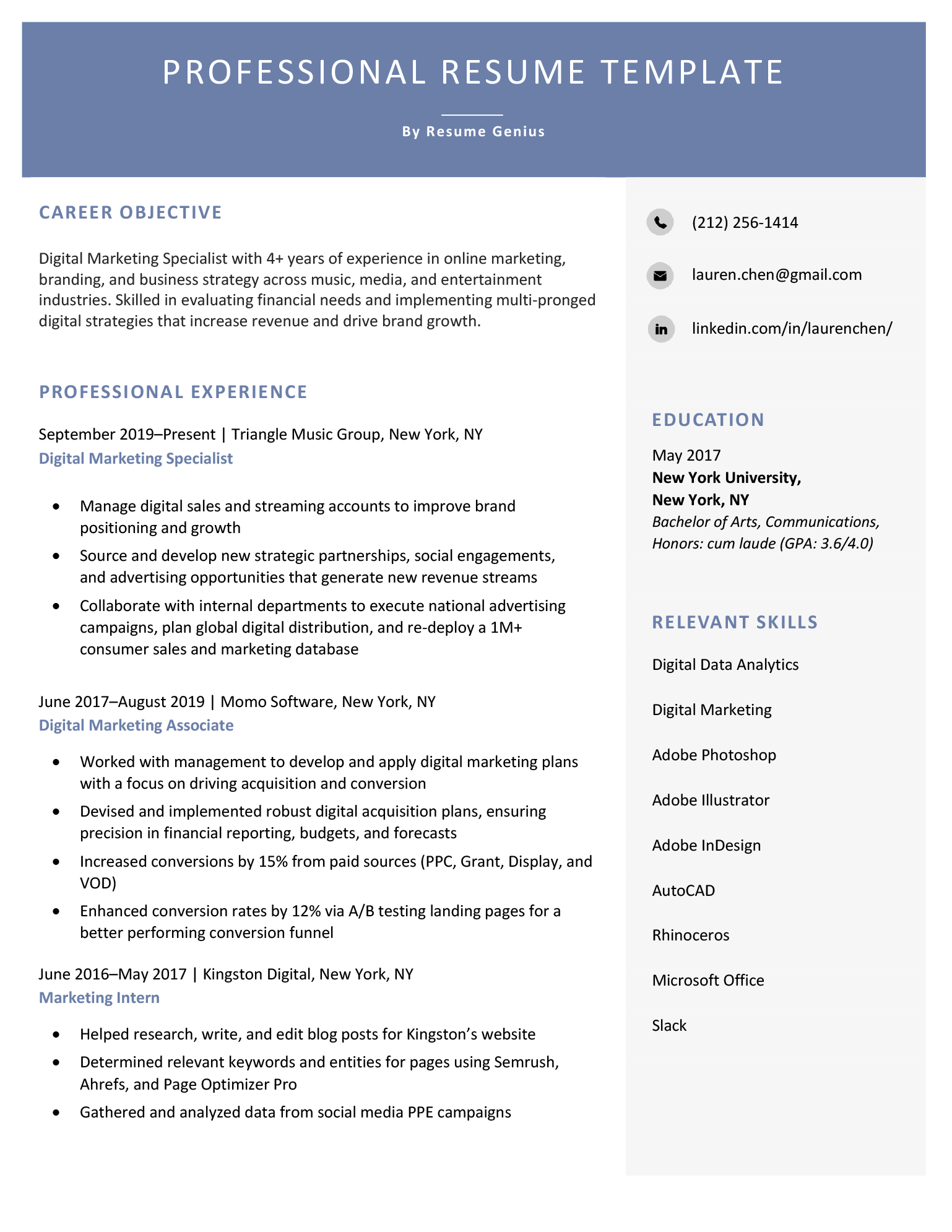
This professional resume template projects confidence, making it a great choice for executives and marketing professionals.
Minimalist template
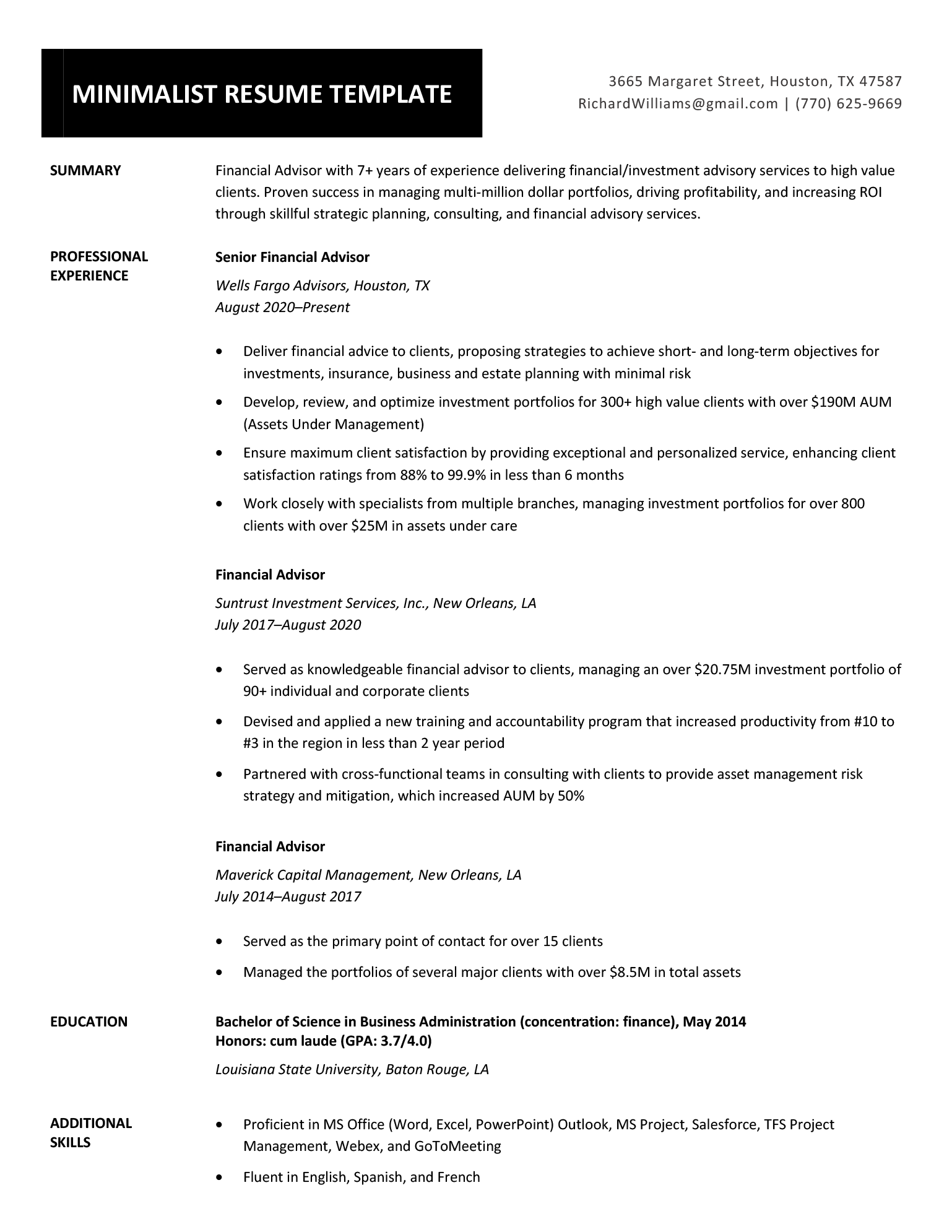
Simple and clean, this minimalist resume template is a safe choice for just about any job because it’s highly formal but still modern-looking.
Additional resume template file types
There are countless resume templates available for a variety of platforms. For example:
- Pages resume templates
- Google Docs resume templates
- Resume templates for Microsoft Word
- LibreOffice and OpenOffice resume templates
More resume writing resources
- Resume guidelines (21 formatting rules)
- How to add military experience to your resume
- How to use buzzwords on your resume
- Top resume writing tips
- How to add job descriptions to your resume
- How to put your GED on your resume
- How to write a resume for an internal position
Still have some unanswered questions? Here are some answers to common questions about writing a resume:
Should I worry about applicant tracking systems?
If you’ve done any research about writing your resume online, you’ve probably seen warnings about how it’s essential to make your resume Applicant Tracking System (ATS) friendly – or else you’ll never land a job!
The fact is, the risk of being rejected from a job by ATS software is overstated . Most hiring managers and recruiters still manually review your resume even if they also use an ATS.
However, it’s true that many larger companies and recruitment firms use ATS software extensively. So depending on where you want to work, you should still follow best practices to make sure your resume is successfully parsed by ATS software to save hiring managers a headache when trying to read your resume.
If you’re worried about your resume being successfully scanned by ATS software, you can use a free resume checker to make sure you won’t run into any problems.
What makes a good resume?
Here’s what makes a good resume:
- A clear, professional layout and design
- Easy-to-identify contact information
- Tailoring each section to the job you’re applying for
- A resume introduction that sums up your key qualifications
- A work experience section that uses action verbs and quantifies your accomplishments
- An education section that highlights your academic achievements
- A skills section that showcases a targeted combination of hard and soft skills
Should I include references on my resume?
No, you shouldn’t include references on your resume . While people used to do this, it’s no longer considered necessary because employers will reach out to you later in the hiring process if they want to hear from your references.
Including a reference section on your resume just uses up valuable space that would be better put to use elaborating on your achievements and skills.
- How many jobs should you list on a resume?
You should list three to four jobs on a resume. As a general rule, you should highlight the last 10-15 years of work experience on your resume, depending on your career level and the job you’re applying for.
If you have a lot of relevant experience that goes back further than this, you can include some additional positions, but it’s not necessary to list every job you’ve ever held.
How do you make a resume for free?
There are a couple of ways to make a resume for free:
- Use word processing software – if you have access to Microsoft Word or Google Docs, you can easily build a resume for free.
- Use a resume template – download a resume template for Google Docs or Word and fill out each section with your information for a professionally designed free resume.
No matter which method you choose, always proofread your resume at the end to make sure it looks professional and there aren’t any mistakes that could hurt your chances of landing a job.
What can I do if I still have questions about making my resume?
If you still have questions about making your resume, here are some additional answers to more specific questions:
- Can I send a resume instead of a CV?
- Is it OK to lie on your resume?
- Is it resume or resumé?
- Can I make a resume on my phone?
- Should I put a job I got fired from on my resume?
- Should I put my resume on LinkedIn?
- Can you say “I” on a resume?
- How bad is a gap on my resume?
- What should you name your resume file?
How to Make a Resume

Conrad Benz, Hiring Manager
Related Articles
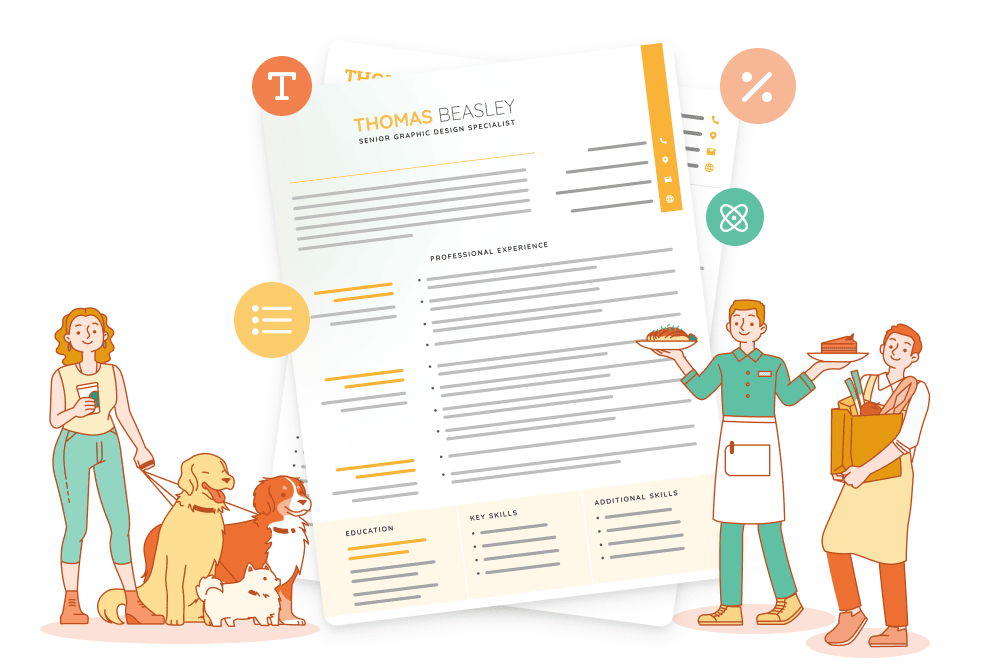
Resume Help

Emily Crowley
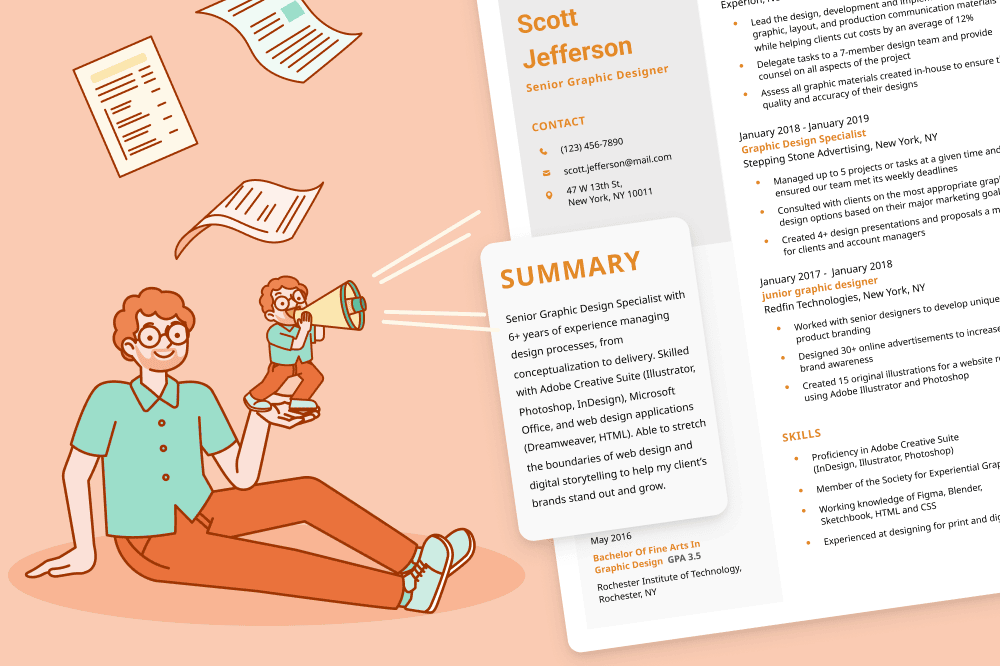
Corissa Peterson, CPRW
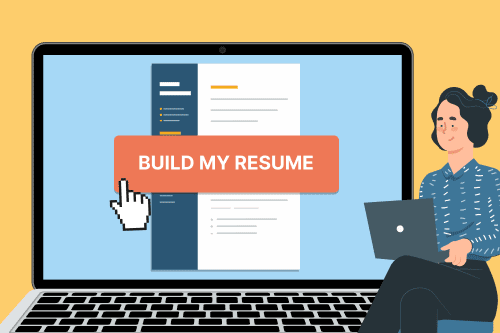

IMAGES
VIDEO
COMMENTS
Failing to provide support for claims. Not optimizing your cover letter with keywords. Repeating information from your resume. Using the wrong tone or style. Failing to include a strong call-to-action in your closing. Forgetting to proofread before submitting your cover letter.
The top of your cover letter should include a designated header where you can input your contact information, such as your full name, email address, phone number, address, and links to any relevant social media. Make sure these details match your resume and double-check for any typos. Company details.
15 Things You Shouldn't Include. What to Include in a Cover Letter. Photo: katleho Seisa / Getty Images. There are some things that should not be included in a cover letter when you apply for a job, review a list, and the reasons why you shouldn't include them.
A great cover letter consists of the following components: 1. Your name and contact information in a header. The hiring manager needs to have your contact information. Without these details, they have no way of inviting you for an interview. The most eye-catching way of adding your contact information to your cover letter is by creating a large ...
Notwithstanding the above, the only time you should submit a cover letter is when you have valuable information to share that's not conveyed in your resume. I've hired many candidates based on ...
1. Personalization. Address the hiring manager or recruiter by name whenever possible. If the job posting doesn't include a name, research to find out who will be reviewing applications. Personalizing your cover letter shows that you've taken the time to tailor your application to the specific company and role. 2.
Step 3: Address your cover letter to the hiring manager—preferably by name. The most traditional way to address a cover letter is to use the person's first and last name, including "Mr." or "Ms." (for example, "Dear Ms. Jane Smith" or just "Dear Ms. Smith").
Here are 9 steps you can take to make sure you're headed in the right direction: Step 1. Do your research. Before writing your cover letter, thoroughly read the job description and the requirements for the job. Melanie Denny, award-winning resume expert, likens the job description to your cover letter cheat sheet.
Papadopoulos suggests decreasing the header space first. Alignment: All your text should be left aligned and there's no need to indent every paragraph. Line spacing: Single space your cover letter (1.15 spacing works if it looks too cramped). Include an extra line between each section and paragraph.
Even if the company doesn't specifically request a cover letter, it's a good idea to write one if you're interested in the role at hand. Skip a cover letter if the employer says not to write one, or if there isn't a place to include one in an online application form.
There are a few key pieces of information to include, while keeping them short and sweet. In fact, a cover letter should only be a couple of paragraphs long, and no more than roughly 100-150 words. A little research goes a long way. Seek out the editor's name, and address the letter to him/her, as opposed to using a generic greeting.
Others have also written about writing a cover letter. Cheryl E. Ball, for example, provides excellent advice and a paragraph-by-paragraph breakdown. Indeed, a simple Google search on "how to write an academic cover letter" brings back 49,600 results if the clause is in quotations, and 526 million results without quotations.
Only 26% of recruiters will "deduct points" from candidates who don't include an optional cover letter, according to a survey conducted by ResumeGo. But many, though not all, hiring professionals still read and consider cover letters. And you don't know what the particular recruiter or hiring manager for this job will do.
To recap the main points of how to write a good cover letter, keep these tips in mind: Write a fresh, custom cover letter for every job you apply to. Keep it to three to four paragraphs under one page. Use your cover letter to expand on details in your resume and tell a story. Ensure your document is free of errors.
1. Begin by introducing yourself. To start your cover letter, introduce yourself. This means including your full name, your specific interest in the position and the reasons you've chosen to apply. If you got a referral to the job from another party, ensure to mention this in the first paragraph. 2.
For instance, if you're applying for a content writing role, you might discuss a time when you wrote a well-received research paper or a blog post. 6. Show your passion: Passion can often make up for a lack of experience. If you're passionate about writing, make sure that comes across in your cover letter. 7.
4. A word count. This is a simple and necessary inclusion to let publishers know how long your novel is. 5. A killer author bio. Be interesting, be readable and draw publishers in with who you are and what you intend to do with your work. Here is also the place to list existing publishing credentials, and relevant education such as writing ...
A cover letter should never be a reiteration of a resume or CV. Its purpose is to introduce you in a personal way as well as provide a broader context for your qualifications and achievements. Unless the job ad asks you to not send a cover letter, you should always attach one. A good cover letter can help the hiring manager see your worth.
Cover letters aren't required with every application, but the majority of managers pay more attention to a candidate who includes a cover letter. This is especially so if you make an effort to tailor your letter to the specific position. It's important not to just change the names and job positions, but also to show how your professional experience fits with the job.
If you aren't a strong writer: Lyons recommends forgoing a cover letter if you aren't a good writer and don't have anyone to help you. "The cover letter could be your first impression, and a badly ...
1. Check the company and job description. The first step in crafting a well-written cover letter is to research the company where you want to work. Carefully review what the organization shares about its values and culture on social media or its website to understand how you can relate to it in your letter.
How to write a cover letter for a job application that stands out. A cover letter sample that will get you more interviews. How to write a cover letter for different types of jobs. A full step-by-step guide to writing a cover letter quickly and painlessly; Save hours of work and get a cover letter like this. Pick a template, fill it in. Quick ...
Postage for letters mostly depends on weight and size/shape. You can weigh your letter with a kitchen scale, postal scale, at a self-service kiosk, or at the Post Office ™ counter. TIP: As a rule of thumb, you can send 1 oz (4 sheets of printer paper and a business-sized envelope) for 1 First-Class Mail ® Forever ® stamp (currently $0.68). The postage for a large envelope (or flat) starts ...
The Purdue On-Campus Writing Lab and Purdue Online Writing Lab assist clients in their development as writers—no matter what their skill level—with on-campus consultations, online participation, and community engagement. The Purdue Writing Lab serves the Purdue, West Lafayette, campus and coordinates with local literacy initiatives.
You should include one to two small body paragraphs to expand on your previous experiences and how they could benefit an employer. Here is an example of one cover letter body paragraph: "I worked as a marketing coordinator for a large retail corporation for three years. There, I learned about email marketing campaigns and how to structure images with copy and subject lines to encourage ...
Our free-to-use cover letter builder can make you a cover letter in as little as 5 minutes. Just pick the template you want, and our software will format everything for you. Your cover letter should use the same design and formatting as your resume, giving your job application a polished, cohesive look.